Demonstrate Knowledge of Theory in Relation to Management in Organizations
VerifiedAdded on 2023/05/28
|48
|12122
|300
AI Summary
This essay discusses different management theories, including classical, behavioural, and modern management. It covers organizational structure, motivation, and leadership styles. The strengths and weaknesses of each theory are analyzed. The essay concludes by comparing leadership and management aspects.
Contribute Materials
Your contribution can guide someone’s learning journey. Share your
documents today.
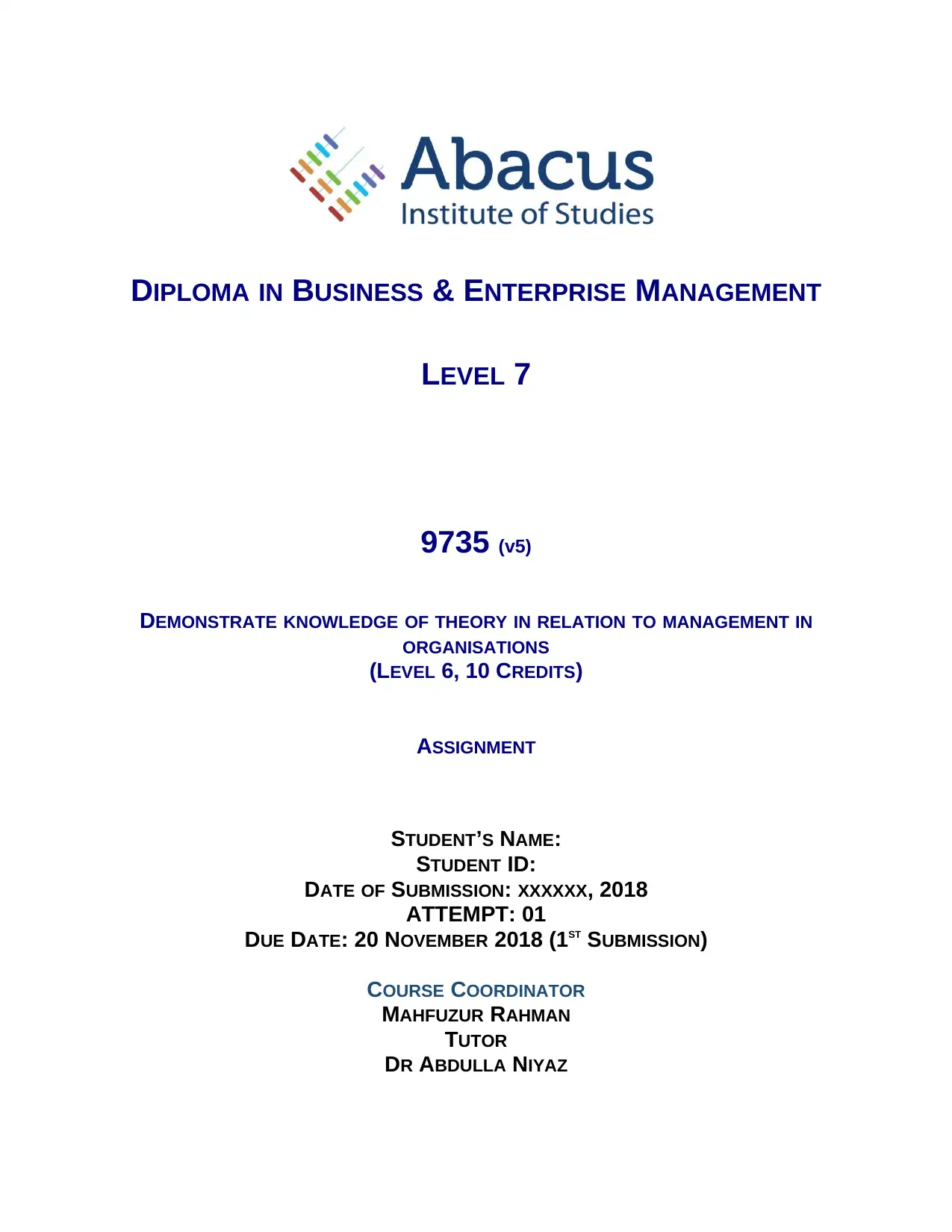
DIPLOMA IN BUSINESS & ENTERPRISE MANAGEMENT
LEVEL 7
9735 (v5)
DEMONSTRATE KNOWLEDGE OF THEORY IN RELATION TO MANAGEMENT IN
ORGANISATIONS
(LEVEL 6, 10 CREDITS)
ASSIGNMENT
STUDENT’S NAME:
STUDENT ID:
DATE OF SUBMISSION: XXXXXX, 2018
ATTEMPT: 01
DUE DATE: 20 NOVEMBER 2018 (1ST SUBMISSION)
COURSE COORDINATOR
MAHFUZUR RAHMAN
TUTOR
DR ABDULLA NIYAZ
LEVEL 7
9735 (v5)
DEMONSTRATE KNOWLEDGE OF THEORY IN RELATION TO MANAGEMENT IN
ORGANISATIONS
(LEVEL 6, 10 CREDITS)
ASSIGNMENT
STUDENT’S NAME:
STUDENT ID:
DATE OF SUBMISSION: XXXXXX, 2018
ATTEMPT: 01
DUE DATE: 20 NOVEMBER 2018 (1ST SUBMISSION)
COURSE COORDINATOR
MAHFUZUR RAHMAN
TUTOR
DR ABDULLA NIYAZ
Secure Best Marks with AI Grader
Need help grading? Try our AI Grader for instant feedback on your assignments.

Abstract
The essay has helped in expressing the different Knowledge regarding the different management
related factors in the company which is inclusive of the various information on leadership,
motivation and leadership. The management part has been described in such a manner which will
be beneficial for behavioural, modern and classical with the strengths and weaknesses. The
structure of the organization along with the powerful influences was also presented in the essay
with the effect of the same on the business.
The motivation aspects have been analysed such as the different Maslow's hierarchy theory and
the ERG theory which will be beneficial for examining the needs of the individuals effectively.
The leadership styles such as autocratic and laissez-faire leadership styles have been analysed
with the effect of the same on the current business. In the end, the leadership aspects are being
compared with the management aspects which helps in indicating the change in the current
organization effectively.
The essay has helped in expressing the different Knowledge regarding the different management
related factors in the company which is inclusive of the various information on leadership,
motivation and leadership. The management part has been described in such a manner which will
be beneficial for behavioural, modern and classical with the strengths and weaknesses. The
structure of the organization along with the powerful influences was also presented in the essay
with the effect of the same on the business.
The motivation aspects have been analysed such as the different Maslow's hierarchy theory and
the ERG theory which will be beneficial for examining the needs of the individuals effectively.
The leadership styles such as autocratic and laissez-faire leadership styles have been analysed
with the effect of the same on the current business. In the end, the leadership aspects are being
compared with the management aspects which helps in indicating the change in the current
organization effectively.
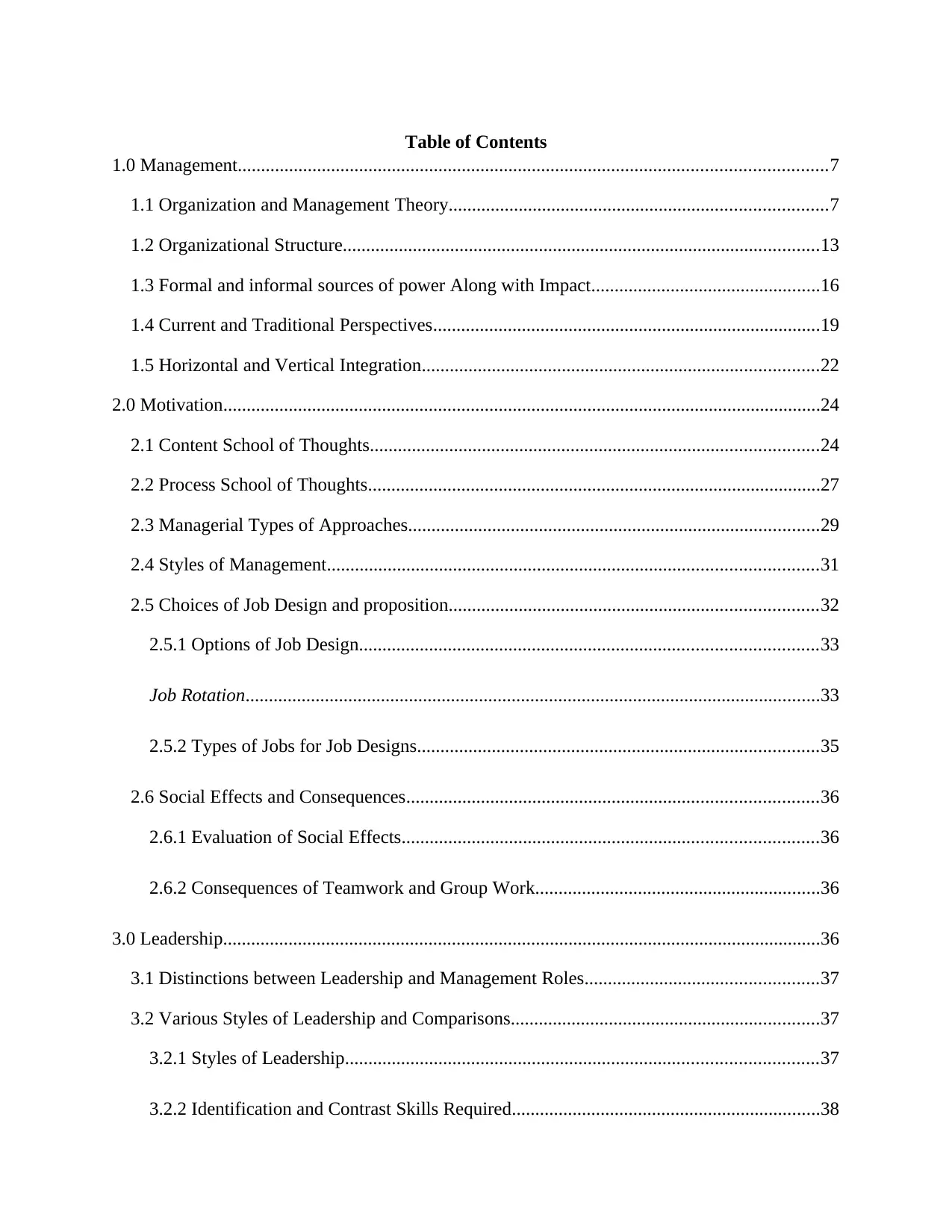
Table of Contents
1.0 Management..............................................................................................................................7
1.1 Organization and Management Theory.................................................................................7
1.2 Organizational Structure......................................................................................................13
1.3 Formal and informal sources of power Along with Impact.................................................16
1.4 Current and Traditional Perspectives...................................................................................19
1.5 Horizontal and Vertical Integration.....................................................................................22
2.0 Motivation................................................................................................................................24
2.1 Content School of Thoughts................................................................................................24
2.2 Process School of Thoughts.................................................................................................27
2.3 Managerial Types of Approaches........................................................................................29
2.4 Styles of Management.........................................................................................................31
2.5 Choices of Job Design and proposition...............................................................................32
2.5.1 Options of Job Design..................................................................................................33
Job Rotation...........................................................................................................................33
2.5.2 Types of Jobs for Job Designs......................................................................................35
2.6 Social Effects and Consequences........................................................................................36
2.6.1 Evaluation of Social Effects.........................................................................................36
2.6.2 Consequences of Teamwork and Group Work.............................................................36
3.0 Leadership................................................................................................................................36
3.1 Distinctions between Leadership and Management Roles..................................................37
3.2 Various Styles of Leadership and Comparisons..................................................................37
3.2.1 Styles of Leadership.....................................................................................................37
3.2.2 Identification and Contrast Skills Required..................................................................38
1.0 Management..............................................................................................................................7
1.1 Organization and Management Theory.................................................................................7
1.2 Organizational Structure......................................................................................................13
1.3 Formal and informal sources of power Along with Impact.................................................16
1.4 Current and Traditional Perspectives...................................................................................19
1.5 Horizontal and Vertical Integration.....................................................................................22
2.0 Motivation................................................................................................................................24
2.1 Content School of Thoughts................................................................................................24
2.2 Process School of Thoughts.................................................................................................27
2.3 Managerial Types of Approaches........................................................................................29
2.4 Styles of Management.........................................................................................................31
2.5 Choices of Job Design and proposition...............................................................................32
2.5.1 Options of Job Design..................................................................................................33
Job Rotation...........................................................................................................................33
2.5.2 Types of Jobs for Job Designs......................................................................................35
2.6 Social Effects and Consequences........................................................................................36
2.6.1 Evaluation of Social Effects.........................................................................................36
2.6.2 Consequences of Teamwork and Group Work.............................................................36
3.0 Leadership................................................................................................................................36
3.1 Distinctions between Leadership and Management Roles..................................................37
3.2 Various Styles of Leadership and Comparisons..................................................................37
3.2.1 Styles of Leadership.....................................................................................................37
3.2.2 Identification and Contrast Skills Required..................................................................38
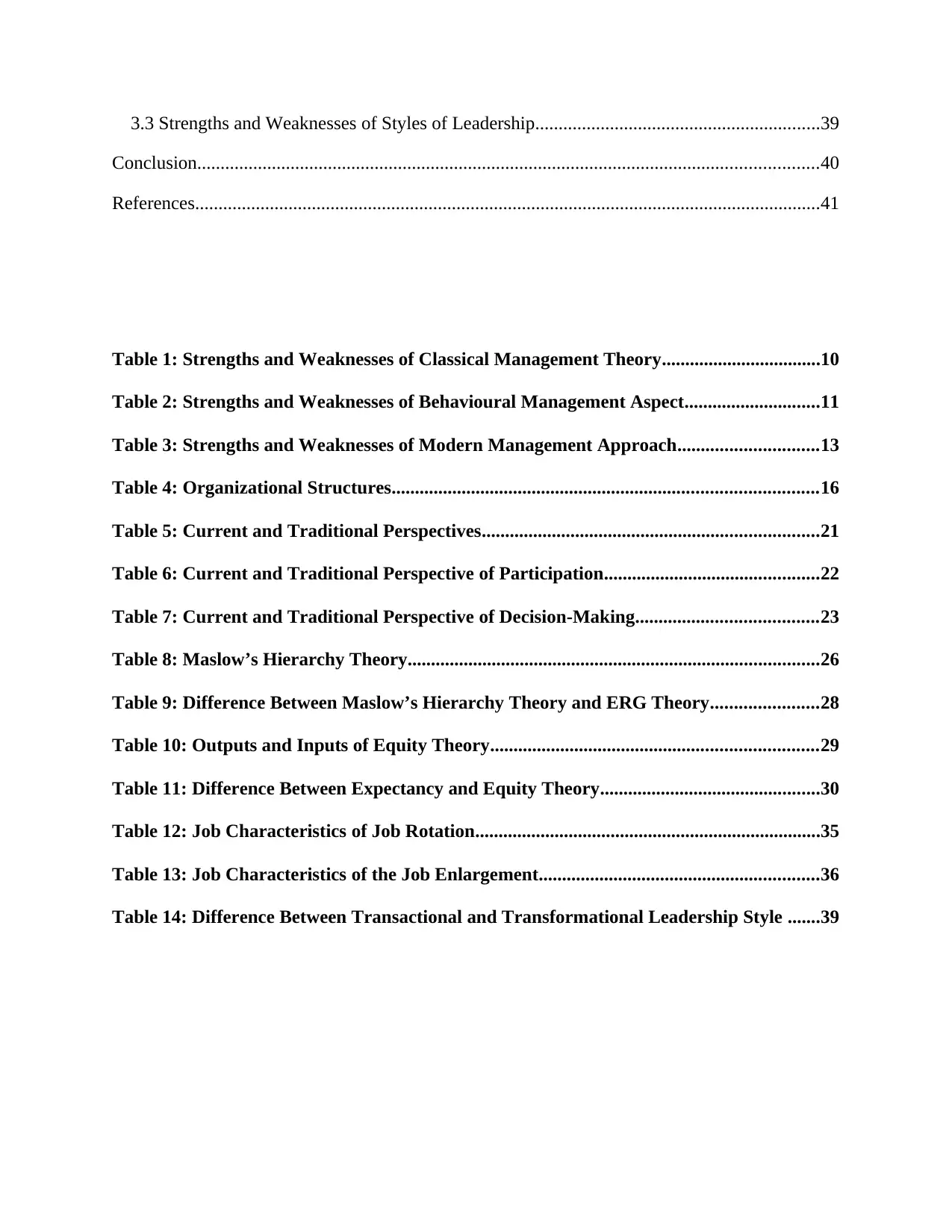
3.3 Strengths and Weaknesses of Styles of Leadership.............................................................39
Conclusion.....................................................................................................................................40
References......................................................................................................................................41
Table 1: Strengths and Weaknesses of Classical Management Theory..................................10
Table 2: Strengths and Weaknesses of Behavioural Management Aspect.............................11
Table 3: Strengths and Weaknesses of Modern Management Approach..............................13
Table 4: Organizational Structures...........................................................................................16
Table 5: Current and Traditional Perspectives........................................................................21
Table 6: Current and Traditional Perspective of Participation..............................................22
Table 7: Current and Traditional Perspective of Decision-Making.......................................23
Table 8: Maslow’s Hierarchy Theory........................................................................................26
Table 9: Difference Between Maslow’s Hierarchy Theory and ERG Theory.......................28
Table 10: Outputs and Inputs of Equity Theory......................................................................29
Table 11: Difference Between Expectancy and Equity Theory...............................................30
Table 12: Job Characteristics of Job Rotation..........................................................................35
Table 13: Job Characteristics of the Job Enlargement............................................................36
Table 14: Difference Between Transactional and Transformational Leadership Style .......39
Conclusion.....................................................................................................................................40
References......................................................................................................................................41
Table 1: Strengths and Weaknesses of Classical Management Theory..................................10
Table 2: Strengths and Weaknesses of Behavioural Management Aspect.............................11
Table 3: Strengths and Weaknesses of Modern Management Approach..............................13
Table 4: Organizational Structures...........................................................................................16
Table 5: Current and Traditional Perspectives........................................................................21
Table 6: Current and Traditional Perspective of Participation..............................................22
Table 7: Current and Traditional Perspective of Decision-Making.......................................23
Table 8: Maslow’s Hierarchy Theory........................................................................................26
Table 9: Difference Between Maslow’s Hierarchy Theory and ERG Theory.......................28
Table 10: Outputs and Inputs of Equity Theory......................................................................29
Table 11: Difference Between Expectancy and Equity Theory...............................................30
Table 12: Job Characteristics of Job Rotation..........................................................................35
Table 13: Job Characteristics of the Job Enlargement............................................................36
Table 14: Difference Between Transactional and Transformational Leadership Style .......39
Secure Best Marks with AI Grader
Need help grading? Try our AI Grader for instant feedback on your assignments.
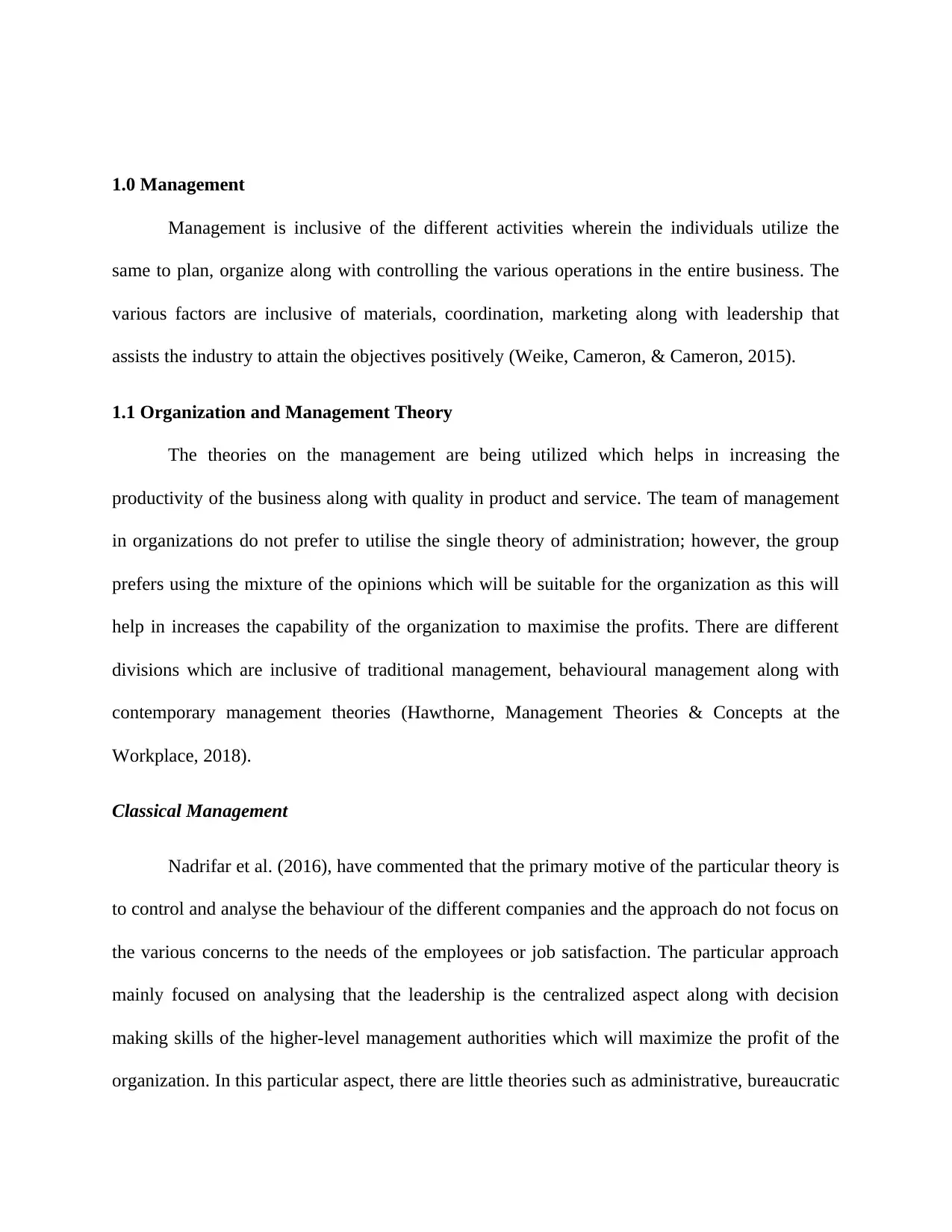
1.0 Management
Management is inclusive of the different activities wherein the individuals utilize the
same to plan, organize along with controlling the various operations in the entire business. The
various factors are inclusive of materials, coordination, marketing along with leadership that
assists the industry to attain the objectives positively (Weike, Cameron, & Cameron, 2015).
1.1 Organization and Management Theory
The theories on the management are being utilized which helps in increasing the
productivity of the business along with quality in product and service. The team of management
in organizations do not prefer to utilise the single theory of administration; however, the group
prefers using the mixture of the opinions which will be suitable for the organization as this will
help in increases the capability of the organization to maximise the profits. There are different
divisions which are inclusive of traditional management, behavioural management along with
contemporary management theories (Hawthorne, Management Theories & Concepts at the
Workplace, 2018).
Classical Management
Nadrifar et al. (2016), have commented that the primary motive of the particular theory is
to control and analyse the behaviour of the different companies and the approach do not focus on
the various concerns to the needs of the employees or job satisfaction. The particular approach
mainly focused on analysing that the leadership is the centralized aspect along with decision
making skills of the higher-level management authorities which will maximize the profit of the
organization. In this particular aspect, there are little theories such as administrative, bureaucratic
Management is inclusive of the different activities wherein the individuals utilize the
same to plan, organize along with controlling the various operations in the entire business. The
various factors are inclusive of materials, coordination, marketing along with leadership that
assists the industry to attain the objectives positively (Weike, Cameron, & Cameron, 2015).
1.1 Organization and Management Theory
The theories on the management are being utilized which helps in increasing the
productivity of the business along with quality in product and service. The team of management
in organizations do not prefer to utilise the single theory of administration; however, the group
prefers using the mixture of the opinions which will be suitable for the organization as this will
help in increases the capability of the organization to maximise the profits. There are different
divisions which are inclusive of traditional management, behavioural management along with
contemporary management theories (Hawthorne, Management Theories & Concepts at the
Workplace, 2018).
Classical Management
Nadrifar et al. (2016), have commented that the primary motive of the particular theory is
to control and analyse the behaviour of the different companies and the approach do not focus on
the various concerns to the needs of the employees or job satisfaction. The particular approach
mainly focused on analysing that the leadership is the centralized aspect along with decision
making skills of the higher-level management authorities which will maximize the profit of the
organization. In this particular aspect, there are little theories such as administrative, bureaucratic

along with scientific methods. From the respective table, the proper identification of the
strengths along with weaknesses is being discussed from Nadrifar and the colleagues (Nadrifar,
Bandani, & Shahryar, 2016).
Strengths Weaknesses
The particular theory is hierarchical wherein
there are different levels of commands. The
top management officials take care of the
different goals, develop the different
policies along with supervising the activities
effectively
The different complex kinds of projects are
made simpler by breaking them into simple
ones who will be easier for the employees to
perform them effectively
The top officials are responsible for creating
the centralised decisions and deliver it to the
lower level management officials. This
helps the different employees in following
the different policies effectively
There are various monetary incentives
which will be effectively motivating the
individuals, and the employees perform
The three types of command which are
being analysed are not sufficient in the
broad kind of business
The social necessities and job satisfaction
are not taken into consideration
The employees working in the organization
are being controlled by the top management
strictly which will beneficial for the
company. However, this decreases the
morale of the employees
The entire system is complex, and this does
not give proper information
The theory does not encourage the creative
type of ideas of the employees at the
different decisions are being taken from the
higher-level managers
The employees are exploited, and they are
forced to work as per the rules and
strengths along with weaknesses is being discussed from Nadrifar and the colleagues (Nadrifar,
Bandani, & Shahryar, 2016).
Strengths Weaknesses
The particular theory is hierarchical wherein
there are different levels of commands. The
top management officials take care of the
different goals, develop the different
policies along with supervising the activities
effectively
The different complex kinds of projects are
made simpler by breaking them into simple
ones who will be easier for the employees to
perform them effectively
The top officials are responsible for creating
the centralised decisions and deliver it to the
lower level management officials. This
helps the different employees in following
the different policies effectively
There are various monetary incentives
which will be effectively motivating the
individuals, and the employees perform
The three types of command which are
being analysed are not sufficient in the
broad kind of business
The social necessities and job satisfaction
are not taken into consideration
The employees working in the organization
are being controlled by the top management
strictly which will beneficial for the
company. However, this decreases the
morale of the employees
The entire system is complex, and this does
not give proper information
The theory does not encourage the creative
type of ideas of the employees at the
different decisions are being taken from the
higher-level managers
The employees are exploited, and they are
forced to work as per the rules and

more efficiently to receive the rewards
The classical theory mainly focuses on the
autocratic kind of leadership in which the
decisions are being made more efficiently,
and this is suitable for the businesses which
are small
The theory will help in maximising the
profit as the main focus on the efficiency
and benefits provided from the work
regulations provided by the top officials
Table 1: Strengths and Weaknesses of Classical Management Theory
(Source: Nadrifar, Bandani, & Shahryar, 2016)
From the table, this can be analysed that the significant contribution of the traditional
management aspect is that this notices that all the different processes which are being used in the
organization are being defined clearly along with the division of the labour. It was being founded
by Adam Smith who was the Scottish economist that in factories the division of the work is
being utilized in which the workers are being provided with few tasks, and the main
concentration is on those tasks which increased the overall productivity of the organization
positively. To manage the entire process in the business, this is efficient that the leaders are
required to have strong skills of communication which will be helpful for making the right
decisions for the company in a proper manner (Nadrifar, Bandani, & Shahryar, 2016).
Behavioural Management
The classical theory mainly focuses on the
autocratic kind of leadership in which the
decisions are being made more efficiently,
and this is suitable for the businesses which
are small
The theory will help in maximising the
profit as the main focus on the efficiency
and benefits provided from the work
regulations provided by the top officials
Table 1: Strengths and Weaknesses of Classical Management Theory
(Source: Nadrifar, Bandani, & Shahryar, 2016)
From the table, this can be analysed that the significant contribution of the traditional
management aspect is that this notices that all the different processes which are being used in the
organization are being defined clearly along with the division of the labour. It was being founded
by Adam Smith who was the Scottish economist that in factories the division of the work is
being utilized in which the workers are being provided with few tasks, and the main
concentration is on those tasks which increased the overall productivity of the organization
positively. To manage the entire process in the business, this is efficient that the leaders are
required to have strong skills of communication which will be helpful for making the right
decisions for the company in a proper manner (Nadrifar, Bandani, & Shahryar, 2016).
Behavioural Management
Paraphrase This Document
Need a fresh take? Get an instant paraphrase of this document with our AI Paraphraser
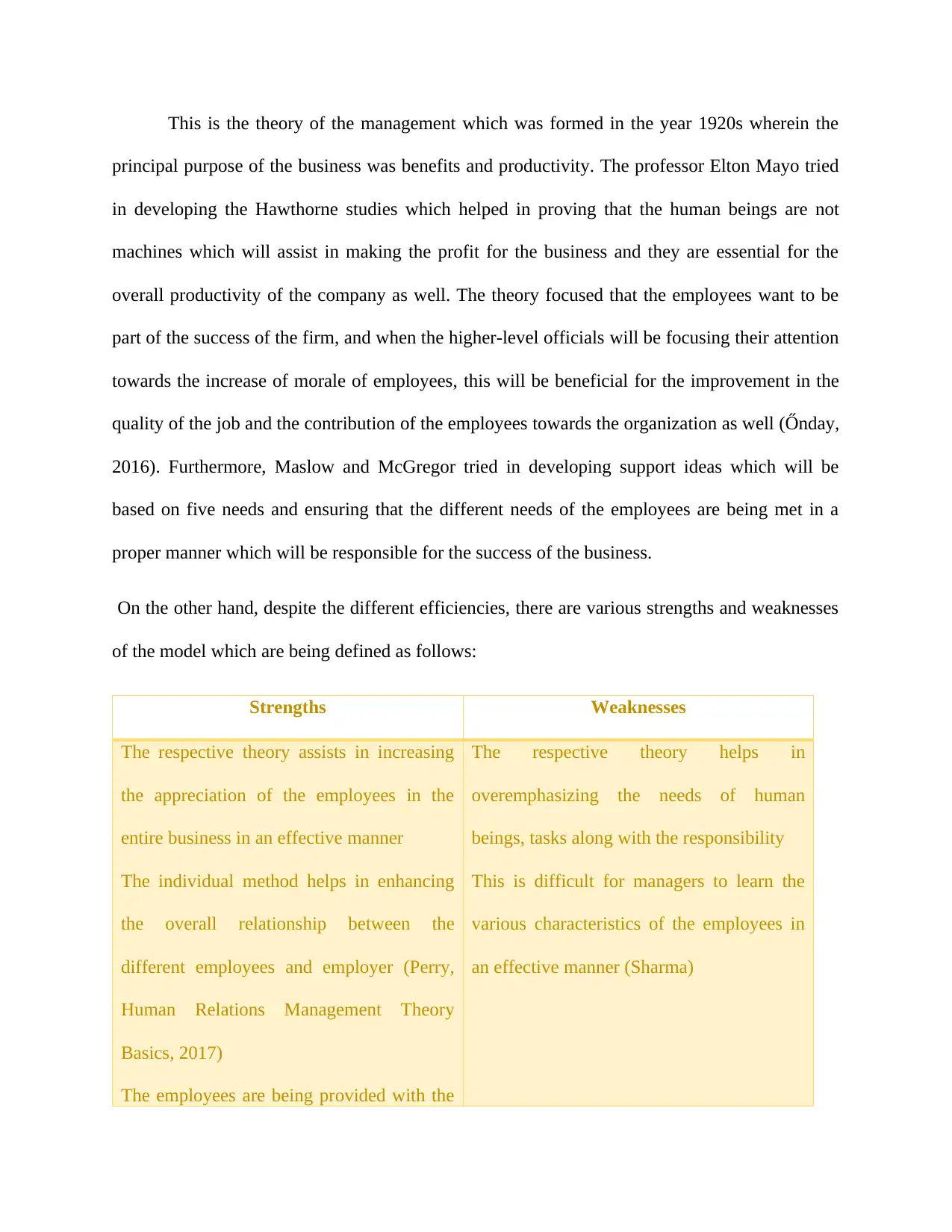
This is the theory of the management which was formed in the year 1920s wherein the
principal purpose of the business was benefits and productivity. The professor Elton Mayo tried
in developing the Hawthorne studies which helped in proving that the human beings are not
machines which will assist in making the profit for the business and they are essential for the
overall productivity of the company as well. The theory focused that the employees want to be
part of the success of the firm, and when the higher-level officials will be focusing their attention
towards the increase of morale of employees, this will be beneficial for the improvement in the
quality of the job and the contribution of the employees towards the organization as well (Őnday,
2016). Furthermore, Maslow and McGregor tried in developing support ideas which will be
based on five needs and ensuring that the different needs of the employees are being met in a
proper manner which will be responsible for the success of the business.
On the other hand, despite the different efficiencies, there are various strengths and weaknesses
of the model which are being defined as follows:
Strengths Weaknesses
The respective theory assists in increasing
the appreciation of the employees in the
entire business in an effective manner
The individual method helps in enhancing
the overall relationship between the
different employees and employer (Perry,
Human Relations Management Theory
Basics, 2017)
The employees are being provided with the
The respective theory helps in
overemphasizing the needs of human
beings, tasks along with the responsibility
This is difficult for managers to learn the
various characteristics of the employees in
an effective manner (Sharma)
principal purpose of the business was benefits and productivity. The professor Elton Mayo tried
in developing the Hawthorne studies which helped in proving that the human beings are not
machines which will assist in making the profit for the business and they are essential for the
overall productivity of the company as well. The theory focused that the employees want to be
part of the success of the firm, and when the higher-level officials will be focusing their attention
towards the increase of morale of employees, this will be beneficial for the improvement in the
quality of the job and the contribution of the employees towards the organization as well (Őnday,
2016). Furthermore, Maslow and McGregor tried in developing support ideas which will be
based on five needs and ensuring that the different needs of the employees are being met in a
proper manner which will be responsible for the success of the business.
On the other hand, despite the different efficiencies, there are various strengths and weaknesses
of the model which are being defined as follows:
Strengths Weaknesses
The respective theory assists in increasing
the appreciation of the employees in the
entire business in an effective manner
The individual method helps in enhancing
the overall relationship between the
different employees and employer (Perry,
Human Relations Management Theory
Basics, 2017)
The employees are being provided with the
The respective theory helps in
overemphasizing the needs of human
beings, tasks along with the responsibility
This is difficult for managers to learn the
various characteristics of the employees in
an effective manner (Sharma)
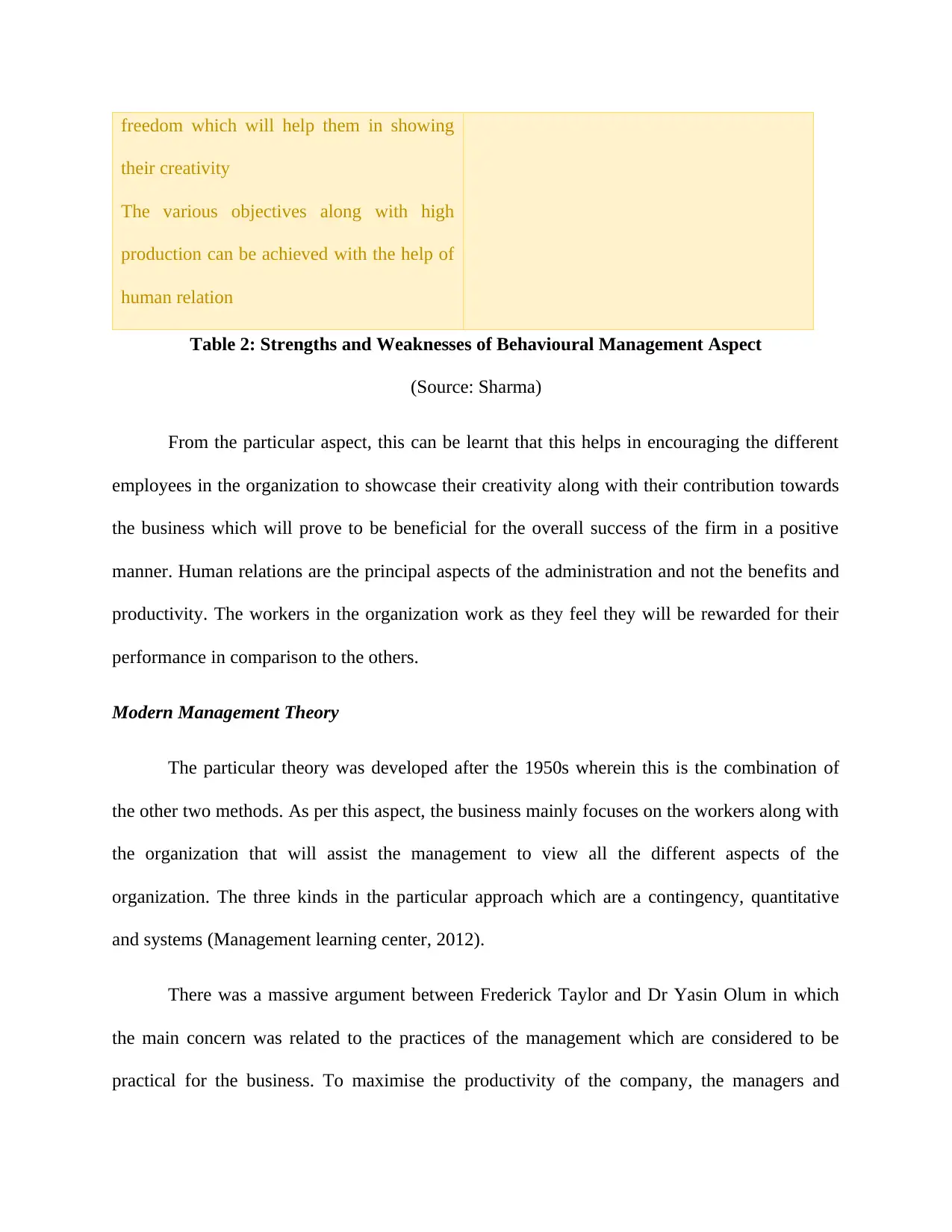
freedom which will help them in showing
their creativity
The various objectives along with high
production can be achieved with the help of
human relation
Table 2: Strengths and Weaknesses of Behavioural Management Aspect
(Source: Sharma)
From the particular aspect, this can be learnt that this helps in encouraging the different
employees in the organization to showcase their creativity along with their contribution towards
the business which will prove to be beneficial for the overall success of the firm in a positive
manner. Human relations are the principal aspects of the administration and not the benefits and
productivity. The workers in the organization work as they feel they will be rewarded for their
performance in comparison to the others.
Modern Management Theory
The particular theory was developed after the 1950s wherein this is the combination of
the other two methods. As per this aspect, the business mainly focuses on the workers along with
the organization that will assist the management to view all the different aspects of the
organization. The three kinds in the particular approach which are a contingency, quantitative
and systems (Management learning center, 2012).
There was a massive argument between Frederick Taylor and Dr Yasin Olum in which
the main concern was related to the practices of the management which are considered to be
practical for the business. To maximise the productivity of the company, the managers and
their creativity
The various objectives along with high
production can be achieved with the help of
human relation
Table 2: Strengths and Weaknesses of Behavioural Management Aspect
(Source: Sharma)
From the particular aspect, this can be learnt that this helps in encouraging the different
employees in the organization to showcase their creativity along with their contribution towards
the business which will prove to be beneficial for the overall success of the firm in a positive
manner. Human relations are the principal aspects of the administration and not the benefits and
productivity. The workers in the organization work as they feel they will be rewarded for their
performance in comparison to the others.
Modern Management Theory
The particular theory was developed after the 1950s wherein this is the combination of
the other two methods. As per this aspect, the business mainly focuses on the workers along with
the organization that will assist the management to view all the different aspects of the
organization. The three kinds in the particular approach which are a contingency, quantitative
and systems (Management learning center, 2012).
There was a massive argument between Frederick Taylor and Dr Yasin Olum in which
the main concern was related to the practices of the management which are considered to be
practical for the business. To maximise the productivity of the company, the managers and
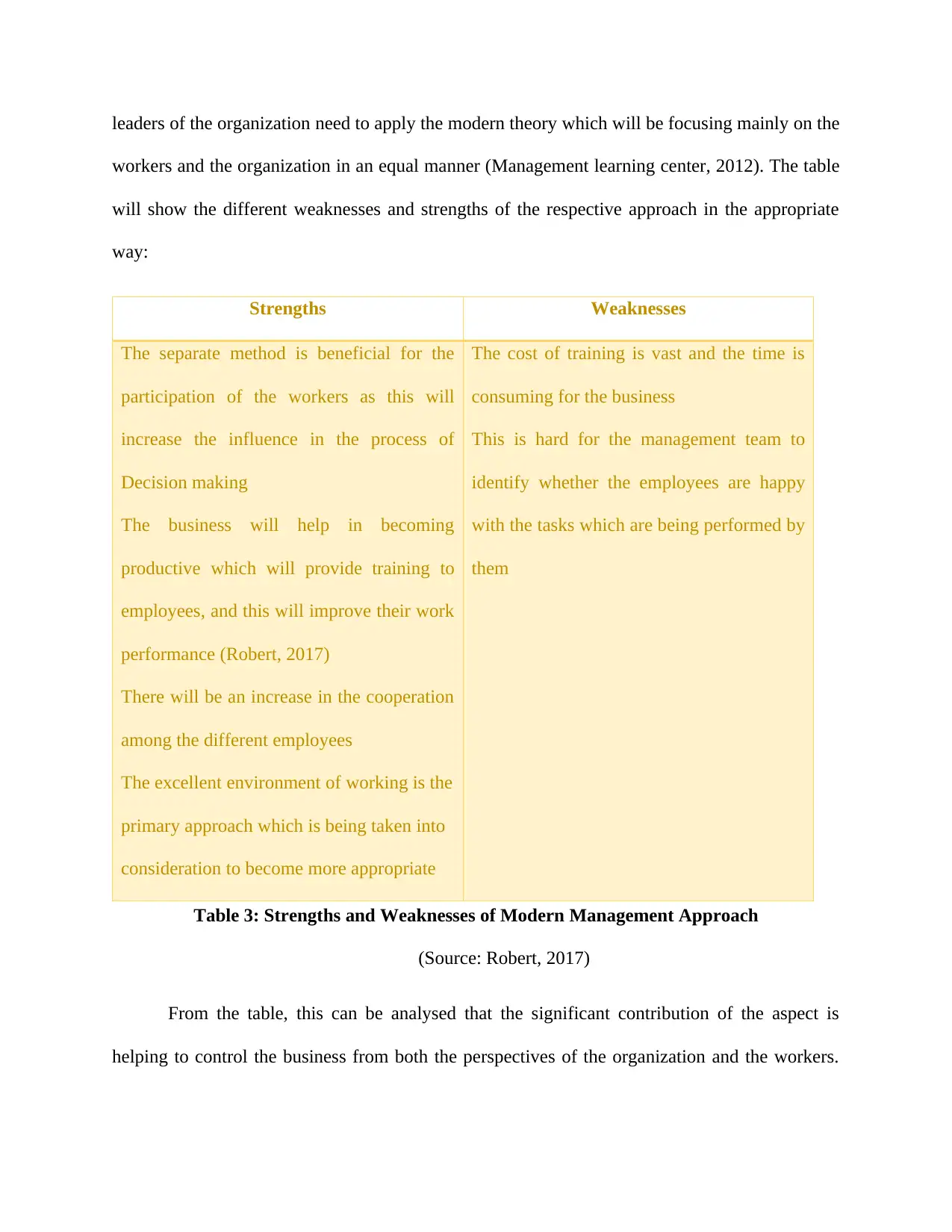
leaders of the organization need to apply the modern theory which will be focusing mainly on the
workers and the organization in an equal manner (Management learning center, 2012). The table
will show the different weaknesses and strengths of the respective approach in the appropriate
way:
Strengths Weaknesses
The separate method is beneficial for the
participation of the workers as this will
increase the influence in the process of
Decision making
The business will help in becoming
productive which will provide training to
employees, and this will improve their work
performance (Robert, 2017)
There will be an increase in the cooperation
among the different employees
The excellent environment of working is the
primary approach which is being taken into
consideration to become more appropriate
The cost of training is vast and the time is
consuming for the business
This is hard for the management team to
identify whether the employees are happy
with the tasks which are being performed by
them
Table 3: Strengths and Weaknesses of Modern Management Approach
(Source: Robert, 2017)
From the table, this can be analysed that the significant contribution of the aspect is
helping to control the business from both the perspectives of the organization and the workers.
workers and the organization in an equal manner (Management learning center, 2012). The table
will show the different weaknesses and strengths of the respective approach in the appropriate
way:
Strengths Weaknesses
The separate method is beneficial for the
participation of the workers as this will
increase the influence in the process of
Decision making
The business will help in becoming
productive which will provide training to
employees, and this will improve their work
performance (Robert, 2017)
There will be an increase in the cooperation
among the different employees
The excellent environment of working is the
primary approach which is being taken into
consideration to become more appropriate
The cost of training is vast and the time is
consuming for the business
This is hard for the management team to
identify whether the employees are happy
with the tasks which are being performed by
them
Table 3: Strengths and Weaknesses of Modern Management Approach
(Source: Robert, 2017)
From the table, this can be analysed that the significant contribution of the aspect is
helping to control the business from both the perspectives of the organization and the workers.
Secure Best Marks with AI Grader
Need help grading? Try our AI Grader for instant feedback on your assignments.
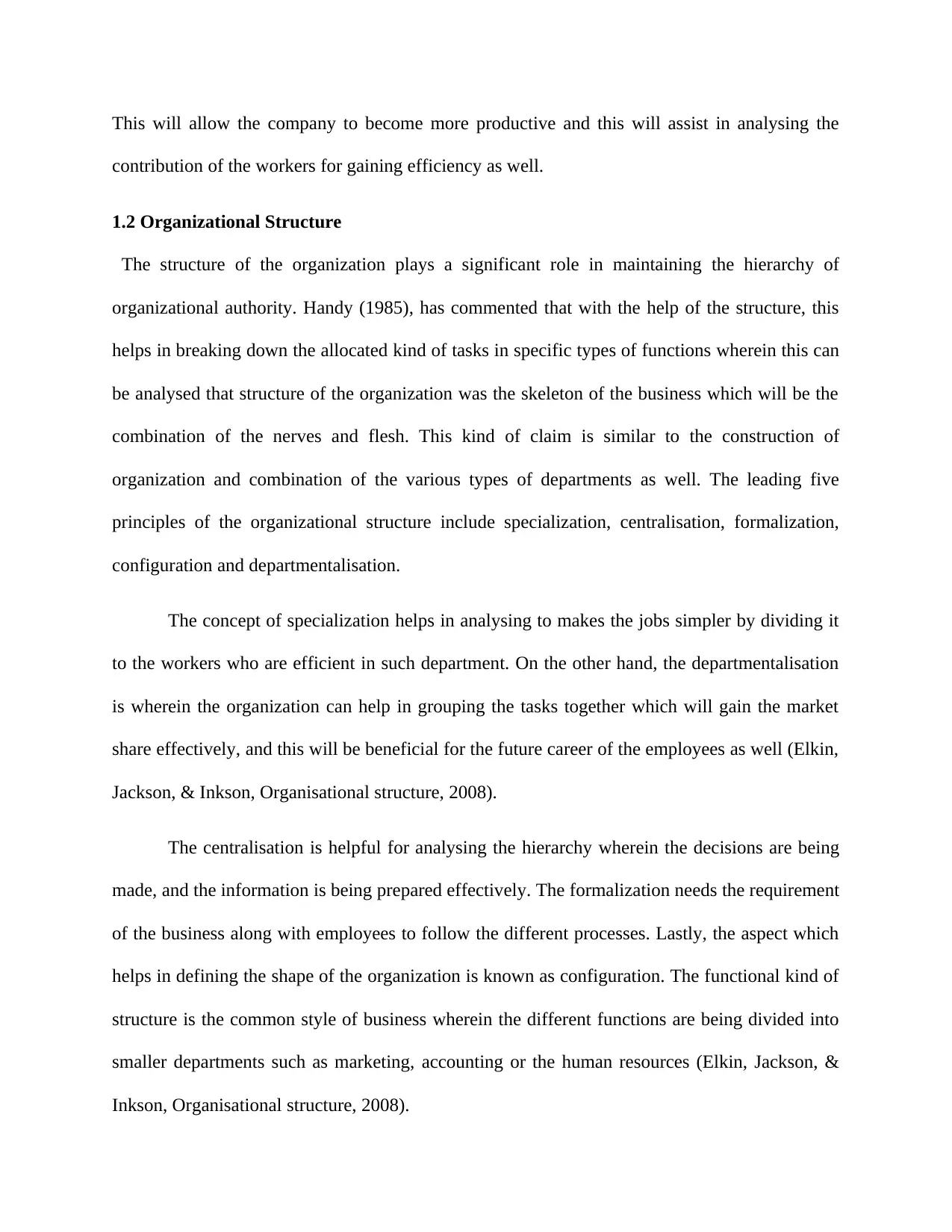
This will allow the company to become more productive and this will assist in analysing the
contribution of the workers for gaining efficiency as well.
1.2 Organizational Structure
The structure of the organization plays a significant role in maintaining the hierarchy of
organizational authority. Handy (1985), has commented that with the help of the structure, this
helps in breaking down the allocated kind of tasks in specific types of functions wherein this can
be analysed that structure of the organization was the skeleton of the business which will be the
combination of the nerves and flesh. This kind of claim is similar to the construction of
organization and combination of the various types of departments as well. The leading five
principles of the organizational structure include specialization, centralisation, formalization,
configuration and departmentalisation.
The concept of specialization helps in analysing to makes the jobs simpler by dividing it
to the workers who are efficient in such department. On the other hand, the departmentalisation
is wherein the organization can help in grouping the tasks together which will gain the market
share effectively, and this will be beneficial for the future career of the employees as well (Elkin,
Jackson, & Inkson, Organisational structure, 2008).
The centralisation is helpful for analysing the hierarchy wherein the decisions are being
made, and the information is being prepared effectively. The formalization needs the requirement
of the business along with employees to follow the different processes. Lastly, the aspect which
helps in defining the shape of the organization is known as configuration. The functional kind of
structure is the common style of business wherein the different functions are being divided into
smaller departments such as marketing, accounting or the human resources (Elkin, Jackson, &
Inkson, Organisational structure, 2008).
contribution of the workers for gaining efficiency as well.
1.2 Organizational Structure
The structure of the organization plays a significant role in maintaining the hierarchy of
organizational authority. Handy (1985), has commented that with the help of the structure, this
helps in breaking down the allocated kind of tasks in specific types of functions wherein this can
be analysed that structure of the organization was the skeleton of the business which will be the
combination of the nerves and flesh. This kind of claim is similar to the construction of
organization and combination of the various types of departments as well. The leading five
principles of the organizational structure include specialization, centralisation, formalization,
configuration and departmentalisation.
The concept of specialization helps in analysing to makes the jobs simpler by dividing it
to the workers who are efficient in such department. On the other hand, the departmentalisation
is wherein the organization can help in grouping the tasks together which will gain the market
share effectively, and this will be beneficial for the future career of the employees as well (Elkin,
Jackson, & Inkson, Organisational structure, 2008).
The centralisation is helpful for analysing the hierarchy wherein the decisions are being
made, and the information is being prepared effectively. The formalization needs the requirement
of the business along with employees to follow the different processes. Lastly, the aspect which
helps in defining the shape of the organization is known as configuration. The functional kind of
structure is the common style of business wherein the different functions are being divided into
smaller departments such as marketing, accounting or the human resources (Elkin, Jackson, &
Inkson, Organisational structure, 2008).
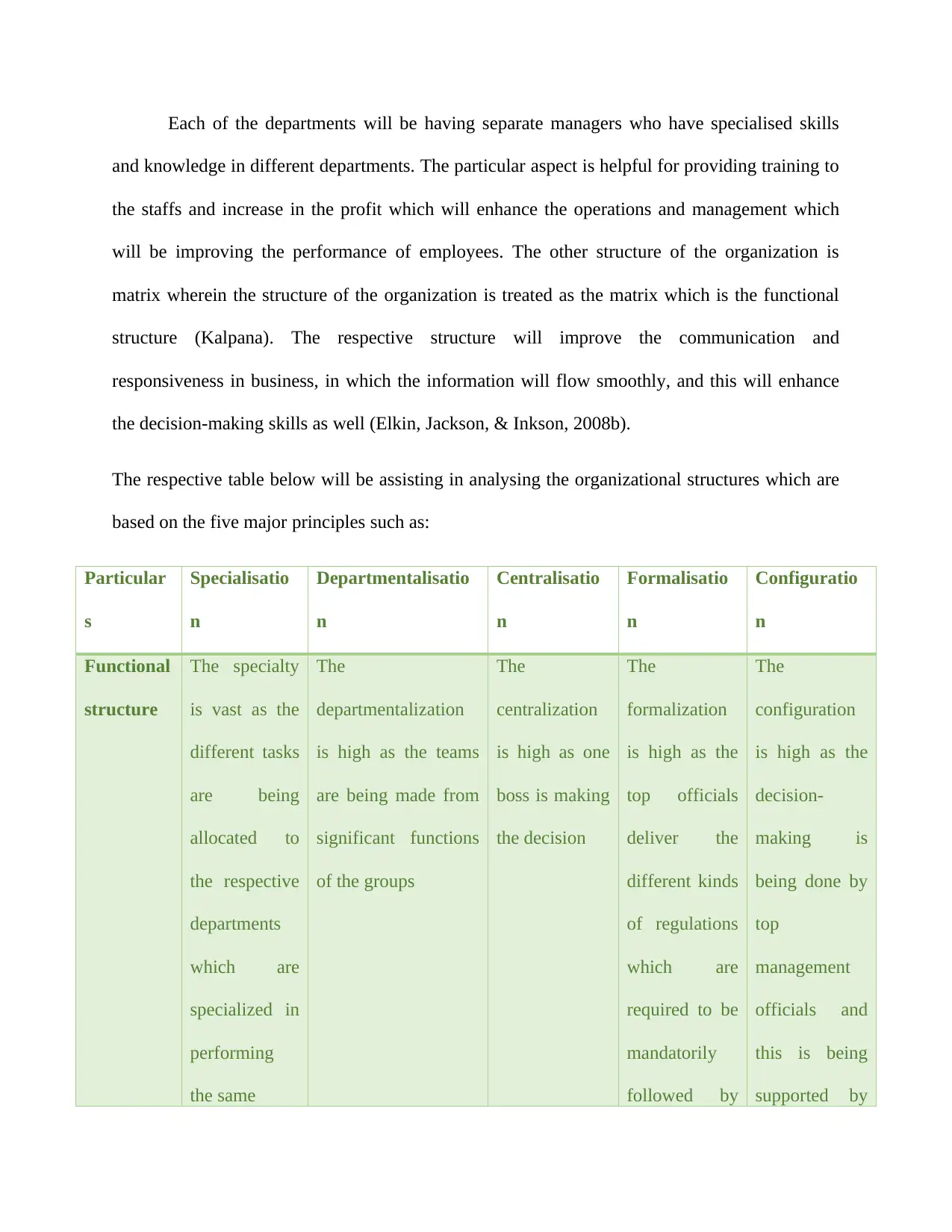
Each of the departments will be having separate managers who have specialised skills
and knowledge in different departments. The particular aspect is helpful for providing training to
the staffs and increase in the profit which will enhance the operations and management which
will be improving the performance of employees. The other structure of the organization is
matrix wherein the structure of the organization is treated as the matrix which is the functional
structure (Kalpana). The respective structure will improve the communication and
responsiveness in business, in which the information will flow smoothly, and this will enhance
the decision-making skills as well (Elkin, Jackson, & Inkson, 2008b).
The respective table below will be assisting in analysing the organizational structures which are
based on the five major principles such as:
Particular
s
Specialisatio
n
Departmentalisatio
n
Centralisatio
n
Formalisatio
n
Configuratio
n
Functional
structure
The specialty
is vast as the
different tasks
are being
allocated to
the respective
departments
which are
specialized in
performing
the same
The
departmentalization
is high as the teams
are being made from
significant functions
of the groups
The
centralization
is high as one
boss is making
the decision
The
formalization
is high as the
top officials
deliver the
different kinds
of regulations
which are
required to be
mandatorily
followed by
The
configuration
is high as the
decision-
making is
being done by
top
management
officials and
this is being
supported by
and knowledge in different departments. The particular aspect is helpful for providing training to
the staffs and increase in the profit which will enhance the operations and management which
will be improving the performance of employees. The other structure of the organization is
matrix wherein the structure of the organization is treated as the matrix which is the functional
structure (Kalpana). The respective structure will improve the communication and
responsiveness in business, in which the information will flow smoothly, and this will enhance
the decision-making skills as well (Elkin, Jackson, & Inkson, 2008b).
The respective table below will be assisting in analysing the organizational structures which are
based on the five major principles such as:
Particular
s
Specialisatio
n
Departmentalisatio
n
Centralisatio
n
Formalisatio
n
Configuratio
n
Functional
structure
The specialty
is vast as the
different tasks
are being
allocated to
the respective
departments
which are
specialized in
performing
the same
The
departmentalization
is high as the teams
are being made from
significant functions
of the groups
The
centralization
is high as one
boss is making
the decision
The
formalization
is high as the
top officials
deliver the
different kinds
of regulations
which are
required to be
mandatorily
followed by
The
configuration
is high as the
decision-
making is
being done by
top
management
officials and
this is being
supported by
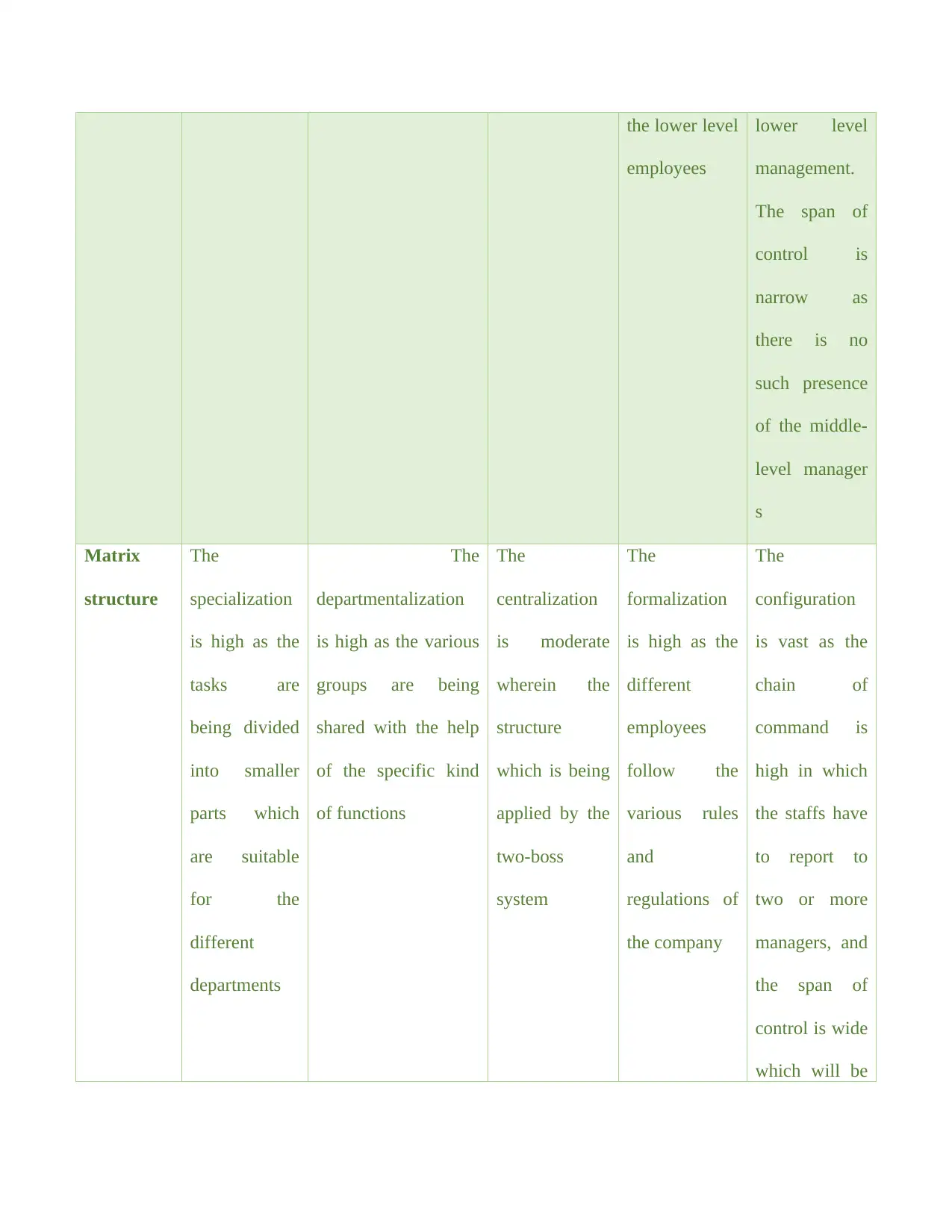
the lower level
employees
lower level
management.
The span of
control is
narrow as
there is no
such presence
of the middle-
level manager
s
Matrix
structure
The
specialization
is high as the
tasks are
being divided
into smaller
parts which
are suitable
for the
different
departments
The
departmentalization
is high as the various
groups are being
shared with the help
of the specific kind
of functions
The
centralization
is moderate
wherein the
structure
which is being
applied by the
two-boss
system
The
formalization
is high as the
different
employees
follow the
various rules
and
regulations of
the company
The
configuration
is vast as the
chain of
command is
high in which
the staffs have
to report to
two or more
managers, and
the span of
control is wide
which will be
employees
lower level
management.
The span of
control is
narrow as
there is no
such presence
of the middle-
level manager
s
Matrix
structure
The
specialization
is high as the
tasks are
being divided
into smaller
parts which
are suitable
for the
different
departments
The
departmentalization
is high as the various
groups are being
shared with the help
of the specific kind
of functions
The
centralization
is moderate
wherein the
structure
which is being
applied by the
two-boss
system
The
formalization
is high as the
different
employees
follow the
various rules
and
regulations of
the company
The
configuration
is vast as the
chain of
command is
high in which
the staffs have
to report to
two or more
managers, and
the span of
control is wide
which will be
Paraphrase This Document
Need a fresh take? Get an instant paraphrase of this document with our AI Paraphraser
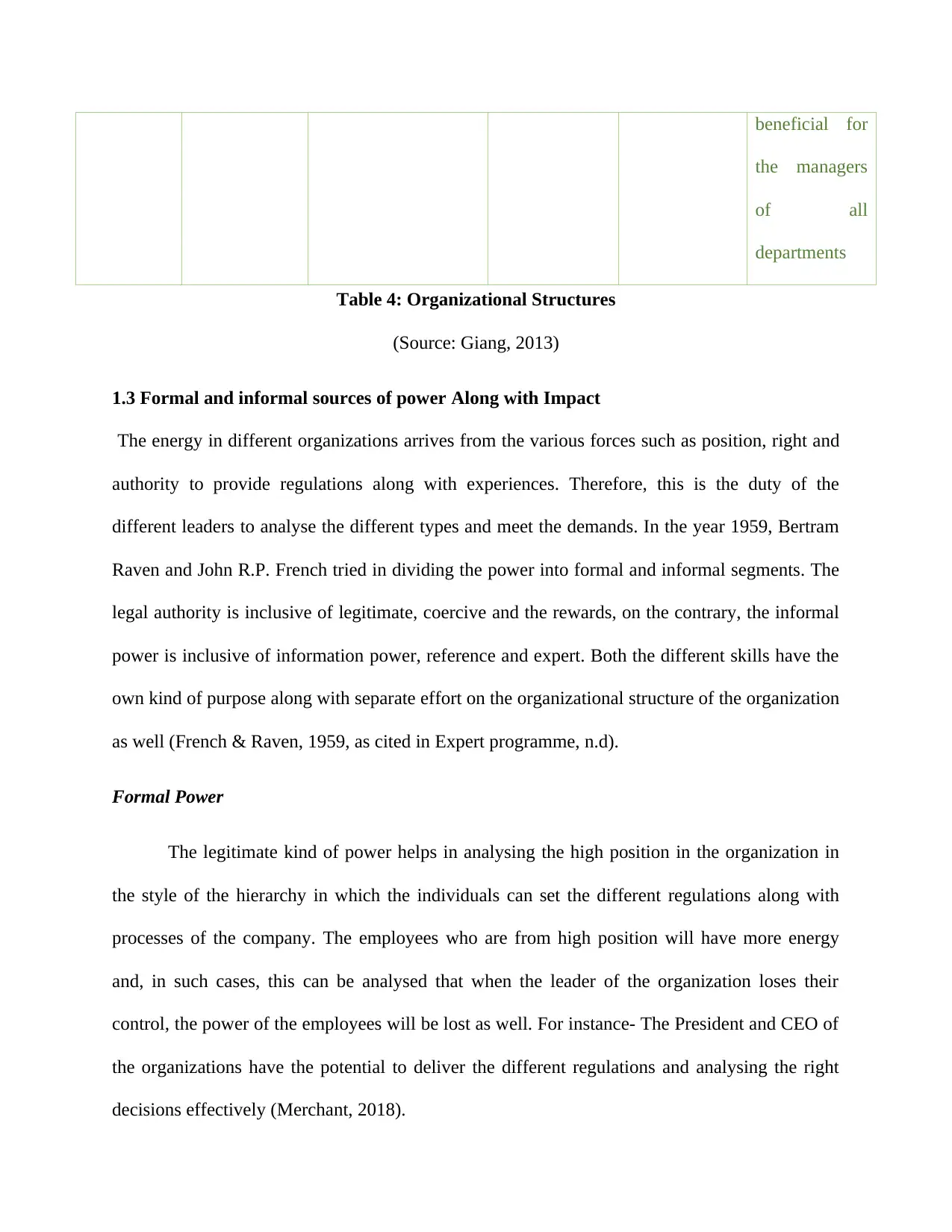
beneficial for
the managers
of all
departments
Table 4: Organizational Structures
(Source: Giang, 2013)
1.3 Formal and informal sources of power Along with Impact
The energy in different organizations arrives from the various forces such as position, right and
authority to provide regulations along with experiences. Therefore, this is the duty of the
different leaders to analyse the different types and meet the demands. In the year 1959, Bertram
Raven and John R.P. French tried in dividing the power into formal and informal segments. The
legal authority is inclusive of legitimate, coercive and the rewards, on the contrary, the informal
power is inclusive of information power, reference and expert. Both the different skills have the
own kind of purpose along with separate effort on the organizational structure of the organization
as well (French & Raven, 1959, as cited in Expert programme, n.d).
Formal Power
The legitimate kind of power helps in analysing the high position in the organization in
the style of the hierarchy in which the individuals can set the different regulations along with
processes of the company. The employees who are from high position will have more energy
and, in such cases, this can be analysed that when the leader of the organization loses their
control, the power of the employees will be lost as well. For instance- The President and CEO of
the organizations have the potential to deliver the different regulations and analysing the right
decisions effectively (Merchant, 2018).
the managers
of all
departments
Table 4: Organizational Structures
(Source: Giang, 2013)
1.3 Formal and informal sources of power Along with Impact
The energy in different organizations arrives from the various forces such as position, right and
authority to provide regulations along with experiences. Therefore, this is the duty of the
different leaders to analyse the different types and meet the demands. In the year 1959, Bertram
Raven and John R.P. French tried in dividing the power into formal and informal segments. The
legal authority is inclusive of legitimate, coercive and the rewards, on the contrary, the informal
power is inclusive of information power, reference and expert. Both the different skills have the
own kind of purpose along with separate effort on the organizational structure of the organization
as well (French & Raven, 1959, as cited in Expert programme, n.d).
Formal Power
The legitimate kind of power helps in analysing the high position in the organization in
the style of the hierarchy in which the individuals can set the different regulations along with
processes of the company. The employees who are from high position will have more energy
and, in such cases, this can be analysed that when the leader of the organization loses their
control, the power of the employees will be lost as well. For instance- The President and CEO of
the organizations have the potential to deliver the different regulations and analysing the right
decisions effectively (Merchant, 2018).
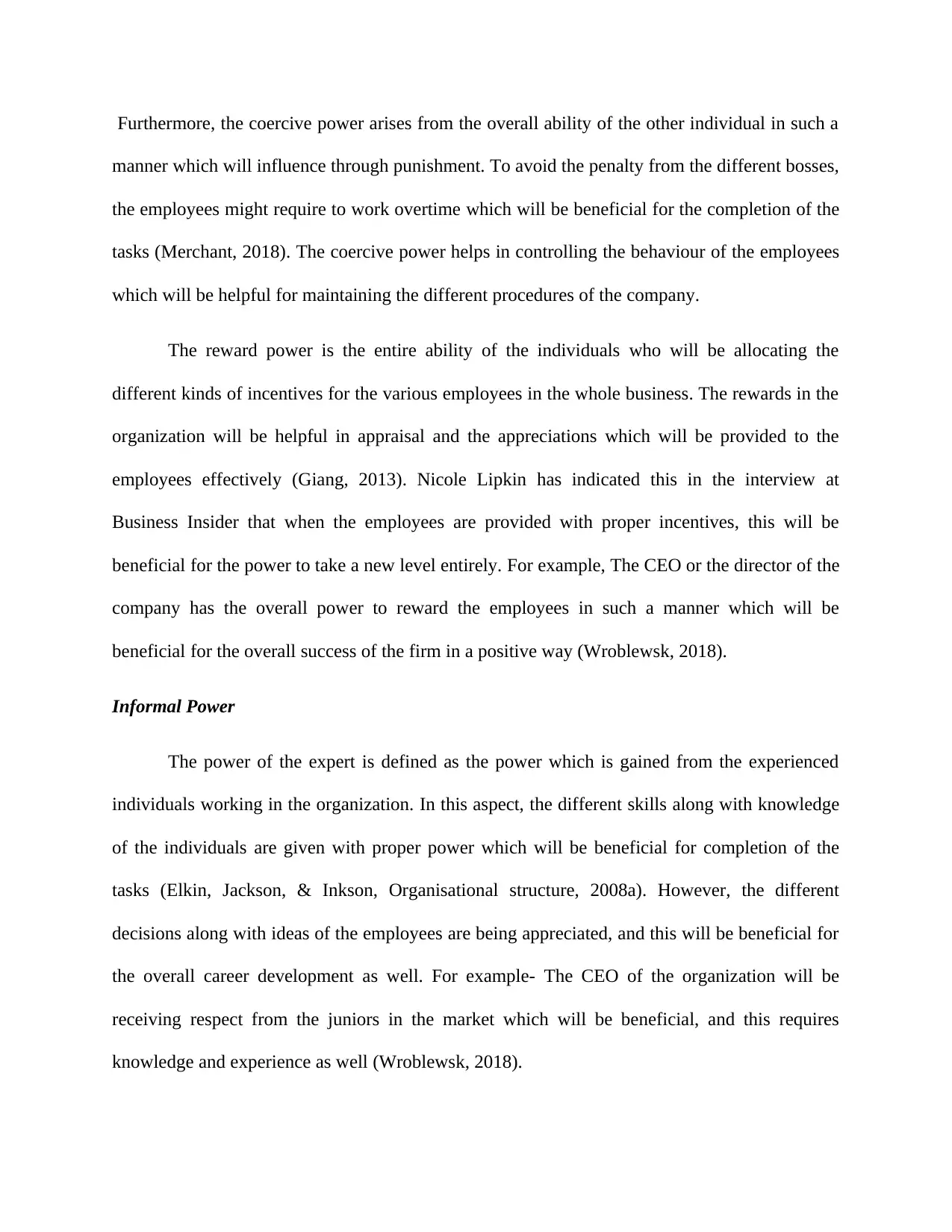
Furthermore, the coercive power arises from the overall ability of the other individual in such a
manner which will influence through punishment. To avoid the penalty from the different bosses,
the employees might require to work overtime which will be beneficial for the completion of the
tasks (Merchant, 2018). The coercive power helps in controlling the behaviour of the employees
which will be helpful for maintaining the different procedures of the company.
The reward power is the entire ability of the individuals who will be allocating the
different kinds of incentives for the various employees in the whole business. The rewards in the
organization will be helpful in appraisal and the appreciations which will be provided to the
employees effectively (Giang, 2013). Nicole Lipkin has indicated this in the interview at
Business Insider that when the employees are provided with proper incentives, this will be
beneficial for the power to take a new level entirely. For example, The CEO or the director of the
company has the overall power to reward the employees in such a manner which will be
beneficial for the overall success of the firm in a positive way (Wroblewsk, 2018).
Informal Power
The power of the expert is defined as the power which is gained from the experienced
individuals working in the organization. In this aspect, the different skills along with knowledge
of the individuals are given with proper power which will be beneficial for completion of the
tasks (Elkin, Jackson, & Inkson, Organisational structure, 2008a). However, the different
decisions along with ideas of the employees are being appreciated, and this will be beneficial for
the overall career development as well. For example- The CEO of the organization will be
receiving respect from the juniors in the market which will be beneficial, and this requires
knowledge and experience as well (Wroblewsk, 2018).
manner which will influence through punishment. To avoid the penalty from the different bosses,
the employees might require to work overtime which will be beneficial for the completion of the
tasks (Merchant, 2018). The coercive power helps in controlling the behaviour of the employees
which will be helpful for maintaining the different procedures of the company.
The reward power is the entire ability of the individuals who will be allocating the
different kinds of incentives for the various employees in the whole business. The rewards in the
organization will be helpful in appraisal and the appreciations which will be provided to the
employees effectively (Giang, 2013). Nicole Lipkin has indicated this in the interview at
Business Insider that when the employees are provided with proper incentives, this will be
beneficial for the power to take a new level entirely. For example, The CEO or the director of the
company has the overall power to reward the employees in such a manner which will be
beneficial for the overall success of the firm in a positive way (Wroblewsk, 2018).
Informal Power
The power of the expert is defined as the power which is gained from the experienced
individuals working in the organization. In this aspect, the different skills along with knowledge
of the individuals are given with proper power which will be beneficial for completion of the
tasks (Elkin, Jackson, & Inkson, Organisational structure, 2008a). However, the different
decisions along with ideas of the employees are being appreciated, and this will be beneficial for
the overall career development as well. For example- The CEO of the organization will be
receiving respect from the juniors in the market which will be beneficial, and this requires
knowledge and experience as well (Wroblewsk, 2018).
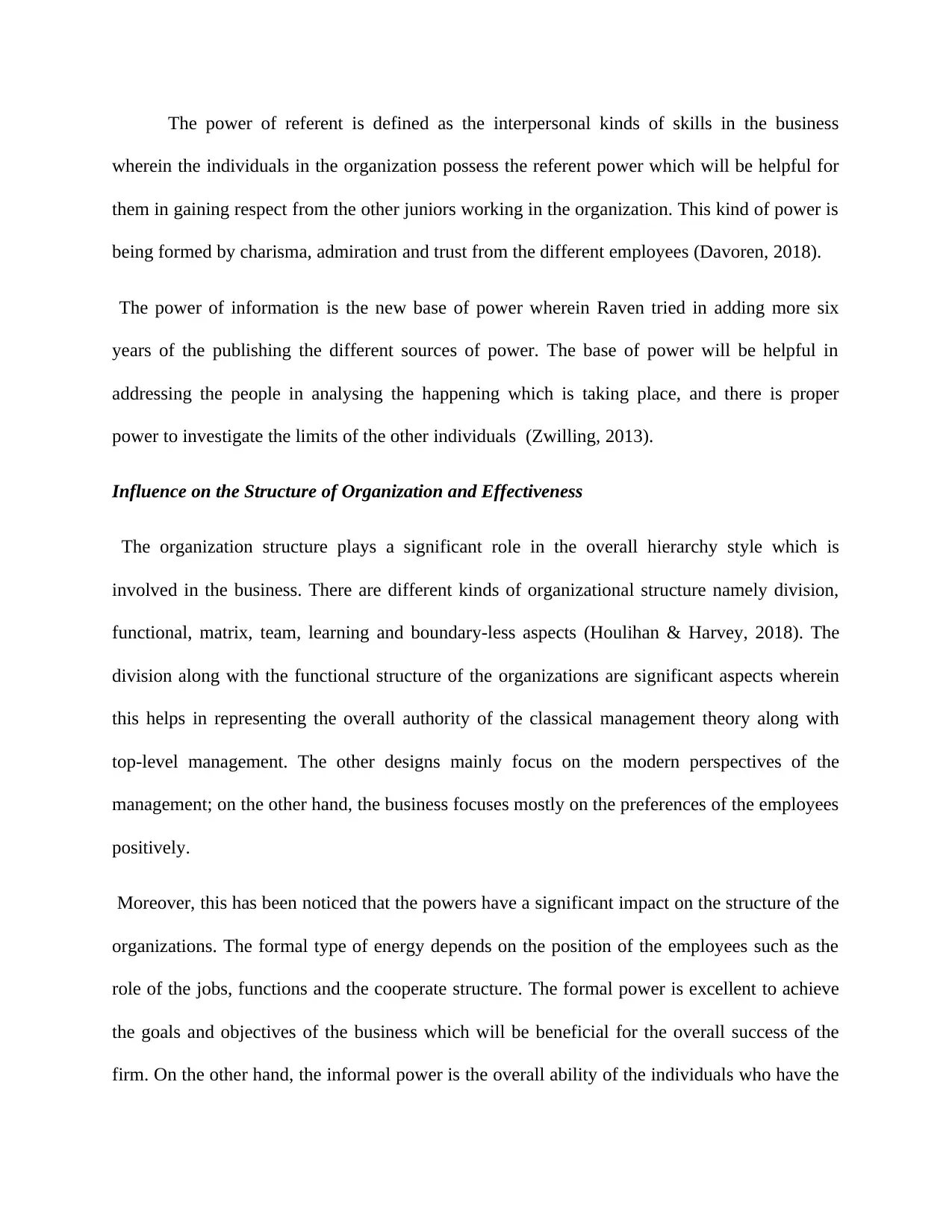
The power of referent is defined as the interpersonal kinds of skills in the business
wherein the individuals in the organization possess the referent power which will be helpful for
them in gaining respect from the other juniors working in the organization. This kind of power is
being formed by charisma, admiration and trust from the different employees (Davoren, 2018).
The power of information is the new base of power wherein Raven tried in adding more six
years of the publishing the different sources of power. The base of power will be helpful in
addressing the people in analysing the happening which is taking place, and there is proper
power to investigate the limits of the other individuals (Zwilling, 2013).
Influence on the Structure of Organization and Effectiveness
The organization structure plays a significant role in the overall hierarchy style which is
involved in the business. There are different kinds of organizational structure namely division,
functional, matrix, team, learning and boundary-less aspects (Houlihan & Harvey, 2018). The
division along with the functional structure of the organizations are significant aspects wherein
this helps in representing the overall authority of the classical management theory along with
top-level management. The other designs mainly focus on the modern perspectives of the
management; on the other hand, the business focuses mostly on the preferences of the employees
positively.
Moreover, this has been noticed that the powers have a significant impact on the structure of the
organizations. The formal type of energy depends on the position of the employees such as the
role of the jobs, functions and the cooperate structure. The formal power is excellent to achieve
the goals and objectives of the business which will be beneficial for the overall success of the
firm. On the other hand, the informal power is the overall ability of the individuals who have the
wherein the individuals in the organization possess the referent power which will be helpful for
them in gaining respect from the other juniors working in the organization. This kind of power is
being formed by charisma, admiration and trust from the different employees (Davoren, 2018).
The power of information is the new base of power wherein Raven tried in adding more six
years of the publishing the different sources of power. The base of power will be helpful in
addressing the people in analysing the happening which is taking place, and there is proper
power to investigate the limits of the other individuals (Zwilling, 2013).
Influence on the Structure of Organization and Effectiveness
The organization structure plays a significant role in the overall hierarchy style which is
involved in the business. There are different kinds of organizational structure namely division,
functional, matrix, team, learning and boundary-less aspects (Houlihan & Harvey, 2018). The
division along with the functional structure of the organizations are significant aspects wherein
this helps in representing the overall authority of the classical management theory along with
top-level management. The other designs mainly focus on the modern perspectives of the
management; on the other hand, the business focuses mostly on the preferences of the employees
positively.
Moreover, this has been noticed that the powers have a significant impact on the structure of the
organizations. The formal type of energy depends on the position of the employees such as the
role of the jobs, functions and the cooperate structure. The formal power is excellent to achieve
the goals and objectives of the business which will be beneficial for the overall success of the
firm. On the other hand, the informal power is the overall ability of the individuals who have the
Secure Best Marks with AI Grader
Need help grading? Try our AI Grader for instant feedback on your assignments.

power to influence others with the skills along with information (Yager, 2012, as cited in
Zwilling, 2013). The respective power is relating to the networking along with interrelationships,
and this is seen that the managers can mix both formal and informal power which will be
beneficial for the overall efficiency of the firms in a positive manner.
1.4 Current and Traditional Perspectives
Delegation
The delegation plays a vital role in the success of the business that is inclusive of the
controls, and this helps in empowering the person to act on behalf of the managers which will be
beneficial for the overall success of the firm. There has been the claiming that more than 30% of
the different managers try in analysing that there are ones who are good in delegating the
different kinds of tasks and delegation is not an easy task as this is the entire responsibility of the
manager to analyse whether the jobs are being done appropriately. To create useful kind of
delegation, Jan Yanger has tried in commenting that there are only a few steps which are
required to be followed which will be interesting which are mentioned in the book that is "Work
Less and do more". In this particular aspect, the individuals need to choose the different tasks
which are required to be delegated which are not being able to perform by them, and they do not
find the same interesting as well (Zwilling, 2013). For instance- There are different small
businesses in which this can be seen that they can delegate the accounting related jobs to the
external sources which are famous for positively handling such activities.
Furthermore, the choosing of the right and appropriate person for delegating the tasks is
essential by observing the different skills and character to analyse that the person can perform
the functions in a much more efficient manner (Kline, 2018). The organization requires to trust
the individuals and provide them with proper restrictions for the tasks which are delegated to the
Zwilling, 2013). The respective power is relating to the networking along with interrelationships,
and this is seen that the managers can mix both formal and informal power which will be
beneficial for the overall efficiency of the firms in a positive manner.
1.4 Current and Traditional Perspectives
Delegation
The delegation plays a vital role in the success of the business that is inclusive of the
controls, and this helps in empowering the person to act on behalf of the managers which will be
beneficial for the overall success of the firm. There has been the claiming that more than 30% of
the different managers try in analysing that there are ones who are good in delegating the
different kinds of tasks and delegation is not an easy task as this is the entire responsibility of the
manager to analyse whether the jobs are being done appropriately. To create useful kind of
delegation, Jan Yanger has tried in commenting that there are only a few steps which are
required to be followed which will be interesting which are mentioned in the book that is "Work
Less and do more". In this particular aspect, the individuals need to choose the different tasks
which are required to be delegated which are not being able to perform by them, and they do not
find the same interesting as well (Zwilling, 2013). For instance- There are different small
businesses in which this can be seen that they can delegate the accounting related jobs to the
external sources which are famous for positively handling such activities.
Furthermore, the choosing of the right and appropriate person for delegating the tasks is
essential by observing the different skills and character to analyse that the person can perform
the functions in a much more efficient manner (Kline, 2018). The organization requires to trust
the individuals and provide them with proper restrictions for the tasks which are delegated to the
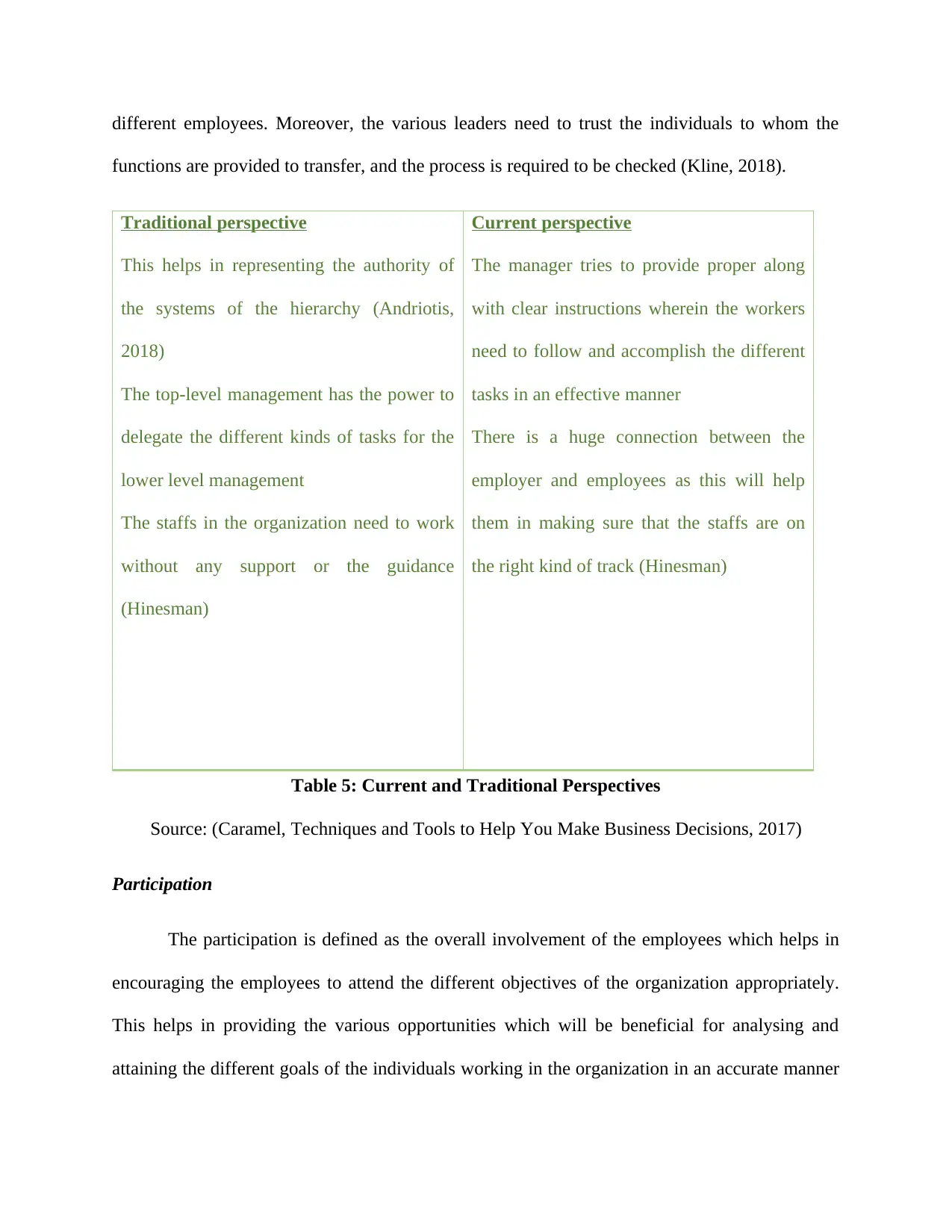
different employees. Moreover, the various leaders need to trust the individuals to whom the
functions are provided to transfer, and the process is required to be checked (Kline, 2018).
Traditional perspective
This helps in representing the authority of
the systems of the hierarchy (Andriotis,
2018)
The top-level management has the power to
delegate the different kinds of tasks for the
lower level management
The staffs in the organization need to work
without any support or the guidance
(Hinesman)
Current perspective
The manager tries to provide proper along
with clear instructions wherein the workers
need to follow and accomplish the different
tasks in an effective manner
There is a huge connection between the
employer and employees as this will help
them in making sure that the staffs are on
the right kind of track (Hinesman)
Table 5: Current and Traditional Perspectives
Source: (Caramel, Techniques and Tools to Help You Make Business Decisions, 2017)
Participation
The participation is defined as the overall involvement of the employees which helps in
encouraging the employees to attend the different objectives of the organization appropriately.
This helps in providing the various opportunities which will be beneficial for analysing and
attaining the different goals of the individuals working in the organization in an accurate manner
functions are provided to transfer, and the process is required to be checked (Kline, 2018).
Traditional perspective
This helps in representing the authority of
the systems of the hierarchy (Andriotis,
2018)
The top-level management has the power to
delegate the different kinds of tasks for the
lower level management
The staffs in the organization need to work
without any support or the guidance
(Hinesman)
Current perspective
The manager tries to provide proper along
with clear instructions wherein the workers
need to follow and accomplish the different
tasks in an effective manner
There is a huge connection between the
employer and employees as this will help
them in making sure that the staffs are on
the right kind of track (Hinesman)
Table 5: Current and Traditional Perspectives
Source: (Caramel, Techniques and Tools to Help You Make Business Decisions, 2017)
Participation
The participation is defined as the overall involvement of the employees which helps in
encouraging the employees to attend the different objectives of the organization appropriately.
This helps in providing the various opportunities which will be beneficial for analysing and
attaining the different goals of the individuals working in the organization in an accurate manner
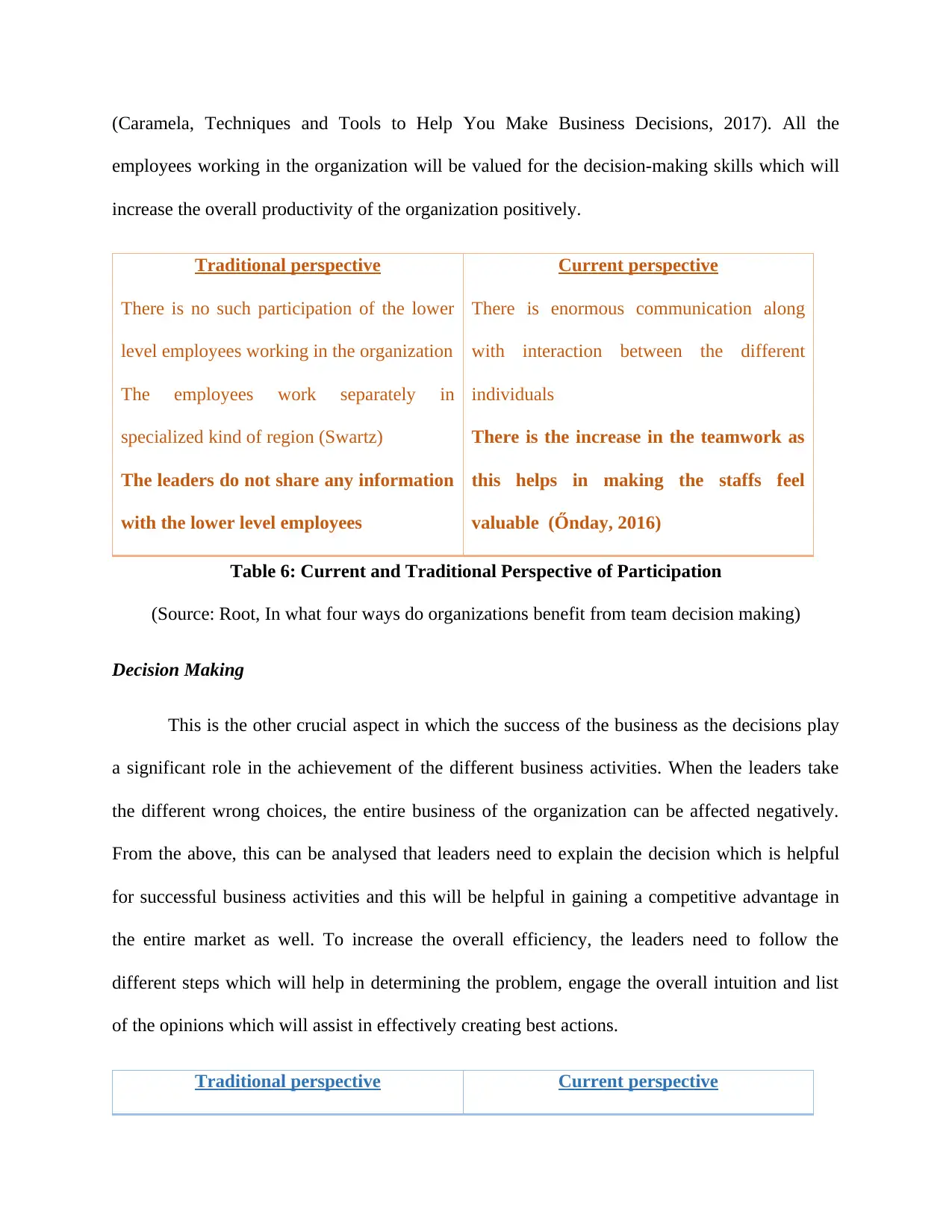
(Caramela, Techniques and Tools to Help You Make Business Decisions, 2017). All the
employees working in the organization will be valued for the decision-making skills which will
increase the overall productivity of the organization positively.
Traditional perspective
There is no such participation of the lower
level employees working in the organization
The employees work separately in
specialized kind of region (Swartz)
The leaders do not share any information
with the lower level employees
Current perspective
There is enormous communication along
with interaction between the different
individuals
There is the increase in the teamwork as
this helps in making the staffs feel
valuable (Őnday, 2016)
Table 6: Current and Traditional Perspective of Participation
(Source: Root, In what four ways do organizations benefit from team decision making)
Decision Making
This is the other crucial aspect in which the success of the business as the decisions play
a significant role in the achievement of the different business activities. When the leaders take
the different wrong choices, the entire business of the organization can be affected negatively.
From the above, this can be analysed that leaders need to explain the decision which is helpful
for successful business activities and this will be helpful in gaining a competitive advantage in
the entire market as well. To increase the overall efficiency, the leaders need to follow the
different steps which will help in determining the problem, engage the overall intuition and list
of the opinions which will assist in effectively creating best actions.
Traditional perspective Current perspective
employees working in the organization will be valued for the decision-making skills which will
increase the overall productivity of the organization positively.
Traditional perspective
There is no such participation of the lower
level employees working in the organization
The employees work separately in
specialized kind of region (Swartz)
The leaders do not share any information
with the lower level employees
Current perspective
There is enormous communication along
with interaction between the different
individuals
There is the increase in the teamwork as
this helps in making the staffs feel
valuable (Őnday, 2016)
Table 6: Current and Traditional Perspective of Participation
(Source: Root, In what four ways do organizations benefit from team decision making)
Decision Making
This is the other crucial aspect in which the success of the business as the decisions play
a significant role in the achievement of the different business activities. When the leaders take
the different wrong choices, the entire business of the organization can be affected negatively.
From the above, this can be analysed that leaders need to explain the decision which is helpful
for successful business activities and this will be helpful in gaining a competitive advantage in
the entire market as well. To increase the overall efficiency, the leaders need to follow the
different steps which will help in determining the problem, engage the overall intuition and list
of the opinions which will assist in effectively creating best actions.
Traditional perspective Current perspective
Paraphrase This Document
Need a fresh take? Get an instant paraphrase of this document with our AI Paraphraser

In this perspective, the top-level
management makes the decisions and there
is no such involvement of the lower level
employees (Root, In what four ways do
organizations benefit from team decision
making) The steps included in the process
of decision-making is inclusive of different
steps which can affect the overall efficiency
of the firm (Akrani, 2011a)
The process of the decision is quick in
nature, and this encourages the creativity of
the employees
The final decision is being made with the
help of the different employees working in
the organization which will be beneficial for
the maintenance of the quality (Mooney &
Riley, 1939, as cited in Shinde, 2018)
Table 7: Current and Traditional Perspective of Decision-Making
(Source: Akrani, 2011a)
1.5 Horizontal and Vertical Integration
Ferguson, (2004) has commented and opined that coordination is the overall arrangement
of the different efforts of the group which will be beneficial for the company in an appropriate
manner. On the contrary, (Elkin & Inkson, (2000a) have hypothesised that coordination is the
key element which plays a significant role in different departments which will meet the purpose
of understanding the various principles which will play a significant role in managing the
multiple actions in an appropriate manner. Blasingame, (2015) has commented that there are
different principles of coordination which is inclusive of early stage, continuity, right kind of
contact and mutual relations.
Early stage is defined as the approach in which the planning stage is being taken into
consideration as the leaders try to consult with the other members working in the company to
management makes the decisions and there
is no such involvement of the lower level
employees (Root, In what four ways do
organizations benefit from team decision
making) The steps included in the process
of decision-making is inclusive of different
steps which can affect the overall efficiency
of the firm (Akrani, 2011a)
The process of the decision is quick in
nature, and this encourages the creativity of
the employees
The final decision is being made with the
help of the different employees working in
the organization which will be beneficial for
the maintenance of the quality (Mooney &
Riley, 1939, as cited in Shinde, 2018)
Table 7: Current and Traditional Perspective of Decision-Making
(Source: Akrani, 2011a)
1.5 Horizontal and Vertical Integration
Ferguson, (2004) has commented and opined that coordination is the overall arrangement
of the different efforts of the group which will be beneficial for the company in an appropriate
manner. On the contrary, (Elkin & Inkson, (2000a) have hypothesised that coordination is the
key element which plays a significant role in different departments which will meet the purpose
of understanding the various principles which will play a significant role in managing the
multiple actions in an appropriate manner. Blasingame, (2015) has commented that there are
different principles of coordination which is inclusive of early stage, continuity, right kind of
contact and mutual relations.
Early stage is defined as the approach in which the planning stage is being taken into
consideration as the leaders try to consult with the other members working in the company to
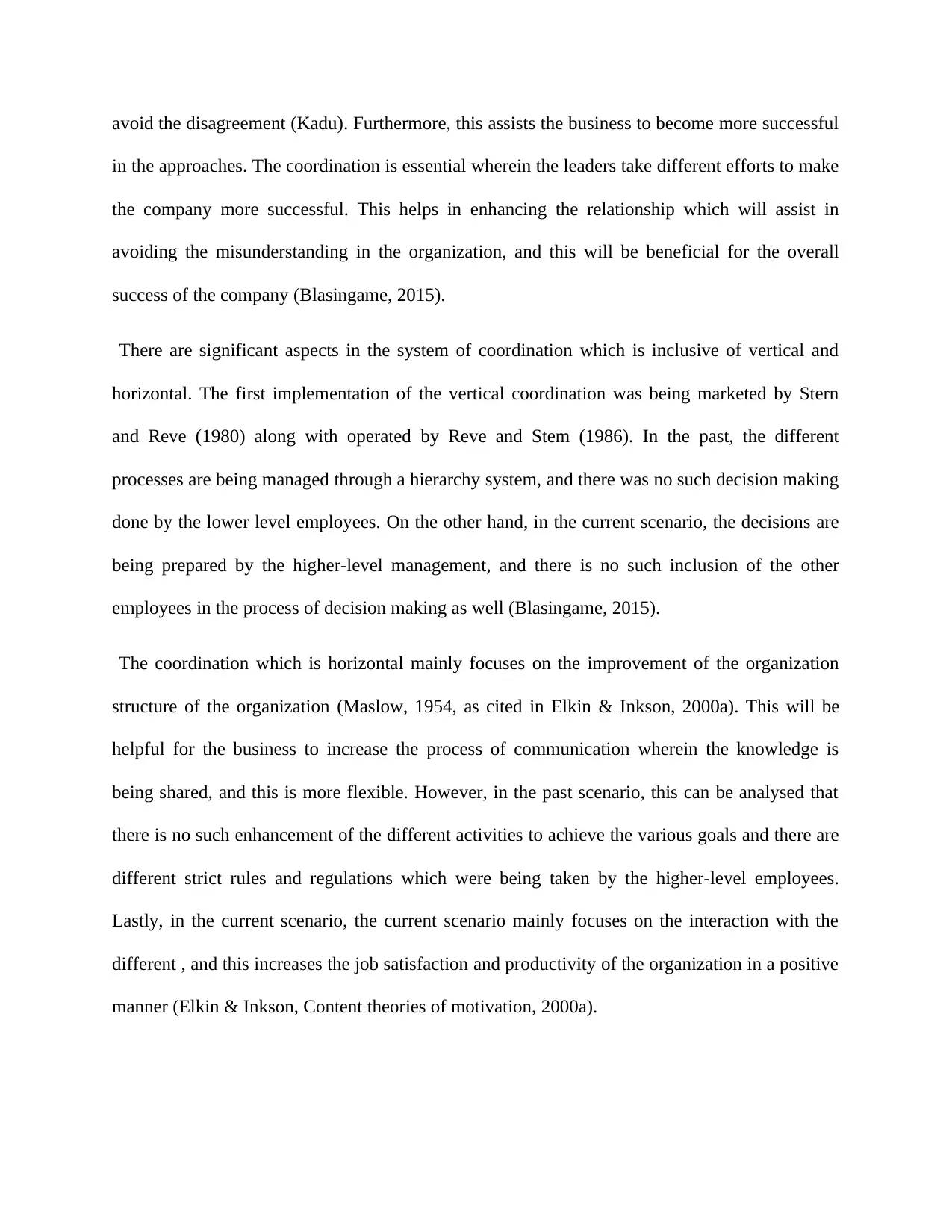
avoid the disagreement (Kadu). Furthermore, this assists the business to become more successful
in the approaches. The coordination is essential wherein the leaders take different efforts to make
the company more successful. This helps in enhancing the relationship which will assist in
avoiding the misunderstanding in the organization, and this will be beneficial for the overall
success of the company (Blasingame, 2015).
There are significant aspects in the system of coordination which is inclusive of vertical and
horizontal. The first implementation of the vertical coordination was being marketed by Stern
and Reve (1980) along with operated by Reve and Stem (1986). In the past, the different
processes are being managed through a hierarchy system, and there was no such decision making
done by the lower level employees. On the other hand, in the current scenario, the decisions are
being prepared by the higher-level management, and there is no such inclusion of the other
employees in the process of decision making as well (Blasingame, 2015).
The coordination which is horizontal mainly focuses on the improvement of the organization
structure of the organization (Maslow, 1954, as cited in Elkin & Inkson, 2000a). This will be
helpful for the business to increase the process of communication wherein the knowledge is
being shared, and this is more flexible. However, in the past scenario, this can be analysed that
there is no such enhancement of the different activities to achieve the various goals and there are
different strict rules and regulations which were being taken by the higher-level employees.
Lastly, in the current scenario, the current scenario mainly focuses on the interaction with the
different , and this increases the job satisfaction and productivity of the organization in a positive
manner (Elkin & Inkson, Content theories of motivation, 2000a).
in the approaches. The coordination is essential wherein the leaders take different efforts to make
the company more successful. This helps in enhancing the relationship which will assist in
avoiding the misunderstanding in the organization, and this will be beneficial for the overall
success of the company (Blasingame, 2015).
There are significant aspects in the system of coordination which is inclusive of vertical and
horizontal. The first implementation of the vertical coordination was being marketed by Stern
and Reve (1980) along with operated by Reve and Stem (1986). In the past, the different
processes are being managed through a hierarchy system, and there was no such decision making
done by the lower level employees. On the other hand, in the current scenario, the decisions are
being prepared by the higher-level management, and there is no such inclusion of the other
employees in the process of decision making as well (Blasingame, 2015).
The coordination which is horizontal mainly focuses on the improvement of the organization
structure of the organization (Maslow, 1954, as cited in Elkin & Inkson, 2000a). This will be
helpful for the business to increase the process of communication wherein the knowledge is
being shared, and this is more flexible. However, in the past scenario, this can be analysed that
there is no such enhancement of the different activities to achieve the various goals and there are
different strict rules and regulations which were being taken by the higher-level employees.
Lastly, in the current scenario, the current scenario mainly focuses on the interaction with the
different , and this increases the job satisfaction and productivity of the organization in a positive
manner (Elkin & Inkson, Content theories of motivation, 2000a).
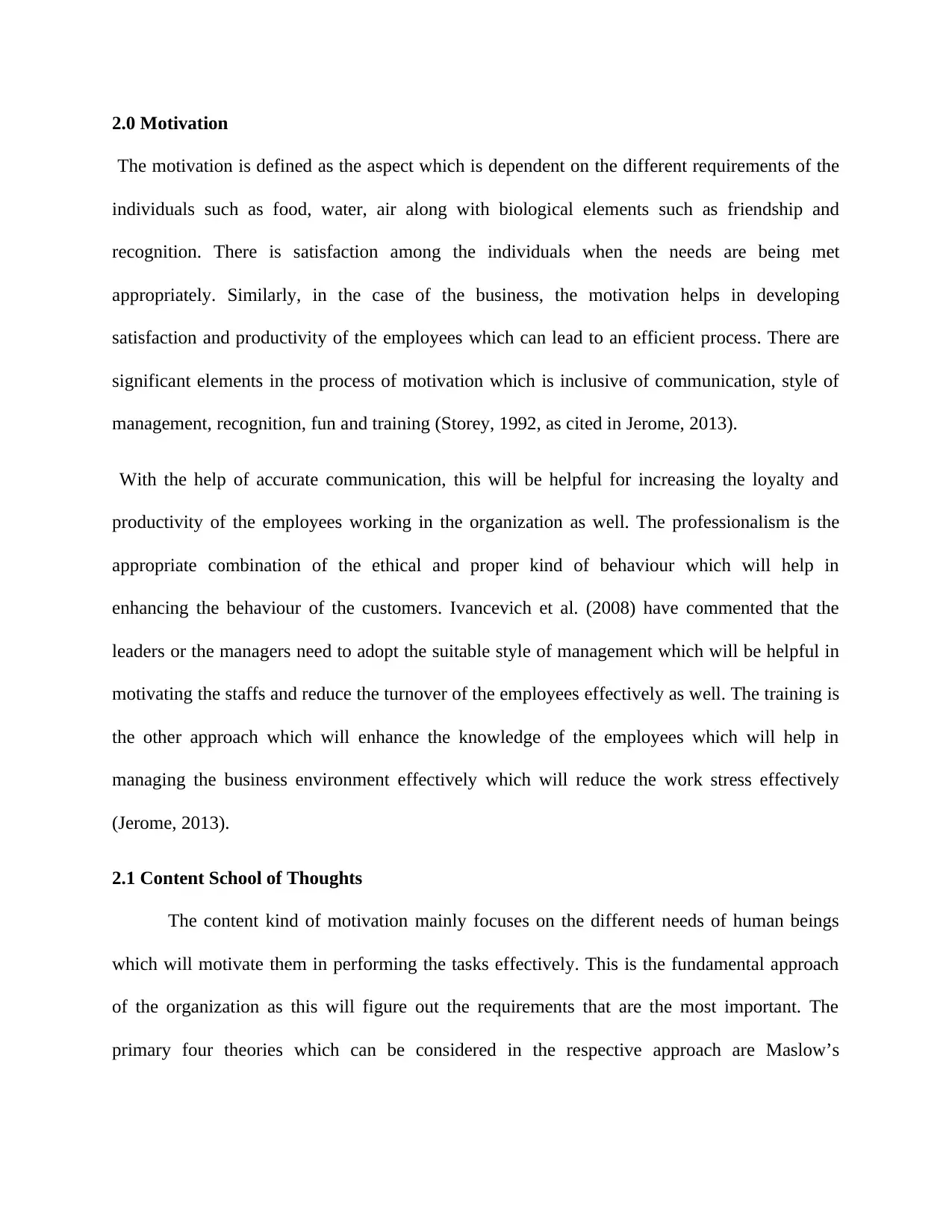
2.0 Motivation
The motivation is defined as the aspect which is dependent on the different requirements of the
individuals such as food, water, air along with biological elements such as friendship and
recognition. There is satisfaction among the individuals when the needs are being met
appropriately. Similarly, in the case of the business, the motivation helps in developing
satisfaction and productivity of the employees which can lead to an efficient process. There are
significant elements in the process of motivation which is inclusive of communication, style of
management, recognition, fun and training (Storey, 1992, as cited in Jerome, 2013).
With the help of accurate communication, this will be helpful for increasing the loyalty and
productivity of the employees working in the organization as well. The professionalism is the
appropriate combination of the ethical and proper kind of behaviour which will help in
enhancing the behaviour of the customers. Ivancevich et al. (2008) have commented that the
leaders or the managers need to adopt the suitable style of management which will be helpful in
motivating the staffs and reduce the turnover of the employees effectively as well. The training is
the other approach which will enhance the knowledge of the employees which will help in
managing the business environment effectively which will reduce the work stress effectively
(Jerome, 2013).
2.1 Content School of Thoughts
The content kind of motivation mainly focuses on the different needs of human beings
which will motivate them in performing the tasks effectively. This is the fundamental approach
of the organization as this will figure out the requirements that are the most important. The
primary four theories which can be considered in the respective approach are Maslow’s
The motivation is defined as the aspect which is dependent on the different requirements of the
individuals such as food, water, air along with biological elements such as friendship and
recognition. There is satisfaction among the individuals when the needs are being met
appropriately. Similarly, in the case of the business, the motivation helps in developing
satisfaction and productivity of the employees which can lead to an efficient process. There are
significant elements in the process of motivation which is inclusive of communication, style of
management, recognition, fun and training (Storey, 1992, as cited in Jerome, 2013).
With the help of accurate communication, this will be helpful for increasing the loyalty and
productivity of the employees working in the organization as well. The professionalism is the
appropriate combination of the ethical and proper kind of behaviour which will help in
enhancing the behaviour of the customers. Ivancevich et al. (2008) have commented that the
leaders or the managers need to adopt the suitable style of management which will be helpful in
motivating the staffs and reduce the turnover of the employees effectively as well. The training is
the other approach which will enhance the knowledge of the employees which will help in
managing the business environment effectively which will reduce the work stress effectively
(Jerome, 2013).
2.1 Content School of Thoughts
The content kind of motivation mainly focuses on the different needs of human beings
which will motivate them in performing the tasks effectively. This is the fundamental approach
of the organization as this will figure out the requirements that are the most important. The
primary four theories which can be considered in the respective approach are Maslow’s
Secure Best Marks with AI Grader
Need help grading? Try our AI Grader for instant feedback on your assignments.
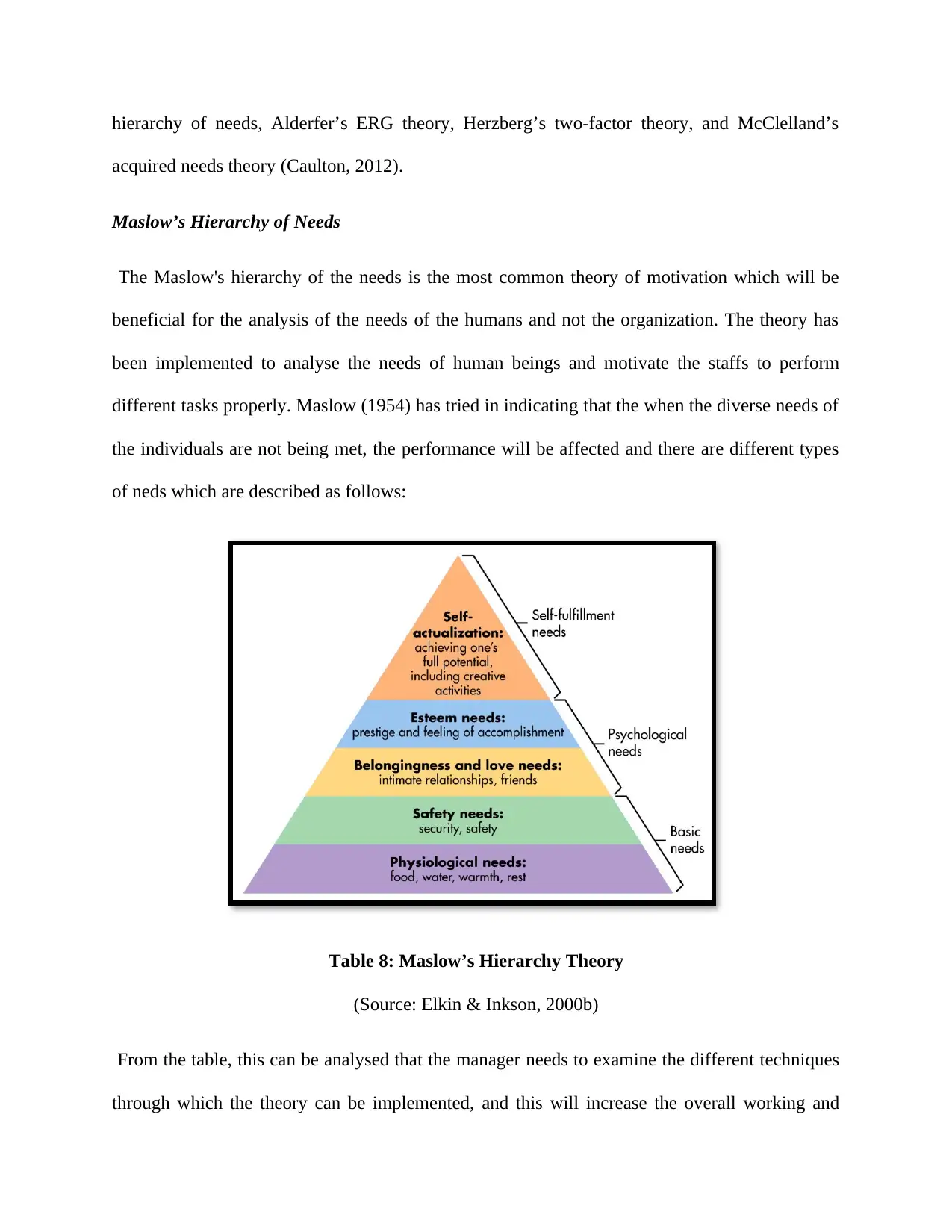
hierarchy of needs, Alderfer’s ERG theory, Herzberg’s two-factor theory, and McClelland’s
acquired needs theory (Caulton, 2012).
Maslow’s Hierarchy of Needs
The Maslow's hierarchy of the needs is the most common theory of motivation which will be
beneficial for the analysis of the needs of the humans and not the organization. The theory has
been implemented to analyse the needs of human beings and motivate the staffs to perform
different tasks properly. Maslow (1954) has tried in indicating that the when the diverse needs of
the individuals are not being met, the performance will be affected and there are different types
of neds which are described as follows:
Table 8: Maslow’s Hierarchy Theory
(Source: Elkin & Inkson, 2000b)
From the table, this can be analysed that the manager needs to examine the different techniques
through which the theory can be implemented, and this will increase the overall working and
acquired needs theory (Caulton, 2012).
Maslow’s Hierarchy of Needs
The Maslow's hierarchy of the needs is the most common theory of motivation which will be
beneficial for the analysis of the needs of the humans and not the organization. The theory has
been implemented to analyse the needs of human beings and motivate the staffs to perform
different tasks properly. Maslow (1954) has tried in indicating that the when the diverse needs of
the individuals are not being met, the performance will be affected and there are different types
of neds which are described as follows:
Table 8: Maslow’s Hierarchy Theory
(Source: Elkin & Inkson, 2000b)
From the table, this can be analysed that the manager needs to examine the different techniques
through which the theory can be implemented, and this will increase the overall working and
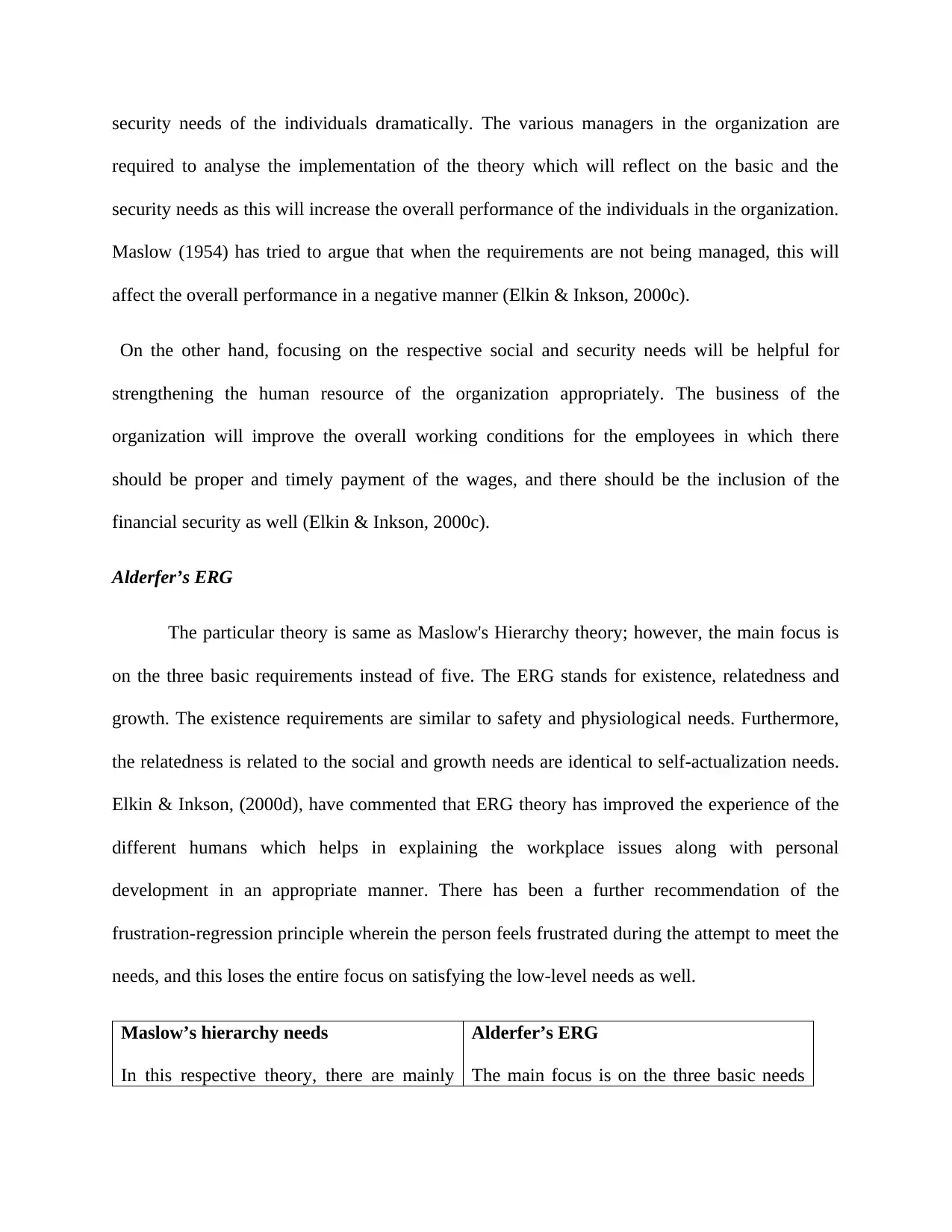
security needs of the individuals dramatically. The various managers in the organization are
required to analyse the implementation of the theory which will reflect on the basic and the
security needs as this will increase the overall performance of the individuals in the organization.
Maslow (1954) has tried to argue that when the requirements are not being managed, this will
affect the overall performance in a negative manner (Elkin & Inkson, 2000c).
On the other hand, focusing on the respective social and security needs will be helpful for
strengthening the human resource of the organization appropriately. The business of the
organization will improve the overall working conditions for the employees in which there
should be proper and timely payment of the wages, and there should be the inclusion of the
financial security as well (Elkin & Inkson, 2000c).
Alderfer’s ERG
The particular theory is same as Maslow's Hierarchy theory; however, the main focus is
on the three basic requirements instead of five. The ERG stands for existence, relatedness and
growth. The existence requirements are similar to safety and physiological needs. Furthermore,
the relatedness is related to the social and growth needs are identical to self-actualization needs.
Elkin & Inkson, (2000d), have commented that ERG theory has improved the experience of the
different humans which helps in explaining the workplace issues along with personal
development in an appropriate manner. There has been a further recommendation of the
frustration-regression principle wherein the person feels frustrated during the attempt to meet the
needs, and this loses the entire focus on satisfying the low-level needs as well.
Maslow’s hierarchy needs
In this respective theory, there are mainly
Alderfer’s ERG
The main focus is on the three basic needs
required to analyse the implementation of the theory which will reflect on the basic and the
security needs as this will increase the overall performance of the individuals in the organization.
Maslow (1954) has tried to argue that when the requirements are not being managed, this will
affect the overall performance in a negative manner (Elkin & Inkson, 2000c).
On the other hand, focusing on the respective social and security needs will be helpful for
strengthening the human resource of the organization appropriately. The business of the
organization will improve the overall working conditions for the employees in which there
should be proper and timely payment of the wages, and there should be the inclusion of the
financial security as well (Elkin & Inkson, 2000c).
Alderfer’s ERG
The particular theory is same as Maslow's Hierarchy theory; however, the main focus is
on the three basic requirements instead of five. The ERG stands for existence, relatedness and
growth. The existence requirements are similar to safety and physiological needs. Furthermore,
the relatedness is related to the social and growth needs are identical to self-actualization needs.
Elkin & Inkson, (2000d), have commented that ERG theory has improved the experience of the
different humans which helps in explaining the workplace issues along with personal
development in an appropriate manner. There has been a further recommendation of the
frustration-regression principle wherein the person feels frustrated during the attempt to meet the
needs, and this loses the entire focus on satisfying the low-level needs as well.
Maslow’s hierarchy needs
In this respective theory, there are mainly
Alderfer’s ERG
The main focus is on the three basic needs
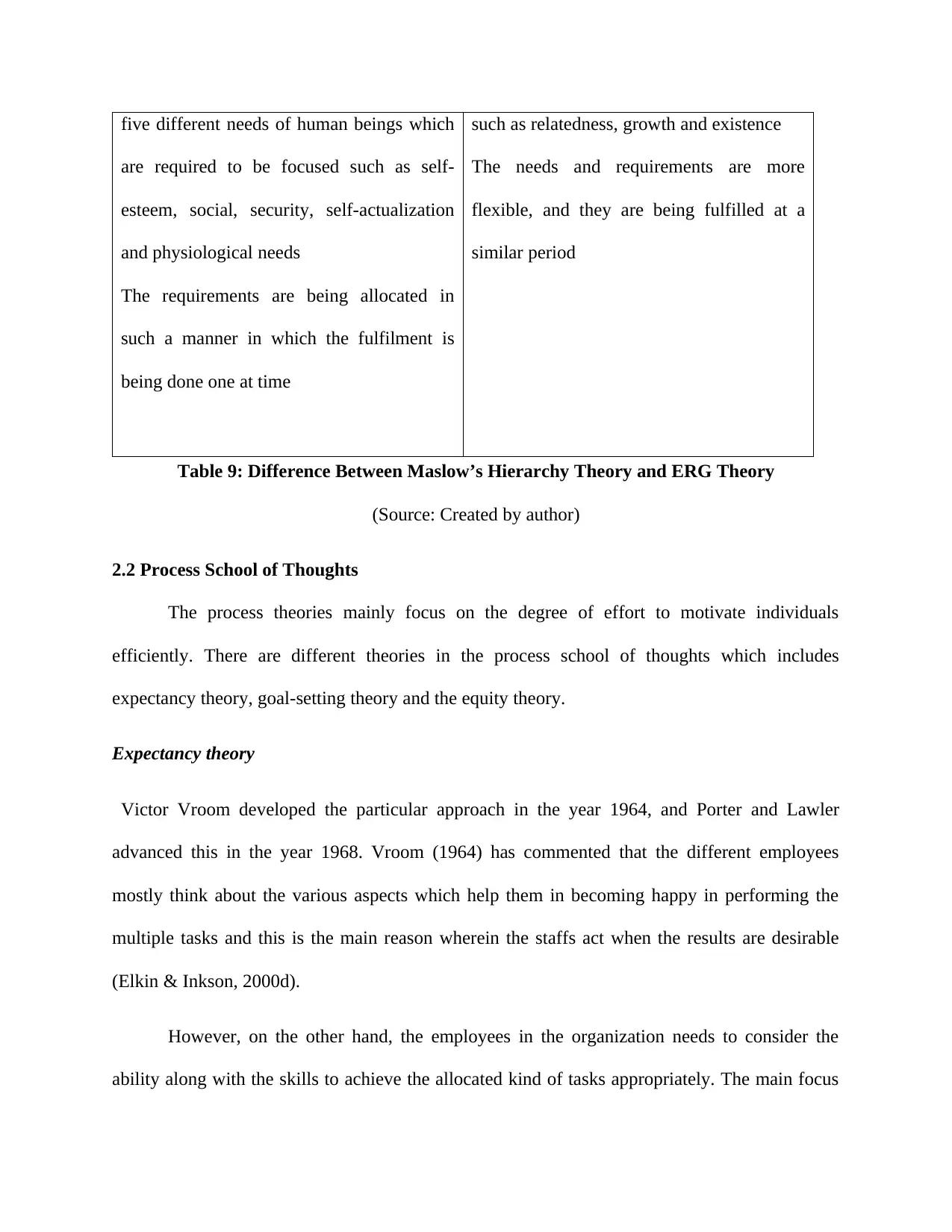
five different needs of human beings which
are required to be focused such as self-
esteem, social, security, self-actualization
and physiological needs
The requirements are being allocated in
such a manner in which the fulfilment is
being done one at time
such as relatedness, growth and existence
The needs and requirements are more
flexible, and they are being fulfilled at a
similar period
Table 9: Difference Between Maslow’s Hierarchy Theory and ERG Theory
(Source: Created by author)
2.2 Process School of Thoughts
The process theories mainly focus on the degree of effort to motivate individuals
efficiently. There are different theories in the process school of thoughts which includes
expectancy theory, goal-setting theory and the equity theory.
Expectancy theory
Victor Vroom developed the particular approach in the year 1964, and Porter and Lawler
advanced this in the year 1968. Vroom (1964) has commented that the different employees
mostly think about the various aspects which help them in becoming happy in performing the
multiple tasks and this is the main reason wherein the staffs act when the results are desirable
(Elkin & Inkson, 2000d).
However, on the other hand, the employees in the organization needs to consider the
ability along with the skills to achieve the allocated kind of tasks appropriately. The main focus
are required to be focused such as self-
esteem, social, security, self-actualization
and physiological needs
The requirements are being allocated in
such a manner in which the fulfilment is
being done one at time
such as relatedness, growth and existence
The needs and requirements are more
flexible, and they are being fulfilled at a
similar period
Table 9: Difference Between Maslow’s Hierarchy Theory and ERG Theory
(Source: Created by author)
2.2 Process School of Thoughts
The process theories mainly focus on the degree of effort to motivate individuals
efficiently. There are different theories in the process school of thoughts which includes
expectancy theory, goal-setting theory and the equity theory.
Expectancy theory
Victor Vroom developed the particular approach in the year 1964, and Porter and Lawler
advanced this in the year 1968. Vroom (1964) has commented that the different employees
mostly think about the various aspects which help them in becoming happy in performing the
multiple tasks and this is the main reason wherein the staffs act when the results are desirable
(Elkin & Inkson, 2000d).
However, on the other hand, the employees in the organization needs to consider the
ability along with the skills to achieve the allocated kind of tasks appropriately. The main focus
Paraphrase This Document
Need a fresh take? Get an instant paraphrase of this document with our AI Paraphraser
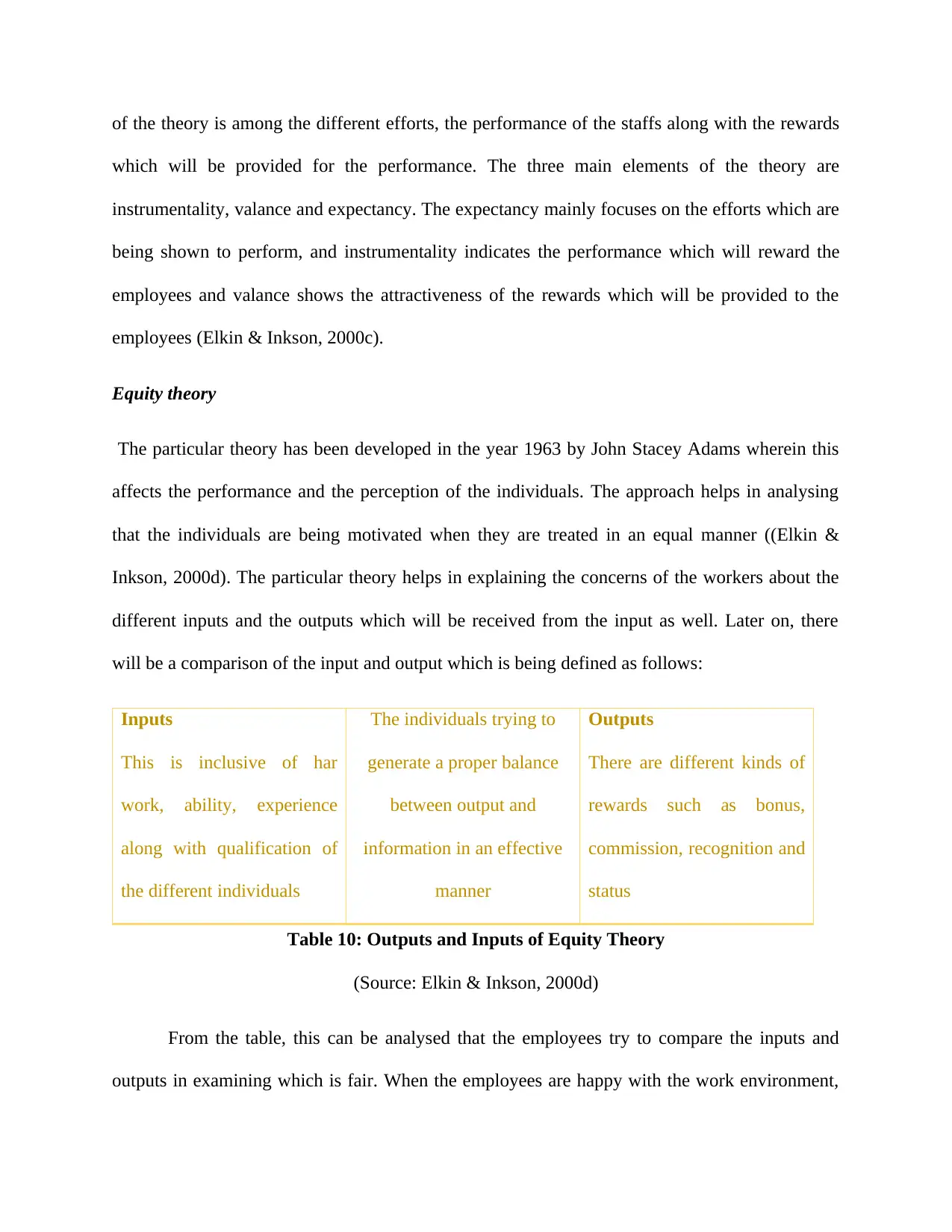
of the theory is among the different efforts, the performance of the staffs along with the rewards
which will be provided for the performance. The three main elements of the theory are
instrumentality, valance and expectancy. The expectancy mainly focuses on the efforts which are
being shown to perform, and instrumentality indicates the performance which will reward the
employees and valance shows the attractiveness of the rewards which will be provided to the
employees (Elkin & Inkson, 2000c).
Equity theory
The particular theory has been developed in the year 1963 by John Stacey Adams wherein this
affects the performance and the perception of the individuals. The approach helps in analysing
that the individuals are being motivated when they are treated in an equal manner ((Elkin &
Inkson, 2000d). The particular theory helps in explaining the concerns of the workers about the
different inputs and the outputs which will be received from the input as well. Later on, there
will be a comparison of the input and output which is being defined as follows:
Inputs
This is inclusive of har
work, ability, experience
along with qualification of
the different individuals
The individuals trying to
generate a proper balance
between output and
information in an effective
manner
Outputs
There are different kinds of
rewards such as bonus,
commission, recognition and
status
Table 10: Outputs and Inputs of Equity Theory
(Source: Elkin & Inkson, 2000d)
From the table, this can be analysed that the employees try to compare the inputs and
outputs in examining which is fair. When the employees are happy with the work environment,
which will be provided for the performance. The three main elements of the theory are
instrumentality, valance and expectancy. The expectancy mainly focuses on the efforts which are
being shown to perform, and instrumentality indicates the performance which will reward the
employees and valance shows the attractiveness of the rewards which will be provided to the
employees (Elkin & Inkson, 2000c).
Equity theory
The particular theory has been developed in the year 1963 by John Stacey Adams wherein this
affects the performance and the perception of the individuals. The approach helps in analysing
that the individuals are being motivated when they are treated in an equal manner ((Elkin &
Inkson, 2000d). The particular theory helps in explaining the concerns of the workers about the
different inputs and the outputs which will be received from the input as well. Later on, there
will be a comparison of the input and output which is being defined as follows:
Inputs
This is inclusive of har
work, ability, experience
along with qualification of
the different individuals
The individuals trying to
generate a proper balance
between output and
information in an effective
manner
Outputs
There are different kinds of
rewards such as bonus,
commission, recognition and
status
Table 10: Outputs and Inputs of Equity Theory
(Source: Elkin & Inkson, 2000d)
From the table, this can be analysed that the employees try to compare the inputs and
outputs in examining which is fair. When the employees are happy with the work environment,
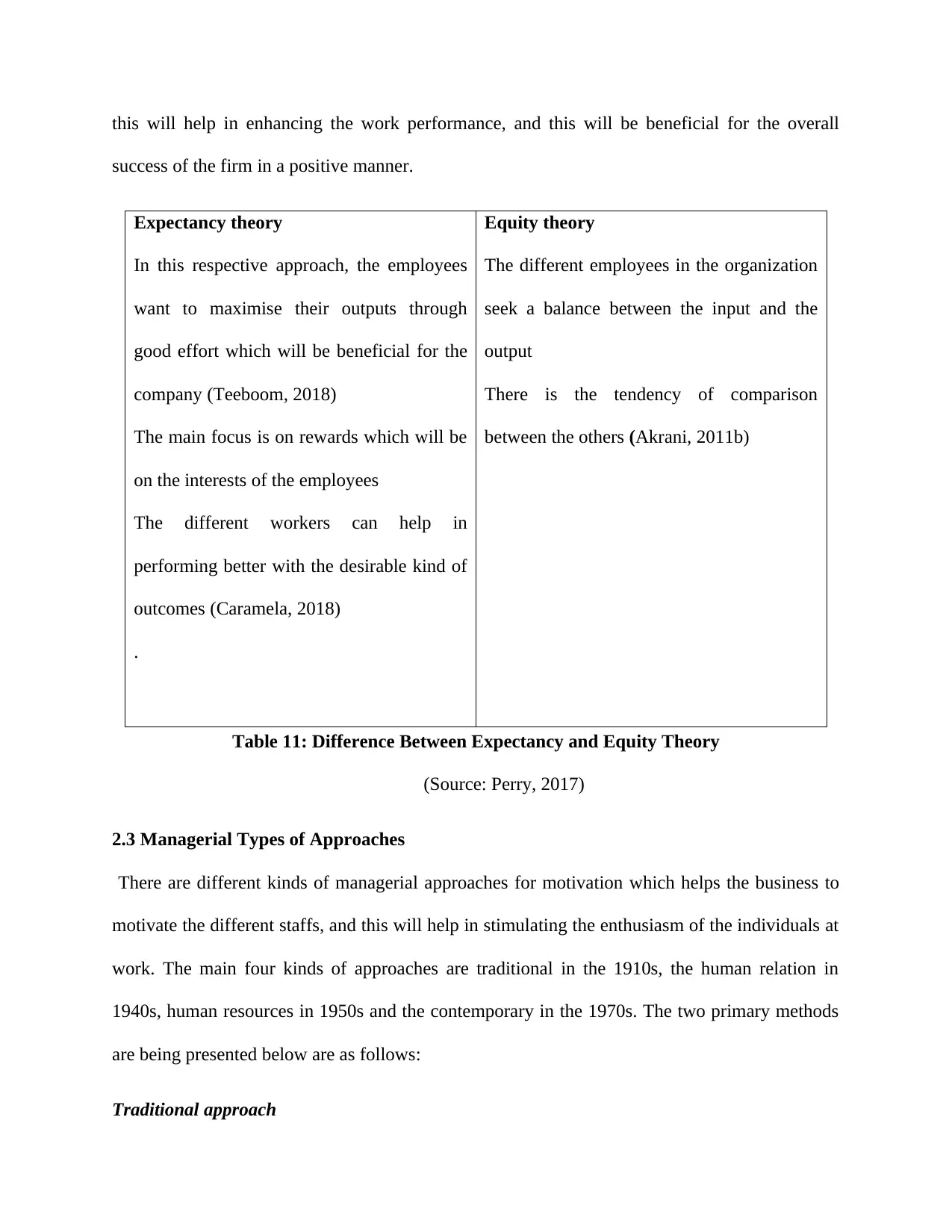
this will help in enhancing the work performance, and this will be beneficial for the overall
success of the firm in a positive manner.
Expectancy theory
In this respective approach, the employees
want to maximise their outputs through
good effort which will be beneficial for the
company (Teeboom, 2018)
The main focus is on rewards which will be
on the interests of the employees
The different workers can help in
performing better with the desirable kind of
outcomes (Caramela, 2018)
.
Equity theory
The different employees in the organization
seek a balance between the input and the
output
There is the tendency of comparison
between the others (Akrani, 2011b)
Table 11: Difference Between Expectancy and Equity Theory
(Source: Perry, 2017)
2.3 Managerial Types of Approaches
There are different kinds of managerial approaches for motivation which helps the business to
motivate the different staffs, and this will help in stimulating the enthusiasm of the individuals at
work. The main four kinds of approaches are traditional in the 1910s, the human relation in
1940s, human resources in 1950s and the contemporary in the 1970s. The two primary methods
are being presented below are as follows:
Traditional approach
success of the firm in a positive manner.
Expectancy theory
In this respective approach, the employees
want to maximise their outputs through
good effort which will be beneficial for the
company (Teeboom, 2018)
The main focus is on rewards which will be
on the interests of the employees
The different workers can help in
performing better with the desirable kind of
outcomes (Caramela, 2018)
.
Equity theory
The different employees in the organization
seek a balance between the input and the
output
There is the tendency of comparison
between the others (Akrani, 2011b)
Table 11: Difference Between Expectancy and Equity Theory
(Source: Perry, 2017)
2.3 Managerial Types of Approaches
There are different kinds of managerial approaches for motivation which helps the business to
motivate the different staffs, and this will help in stimulating the enthusiasm of the individuals at
work. The main four kinds of approaches are traditional in the 1910s, the human relation in
1940s, human resources in 1950s and the contemporary in the 1970s. The two primary methods
are being presented below are as follows:
Traditional approach

The traditional approach was founded and created by Frederic W. Taylor from the era of the
1890s wherein the motivation of the employees is being analysed with economic gain. Taylor
has claimed that the workers in the organization will perform well when the pay is higher, and
this will enhance the overall productivity of the organization positively as well. The theory
focuses on the money which is the primary motivator for managing the different demands of the
customers in an efficient manner (Perry, 2017). However, on the other hand, there are different
kinds of criticisms of the traditional approach wherein this has been seen that only money is
considered as the motivator and the employees are made to work like machines. There is no such
recognition which is being provided to employees (Petryni, 2018).
On the other hand, the traditional approach helps the business in controlling the business
processes and objectives which are easy to achieve, and this helps in gaining competitive
advantage. The manager tries to supervise and ensures that the workers are performing the
different jobs in such a manner which will be beneficial for the improvement of the performance
in an efficient way (Weike et al., 2015).
Human relation approach
The particular theory was mainly introduced in the 1920s by Elton Mayo wherein this
showcased that the individuals are the major part of the business which helps them in achieving
the success. The approach felt that the employees are part of the organization and they are not the
machine wherein human plays a vital role in the growth and development of the business. These
will help in increasing the morale of the employees, and this will enhance and improve the
quality of the work which is being performed by the employees in an efficient manner (Weike et
al. 2015).
1890s wherein the motivation of the employees is being analysed with economic gain. Taylor
has claimed that the workers in the organization will perform well when the pay is higher, and
this will enhance the overall productivity of the organization positively as well. The theory
focuses on the money which is the primary motivator for managing the different demands of the
customers in an efficient manner (Perry, 2017). However, on the other hand, there are different
kinds of criticisms of the traditional approach wherein this has been seen that only money is
considered as the motivator and the employees are made to work like machines. There is no such
recognition which is being provided to employees (Petryni, 2018).
On the other hand, the traditional approach helps the business in controlling the business
processes and objectives which are easy to achieve, and this helps in gaining competitive
advantage. The manager tries to supervise and ensures that the workers are performing the
different jobs in such a manner which will be beneficial for the improvement of the performance
in an efficient way (Weike et al., 2015).
Human relation approach
The particular theory was mainly introduced in the 1920s by Elton Mayo wherein this
showcased that the individuals are the major part of the business which helps them in achieving
the success. The approach felt that the employees are part of the organization and they are not the
machine wherein human plays a vital role in the growth and development of the business. These
will help in increasing the morale of the employees, and this will enhance and improve the
quality of the work which is being performed by the employees in an efficient manner (Weike et
al. 2015).
Secure Best Marks with AI Grader
Need help grading? Try our AI Grader for instant feedback on your assignments.
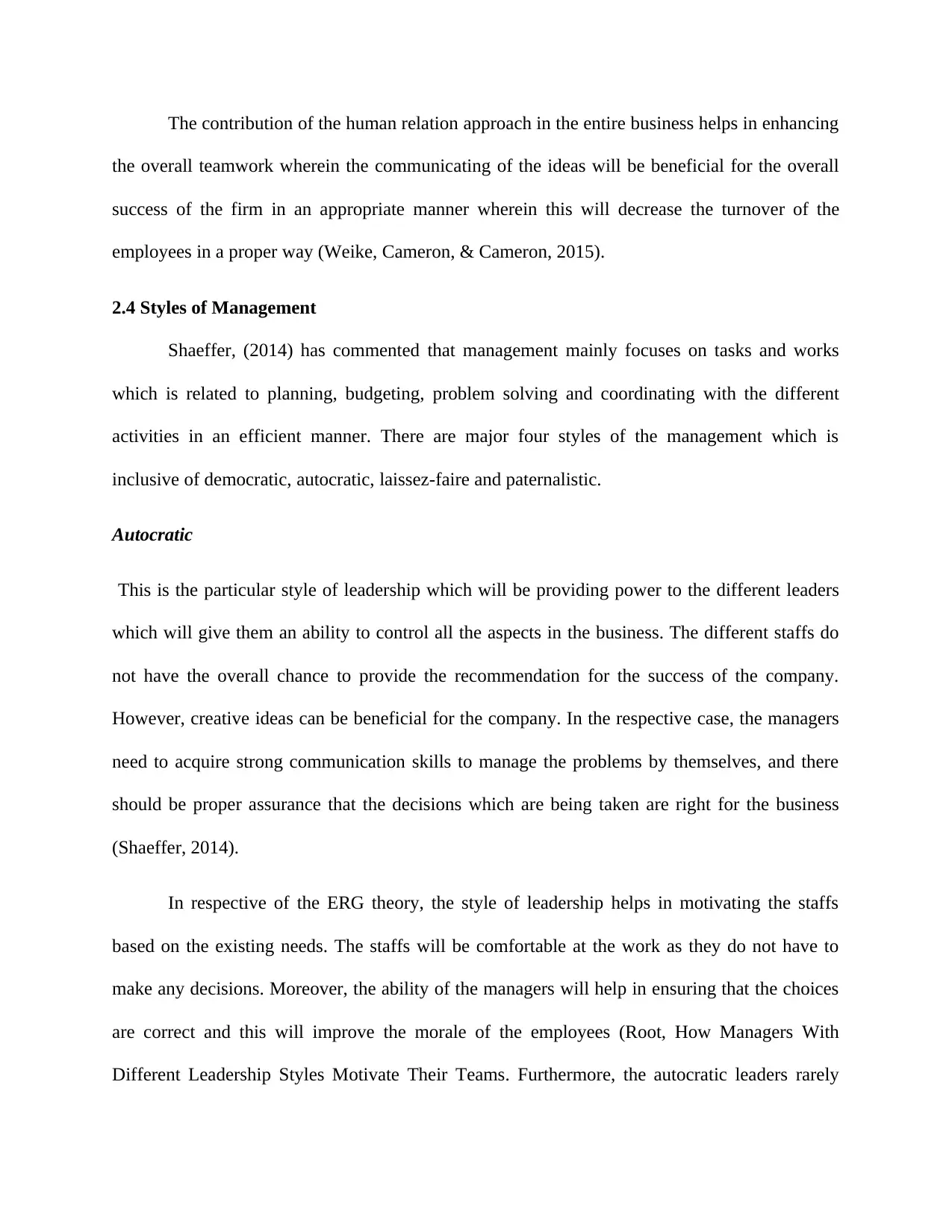
The contribution of the human relation approach in the entire business helps in enhancing
the overall teamwork wherein the communicating of the ideas will be beneficial for the overall
success of the firm in an appropriate manner wherein this will decrease the turnover of the
employees in a proper way (Weike, Cameron, & Cameron, 2015).
2.4 Styles of Management
Shaeffer, (2014) has commented that management mainly focuses on tasks and works
which is related to planning, budgeting, problem solving and coordinating with the different
activities in an efficient manner. There are major four styles of the management which is
inclusive of democratic, autocratic, laissez-faire and paternalistic.
Autocratic
This is the particular style of leadership which will be providing power to the different leaders
which will give them an ability to control all the aspects in the business. The different staffs do
not have the overall chance to provide the recommendation for the success of the company.
However, creative ideas can be beneficial for the company. In the respective case, the managers
need to acquire strong communication skills to manage the problems by themselves, and there
should be proper assurance that the decisions which are being taken are right for the business
(Shaeffer, 2014).
In respective of the ERG theory, the style of leadership helps in motivating the staffs
based on the existing needs. The staffs will be comfortable at the work as they do not have to
make any decisions. Moreover, the ability of the managers will help in ensuring that the choices
are correct and this will improve the morale of the employees (Root, How Managers With
Different Leadership Styles Motivate Their Teams. Furthermore, the autocratic leaders rarely
the overall teamwork wherein the communicating of the ideas will be beneficial for the overall
success of the firm in an appropriate manner wherein this will decrease the turnover of the
employees in a proper way (Weike, Cameron, & Cameron, 2015).
2.4 Styles of Management
Shaeffer, (2014) has commented that management mainly focuses on tasks and works
which is related to planning, budgeting, problem solving and coordinating with the different
activities in an efficient manner. There are major four styles of the management which is
inclusive of democratic, autocratic, laissez-faire and paternalistic.
Autocratic
This is the particular style of leadership which will be providing power to the different leaders
which will give them an ability to control all the aspects in the business. The different staffs do
not have the overall chance to provide the recommendation for the success of the company.
However, creative ideas can be beneficial for the company. In the respective case, the managers
need to acquire strong communication skills to manage the problems by themselves, and there
should be proper assurance that the decisions which are being taken are right for the business
(Shaeffer, 2014).
In respective of the ERG theory, the style of leadership helps in motivating the staffs
based on the existing needs. The staffs will be comfortable at the work as they do not have to
make any decisions. Moreover, the ability of the managers will help in ensuring that the choices
are correct and this will improve the morale of the employees (Root, How Managers With
Different Leadership Styles Motivate Their Teams. Furthermore, the autocratic leaders rarely
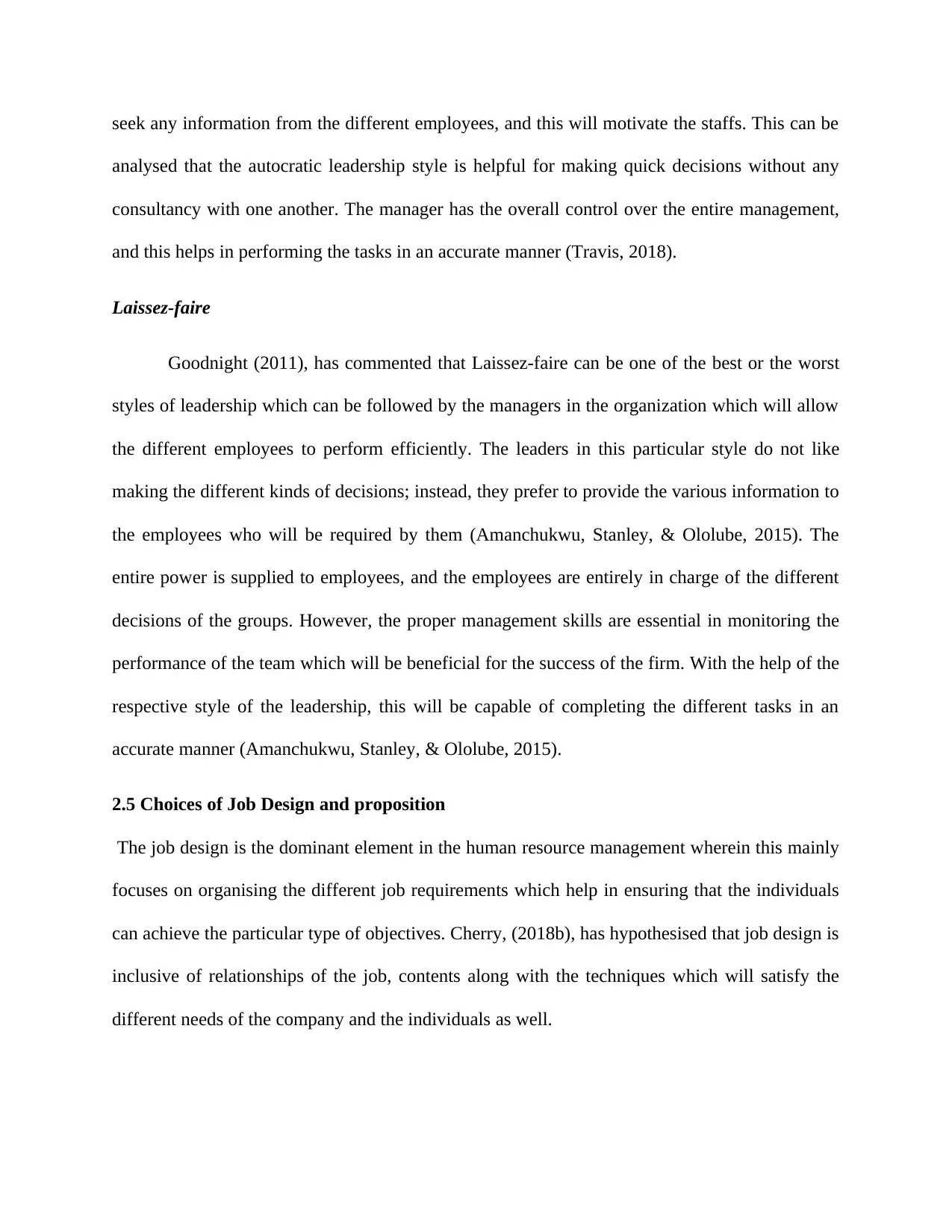
seek any information from the different employees, and this will motivate the staffs. This can be
analysed that the autocratic leadership style is helpful for making quick decisions without any
consultancy with one another. The manager has the overall control over the entire management,
and this helps in performing the tasks in an accurate manner (Travis, 2018).
Laissez-faire
Goodnight (2011), has commented that Laissez-faire can be one of the best or the worst
styles of leadership which can be followed by the managers in the organization which will allow
the different employees to perform efficiently. The leaders in this particular style do not like
making the different kinds of decisions; instead, they prefer to provide the various information to
the employees who will be required by them (Amanchukwu, Stanley, & Ololube, 2015). The
entire power is supplied to employees, and the employees are entirely in charge of the different
decisions of the groups. However, the proper management skills are essential in monitoring the
performance of the team which will be beneficial for the success of the firm. With the help of the
respective style of the leadership, this will be capable of completing the different tasks in an
accurate manner (Amanchukwu, Stanley, & Ololube, 2015).
2.5 Choices of Job Design and proposition
The job design is the dominant element in the human resource management wherein this mainly
focuses on organising the different job requirements which help in ensuring that the individuals
can achieve the particular type of objectives. Cherry, (2018b), has hypothesised that job design is
inclusive of relationships of the job, contents along with the techniques which will satisfy the
different needs of the company and the individuals as well.
analysed that the autocratic leadership style is helpful for making quick decisions without any
consultancy with one another. The manager has the overall control over the entire management,
and this helps in performing the tasks in an accurate manner (Travis, 2018).
Laissez-faire
Goodnight (2011), has commented that Laissez-faire can be one of the best or the worst
styles of leadership which can be followed by the managers in the organization which will allow
the different employees to perform efficiently. The leaders in this particular style do not like
making the different kinds of decisions; instead, they prefer to provide the various information to
the employees who will be required by them (Amanchukwu, Stanley, & Ololube, 2015). The
entire power is supplied to employees, and the employees are entirely in charge of the different
decisions of the groups. However, the proper management skills are essential in monitoring the
performance of the team which will be beneficial for the success of the firm. With the help of the
respective style of the leadership, this will be capable of completing the different tasks in an
accurate manner (Amanchukwu, Stanley, & Ololube, 2015).
2.5 Choices of Job Design and proposition
The job design is the dominant element in the human resource management wherein this mainly
focuses on organising the different job requirements which help in ensuring that the individuals
can achieve the particular type of objectives. Cherry, (2018b), has hypothesised that job design is
inclusive of relationships of the job, contents along with the techniques which will satisfy the
different needs of the company and the individuals as well.
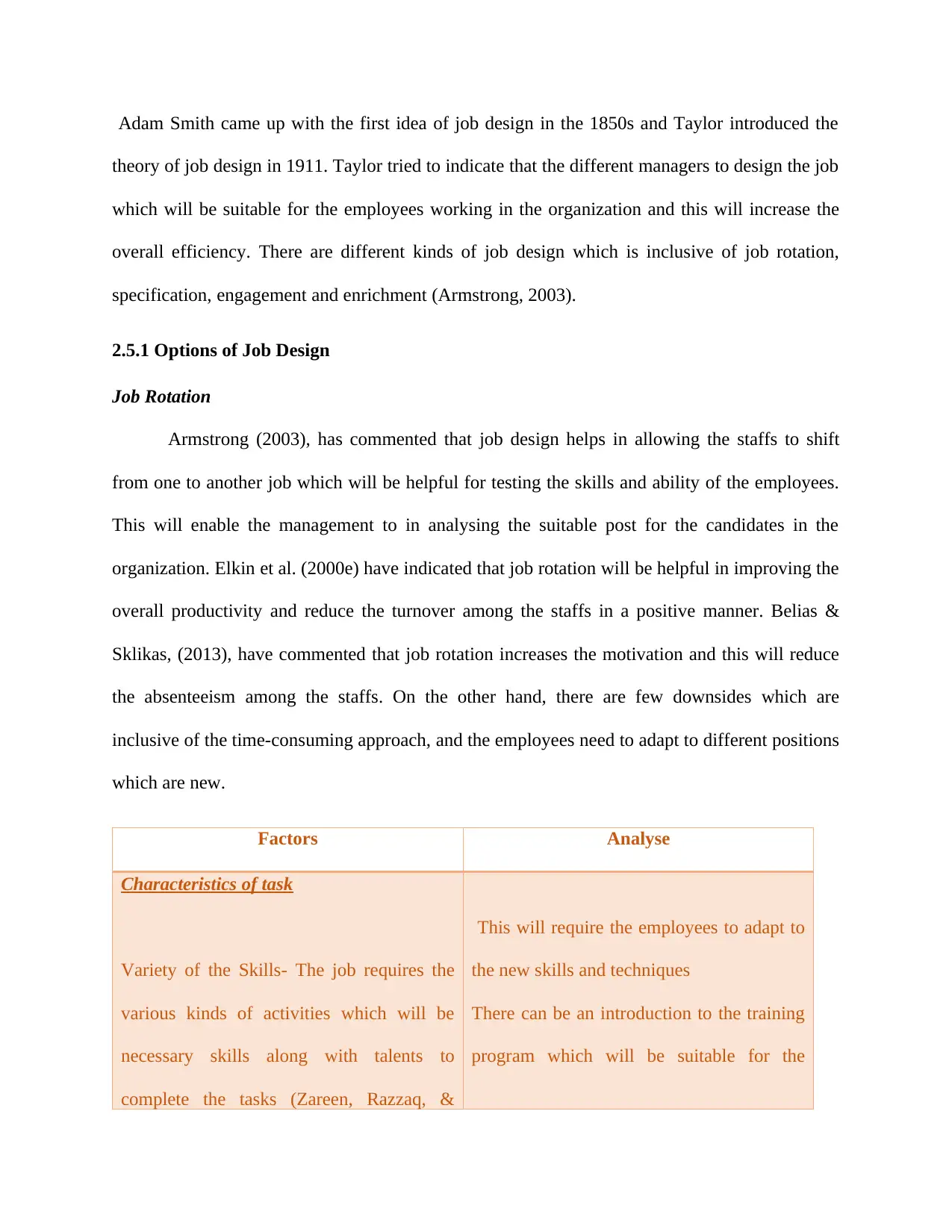
Adam Smith came up with the first idea of job design in the 1850s and Taylor introduced the
theory of job design in 1911. Taylor tried to indicate that the different managers to design the job
which will be suitable for the employees working in the organization and this will increase the
overall efficiency. There are different kinds of job design which is inclusive of job rotation,
specification, engagement and enrichment (Armstrong, 2003).
2.5.1 Options of Job Design
Job Rotation
Armstrong (2003), has commented that job design helps in allowing the staffs to shift
from one to another job which will be helpful for testing the skills and ability of the employees.
This will enable the management to in analysing the suitable post for the candidates in the
organization. Elkin et al. (2000e) have indicated that job rotation will be helpful in improving the
overall productivity and reduce the turnover among the staffs in a positive manner. Belias &
Sklikas, (2013), have commented that job rotation increases the motivation and this will reduce
the absenteeism among the staffs. On the other hand, there are few downsides which are
inclusive of the time-consuming approach, and the employees need to adapt to different positions
which are new.
Factors Analyse
Characteristics of task
Variety of the Skills- The job requires the
various kinds of activities which will be
necessary skills along with talents to
complete the tasks (Zareen, Razzaq, &
This will require the employees to adapt to
the new skills and techniques
There can be an introduction to the training
program which will be suitable for the
theory of job design in 1911. Taylor tried to indicate that the different managers to design the job
which will be suitable for the employees working in the organization and this will increase the
overall efficiency. There are different kinds of job design which is inclusive of job rotation,
specification, engagement and enrichment (Armstrong, 2003).
2.5.1 Options of Job Design
Job Rotation
Armstrong (2003), has commented that job design helps in allowing the staffs to shift
from one to another job which will be helpful for testing the skills and ability of the employees.
This will enable the management to in analysing the suitable post for the candidates in the
organization. Elkin et al. (2000e) have indicated that job rotation will be helpful in improving the
overall productivity and reduce the turnover among the staffs in a positive manner. Belias &
Sklikas, (2013), have commented that job rotation increases the motivation and this will reduce
the absenteeism among the staffs. On the other hand, there are few downsides which are
inclusive of the time-consuming approach, and the employees need to adapt to different positions
which are new.
Factors Analyse
Characteristics of task
Variety of the Skills- The job requires the
various kinds of activities which will be
necessary skills along with talents to
complete the tasks (Zareen, Razzaq, &
This will require the employees to adapt to
the new skills and techniques
There can be an introduction to the training
program which will be suitable for the
Paraphrase This Document
Need a fresh take? Get an instant paraphrase of this document with our AI Paraphraser
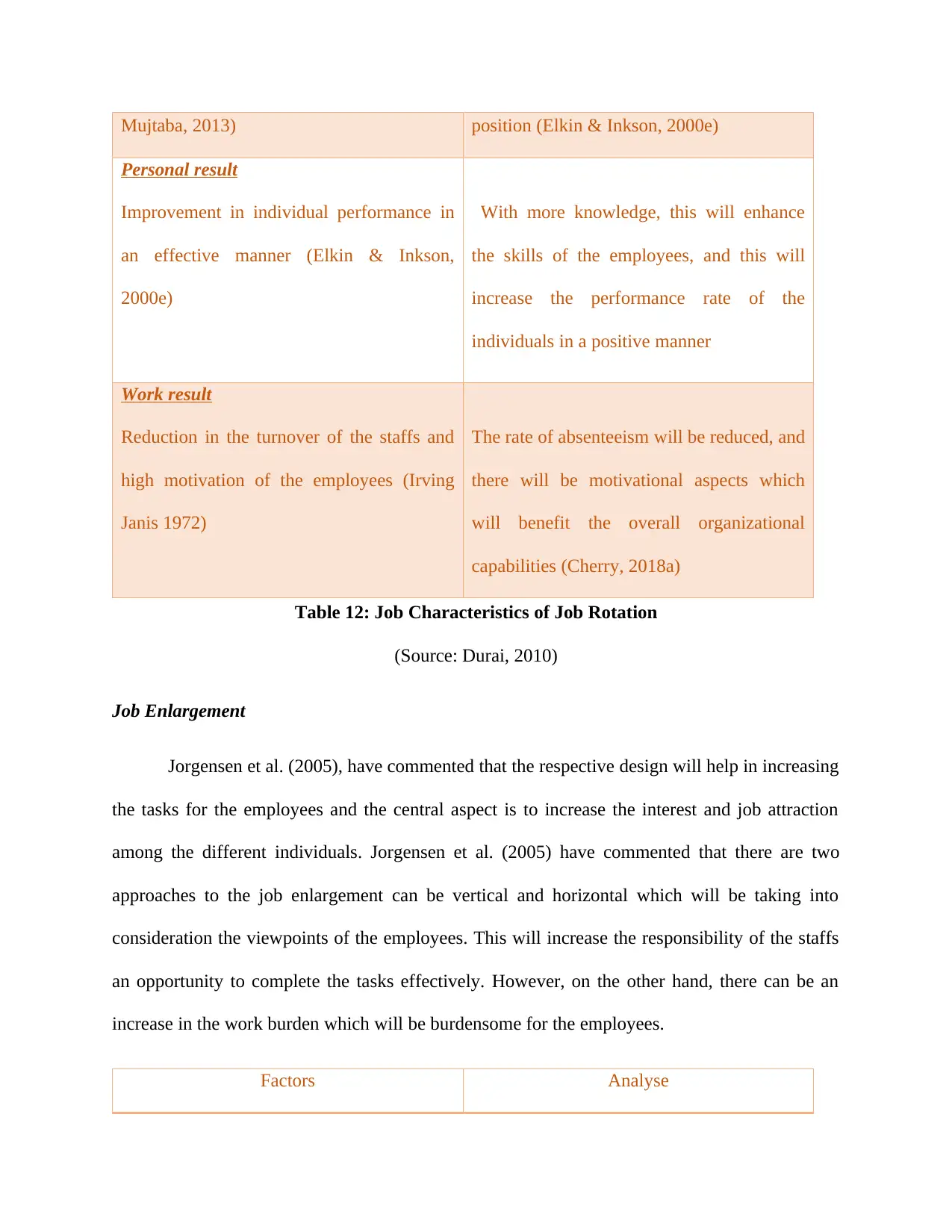
Mujtaba, 2013) position (Elkin & Inkson, 2000e)
Personal result
Improvement in individual performance in
an effective manner (Elkin & Inkson,
2000e)
With more knowledge, this will enhance
the skills of the employees, and this will
increase the performance rate of the
individuals in a positive manner
Work result
Reduction in the turnover of the staffs and
high motivation of the employees (Irving
Janis 1972)
The rate of absenteeism will be reduced, and
there will be motivational aspects which
will benefit the overall organizational
capabilities (Cherry, 2018a)
Table 12: Job Characteristics of Job Rotation
(Source: Durai, 2010)
Job Enlargement
Jorgensen et al. (2005), have commented that the respective design will help in increasing
the tasks for the employees and the central aspect is to increase the interest and job attraction
among the different individuals. Jorgensen et al. (2005) have commented that there are two
approaches to the job enlargement can be vertical and horizontal which will be taking into
consideration the viewpoints of the employees. This will increase the responsibility of the staffs
an opportunity to complete the tasks effectively. However, on the other hand, there can be an
increase in the work burden which will be burdensome for the employees.
Factors Analyse
Personal result
Improvement in individual performance in
an effective manner (Elkin & Inkson,
2000e)
With more knowledge, this will enhance
the skills of the employees, and this will
increase the performance rate of the
individuals in a positive manner
Work result
Reduction in the turnover of the staffs and
high motivation of the employees (Irving
Janis 1972)
The rate of absenteeism will be reduced, and
there will be motivational aspects which
will benefit the overall organizational
capabilities (Cherry, 2018a)
Table 12: Job Characteristics of Job Rotation
(Source: Durai, 2010)
Job Enlargement
Jorgensen et al. (2005), have commented that the respective design will help in increasing
the tasks for the employees and the central aspect is to increase the interest and job attraction
among the different individuals. Jorgensen et al. (2005) have commented that there are two
approaches to the job enlargement can be vertical and horizontal which will be taking into
consideration the viewpoints of the employees. This will increase the responsibility of the staffs
an opportunity to complete the tasks effectively. However, on the other hand, there can be an
increase in the work burden which will be burdensome for the employees.
Factors Analyse
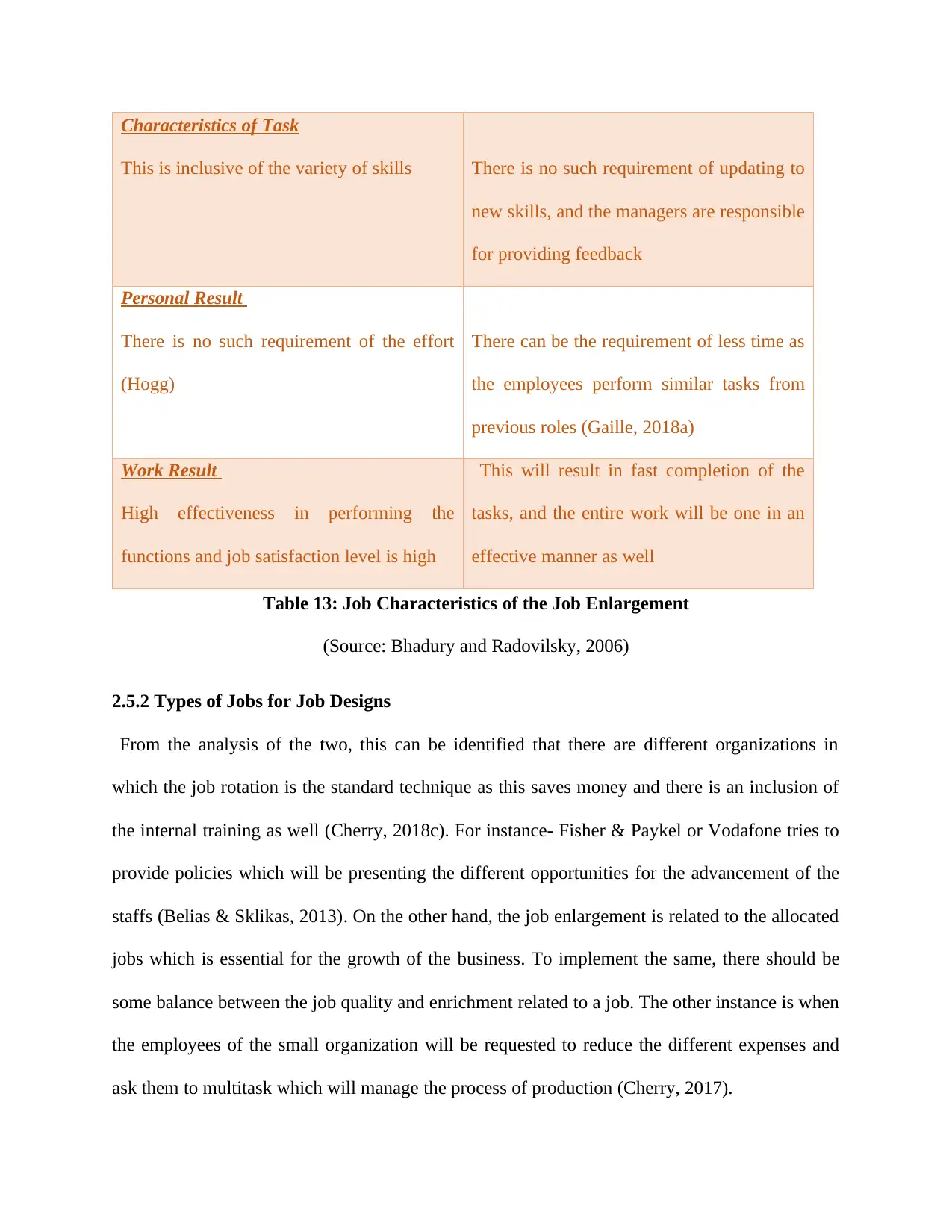
Characteristics of Task
This is inclusive of the variety of skills There is no such requirement of updating to
new skills, and the managers are responsible
for providing feedback
Personal Result
There is no such requirement of the effort
(Hogg)
There can be the requirement of less time as
the employees perform similar tasks from
previous roles (Gaille, 2018a)
Work Result
High effectiveness in performing the
functions and job satisfaction level is high
This will result in fast completion of the
tasks, and the entire work will be one in an
effective manner as well
Table 13: Job Characteristics of the Job Enlargement
(Source: Bhadury and Radovilsky, 2006)
2.5.2 Types of Jobs for Job Designs
From the analysis of the two, this can be identified that there are different organizations in
which the job rotation is the standard technique as this saves money and there is an inclusion of
the internal training as well (Cherry, 2018c). For instance- Fisher & Paykel or Vodafone tries to
provide policies which will be presenting the different opportunities for the advancement of the
staffs (Belias & Sklikas, 2013). On the other hand, the job enlargement is related to the allocated
jobs which is essential for the growth of the business. To implement the same, there should be
some balance between the job quality and enrichment related to a job. The other instance is when
the employees of the small organization will be requested to reduce the different expenses and
ask them to multitask which will manage the process of production (Cherry, 2017).
This is inclusive of the variety of skills There is no such requirement of updating to
new skills, and the managers are responsible
for providing feedback
Personal Result
There is no such requirement of the effort
(Hogg)
There can be the requirement of less time as
the employees perform similar tasks from
previous roles (Gaille, 2018a)
Work Result
High effectiveness in performing the
functions and job satisfaction level is high
This will result in fast completion of the
tasks, and the entire work will be one in an
effective manner as well
Table 13: Job Characteristics of the Job Enlargement
(Source: Bhadury and Radovilsky, 2006)
2.5.2 Types of Jobs for Job Designs
From the analysis of the two, this can be identified that there are different organizations in
which the job rotation is the standard technique as this saves money and there is an inclusion of
the internal training as well (Cherry, 2018c). For instance- Fisher & Paykel or Vodafone tries to
provide policies which will be presenting the different opportunities for the advancement of the
staffs (Belias & Sklikas, 2013). On the other hand, the job enlargement is related to the allocated
jobs which is essential for the growth of the business. To implement the same, there should be
some balance between the job quality and enrichment related to a job. The other instance is when
the employees of the small organization will be requested to reduce the different expenses and
ask them to multitask which will manage the process of production (Cherry, 2017).
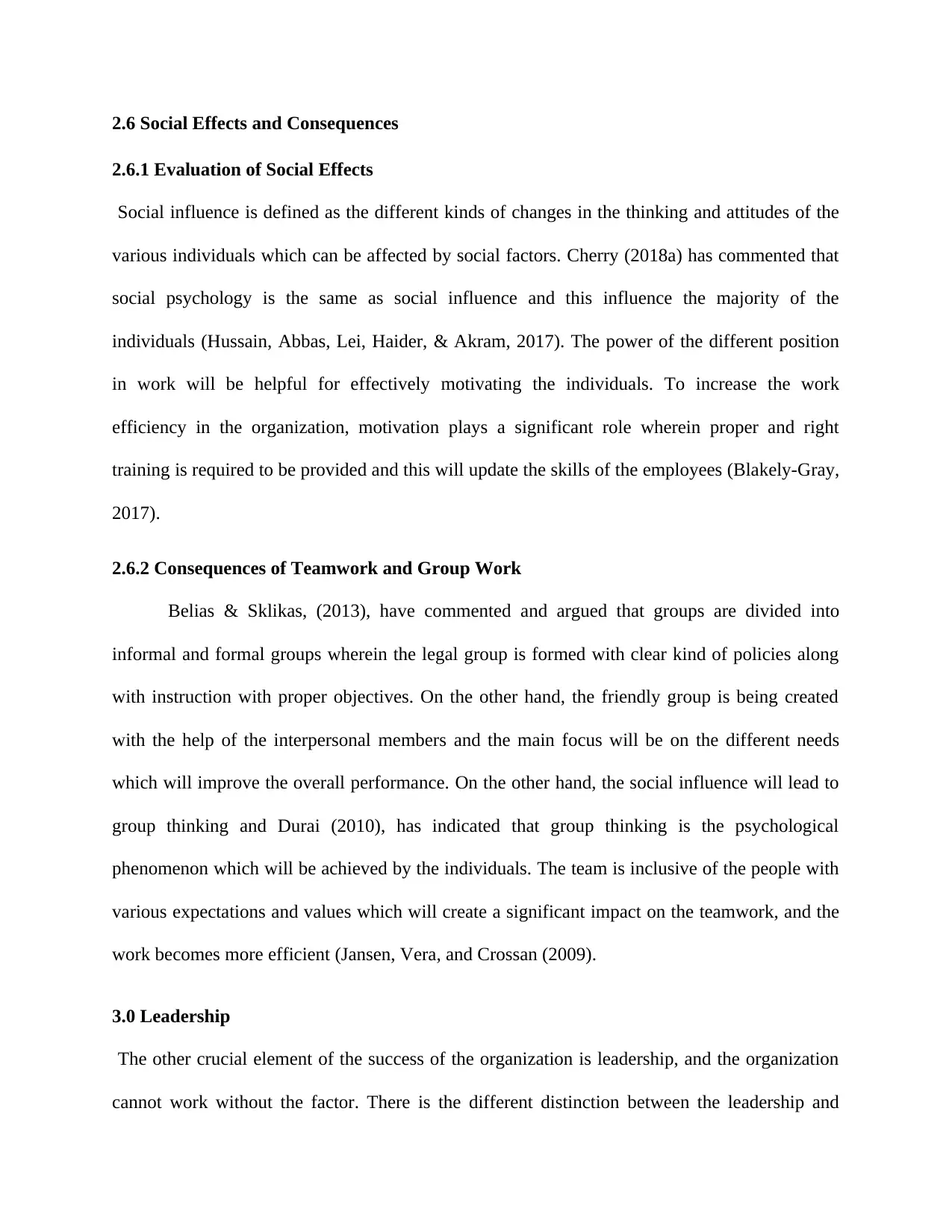
2.6 Social Effects and Consequences
2.6.1 Evaluation of Social Effects
Social influence is defined as the different kinds of changes in the thinking and attitudes of the
various individuals which can be affected by social factors. Cherry (2018a) has commented that
social psychology is the same as social influence and this influence the majority of the
individuals (Hussain, Abbas, Lei, Haider, & Akram, 2017). The power of the different position
in work will be helpful for effectively motivating the individuals. To increase the work
efficiency in the organization, motivation plays a significant role wherein proper and right
training is required to be provided and this will update the skills of the employees (Blakely-Gray,
2017).
2.6.2 Consequences of Teamwork and Group Work
Belias & Sklikas, (2013), have commented and argued that groups are divided into
informal and formal groups wherein the legal group is formed with clear kind of policies along
with instruction with proper objectives. On the other hand, the friendly group is being created
with the help of the interpersonal members and the main focus will be on the different needs
which will improve the overall performance. On the other hand, the social influence will lead to
group thinking and Durai (2010), has indicated that group thinking is the psychological
phenomenon which will be achieved by the individuals. The team is inclusive of the people with
various expectations and values which will create a significant impact on the teamwork, and the
work becomes more efficient (Jansen, Vera, and Crossan (2009).
3.0 Leadership
The other crucial element of the success of the organization is leadership, and the organization
cannot work without the factor. There is the different distinction between the leadership and
2.6.1 Evaluation of Social Effects
Social influence is defined as the different kinds of changes in the thinking and attitudes of the
various individuals which can be affected by social factors. Cherry (2018a) has commented that
social psychology is the same as social influence and this influence the majority of the
individuals (Hussain, Abbas, Lei, Haider, & Akram, 2017). The power of the different position
in work will be helpful for effectively motivating the individuals. To increase the work
efficiency in the organization, motivation plays a significant role wherein proper and right
training is required to be provided and this will update the skills of the employees (Blakely-Gray,
2017).
2.6.2 Consequences of Teamwork and Group Work
Belias & Sklikas, (2013), have commented and argued that groups are divided into
informal and formal groups wherein the legal group is formed with clear kind of policies along
with instruction with proper objectives. On the other hand, the friendly group is being created
with the help of the interpersonal members and the main focus will be on the different needs
which will improve the overall performance. On the other hand, the social influence will lead to
group thinking and Durai (2010), has indicated that group thinking is the psychological
phenomenon which will be achieved by the individuals. The team is inclusive of the people with
various expectations and values which will create a significant impact on the teamwork, and the
work becomes more efficient (Jansen, Vera, and Crossan (2009).
3.0 Leadership
The other crucial element of the success of the organization is leadership, and the organization
cannot work without the factor. There is the different distinction between the leadership and
Secure Best Marks with AI Grader
Need help grading? Try our AI Grader for instant feedback on your assignments.
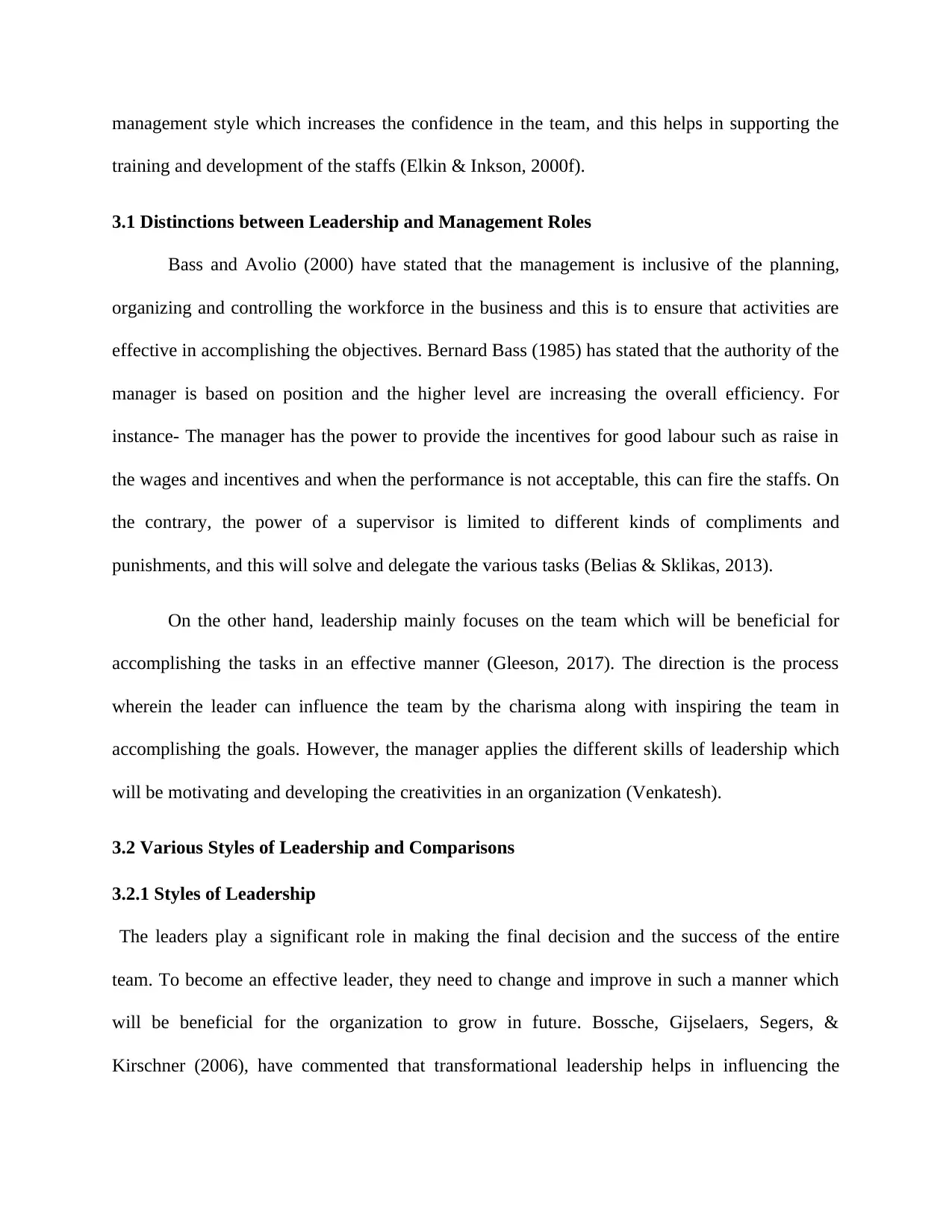
management style which increases the confidence in the team, and this helps in supporting the
training and development of the staffs (Elkin & Inkson, 2000f).
3.1 Distinctions between Leadership and Management Roles
Bass and Avolio (2000) have stated that the management is inclusive of the planning,
organizing and controlling the workforce in the business and this is to ensure that activities are
effective in accomplishing the objectives. Bernard Bass (1985) has stated that the authority of the
manager is based on position and the higher level are increasing the overall efficiency. For
instance- The manager has the power to provide the incentives for good labour such as raise in
the wages and incentives and when the performance is not acceptable, this can fire the staffs. On
the contrary, the power of a supervisor is limited to different kinds of compliments and
punishments, and this will solve and delegate the various tasks (Belias & Sklikas, 2013).
On the other hand, leadership mainly focuses on the team which will be beneficial for
accomplishing the tasks in an effective manner (Gleeson, 2017). The direction is the process
wherein the leader can influence the team by the charisma along with inspiring the team in
accomplishing the goals. However, the manager applies the different skills of leadership which
will be motivating and developing the creativities in an organization (Venkatesh).
3.2 Various Styles of Leadership and Comparisons
3.2.1 Styles of Leadership
The leaders play a significant role in making the final decision and the success of the entire
team. To become an effective leader, they need to change and improve in such a manner which
will be beneficial for the organization to grow in future. Bossche, Gijselaers, Segers, &
Kirschner (2006), have commented that transformational leadership helps in influencing the
training and development of the staffs (Elkin & Inkson, 2000f).
3.1 Distinctions between Leadership and Management Roles
Bass and Avolio (2000) have stated that the management is inclusive of the planning,
organizing and controlling the workforce in the business and this is to ensure that activities are
effective in accomplishing the objectives. Bernard Bass (1985) has stated that the authority of the
manager is based on position and the higher level are increasing the overall efficiency. For
instance- The manager has the power to provide the incentives for good labour such as raise in
the wages and incentives and when the performance is not acceptable, this can fire the staffs. On
the contrary, the power of a supervisor is limited to different kinds of compliments and
punishments, and this will solve and delegate the various tasks (Belias & Sklikas, 2013).
On the other hand, leadership mainly focuses on the team which will be beneficial for
accomplishing the tasks in an effective manner (Gleeson, 2017). The direction is the process
wherein the leader can influence the team by the charisma along with inspiring the team in
accomplishing the goals. However, the manager applies the different skills of leadership which
will be motivating and developing the creativities in an organization (Venkatesh).
3.2 Various Styles of Leadership and Comparisons
3.2.1 Styles of Leadership
The leaders play a significant role in making the final decision and the success of the entire
team. To become an effective leader, they need to change and improve in such a manner which
will be beneficial for the organization to grow in future. Bossche, Gijselaers, Segers, &
Kirschner (2006), have commented that transformational leadership helps in influencing the

attitudes of the different members in the team and this helps in stimulating innovation and
creativity of the staffs which will accurately benefit the organization.
On the other hand, Coy (2013), has commented that transactional leadership focuses on
the roles of the supervisor and this helps in clarifying the needs of the staffs accurately. The
leader in this kind of leadership style uses the rewards and recognition which will help in
satisfying the overall requirements of the teams which will be suitable for the motivation of
employees, and this will help in contributing to participate in the organization (Moga, 2017).
The different characteristics of the leaders working in the organization are being defined
as follows:
Transactional leadership style
The relationship between the leaders and the
members are in exchange
The leaders help in delivering different
rules and procedures (Kulpa, 2015)
Transformational leadership style
The leaders mainly focus on the values
and ideas of the staffs (Doyle, 2018)
The leaders try to imply the plans along
with the vision of the employees (Samiksha)
Table 14: Difference Between Transactional and Transformational Leadership Style
(Source: Samiksha)
3.2.2 Identification and Contrast Skills Required
There are primary four attributes of transformational leadership which are intellectual
stimulation which will help in encouraging employees in showing their creativity. The
individualised consideration is wherein the leaders will promote the staffs, and there is open
communication aspect. The inspirational motivation is wherein the leaders motivate the
creativity of the staffs which will accurately benefit the organization.
On the other hand, Coy (2013), has commented that transactional leadership focuses on
the roles of the supervisor and this helps in clarifying the needs of the staffs accurately. The
leader in this kind of leadership style uses the rewards and recognition which will help in
satisfying the overall requirements of the teams which will be suitable for the motivation of
employees, and this will help in contributing to participate in the organization (Moga, 2017).
The different characteristics of the leaders working in the organization are being defined
as follows:
Transactional leadership style
The relationship between the leaders and the
members are in exchange
The leaders help in delivering different
rules and procedures (Kulpa, 2015)
Transformational leadership style
The leaders mainly focus on the values
and ideas of the staffs (Doyle, 2018)
The leaders try to imply the plans along
with the vision of the employees (Samiksha)
Table 14: Difference Between Transactional and Transformational Leadership Style
(Source: Samiksha)
3.2.2 Identification and Contrast Skills Required
There are primary four attributes of transformational leadership which are intellectual
stimulation which will help in encouraging employees in showing their creativity. The
individualised consideration is wherein the leaders will promote the staffs, and there is open
communication aspect. The inspirational motivation is wherein the leaders motivate the
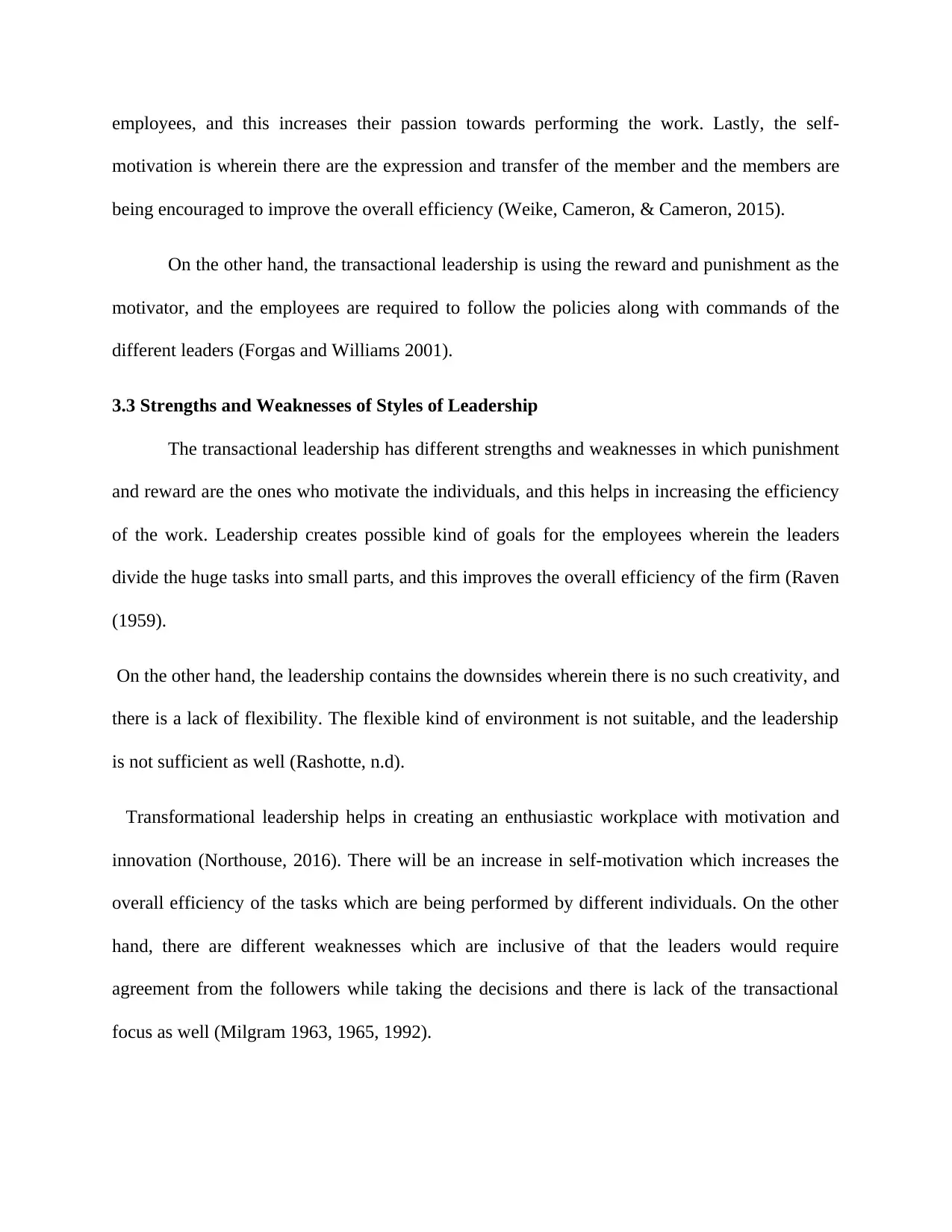
employees, and this increases their passion towards performing the work. Lastly, the self-
motivation is wherein there are the expression and transfer of the member and the members are
being encouraged to improve the overall efficiency (Weike, Cameron, & Cameron, 2015).
On the other hand, the transactional leadership is using the reward and punishment as the
motivator, and the employees are required to follow the policies along with commands of the
different leaders (Forgas and Williams 2001).
3.3 Strengths and Weaknesses of Styles of Leadership
The transactional leadership has different strengths and weaknesses in which punishment
and reward are the ones who motivate the individuals, and this helps in increasing the efficiency
of the work. Leadership creates possible kind of goals for the employees wherein the leaders
divide the huge tasks into small parts, and this improves the overall efficiency of the firm (Raven
(1959).
On the other hand, the leadership contains the downsides wherein there is no such creativity, and
there is a lack of flexibility. The flexible kind of environment is not suitable, and the leadership
is not sufficient as well (Rashotte, n.d).
Transformational leadership helps in creating an enthusiastic workplace with motivation and
innovation (Northouse, 2016). There will be an increase in self-motivation which increases the
overall efficiency of the tasks which are being performed by different individuals. On the other
hand, there are different weaknesses which are inclusive of that the leaders would require
agreement from the followers while taking the decisions and there is lack of the transactional
focus as well (Milgram 1963, 1965, 1992).
motivation is wherein there are the expression and transfer of the member and the members are
being encouraged to improve the overall efficiency (Weike, Cameron, & Cameron, 2015).
On the other hand, the transactional leadership is using the reward and punishment as the
motivator, and the employees are required to follow the policies along with commands of the
different leaders (Forgas and Williams 2001).
3.3 Strengths and Weaknesses of Styles of Leadership
The transactional leadership has different strengths and weaknesses in which punishment
and reward are the ones who motivate the individuals, and this helps in increasing the efficiency
of the work. Leadership creates possible kind of goals for the employees wherein the leaders
divide the huge tasks into small parts, and this improves the overall efficiency of the firm (Raven
(1959).
On the other hand, the leadership contains the downsides wherein there is no such creativity, and
there is a lack of flexibility. The flexible kind of environment is not suitable, and the leadership
is not sufficient as well (Rashotte, n.d).
Transformational leadership helps in creating an enthusiastic workplace with motivation and
innovation (Northouse, 2016). There will be an increase in self-motivation which increases the
overall efficiency of the tasks which are being performed by different individuals. On the other
hand, there are different weaknesses which are inclusive of that the leaders would require
agreement from the followers while taking the decisions and there is lack of the transactional
focus as well (Milgram 1963, 1965, 1992).
Paraphrase This Document
Need a fresh take? Get an instant paraphrase of this document with our AI Paraphraser
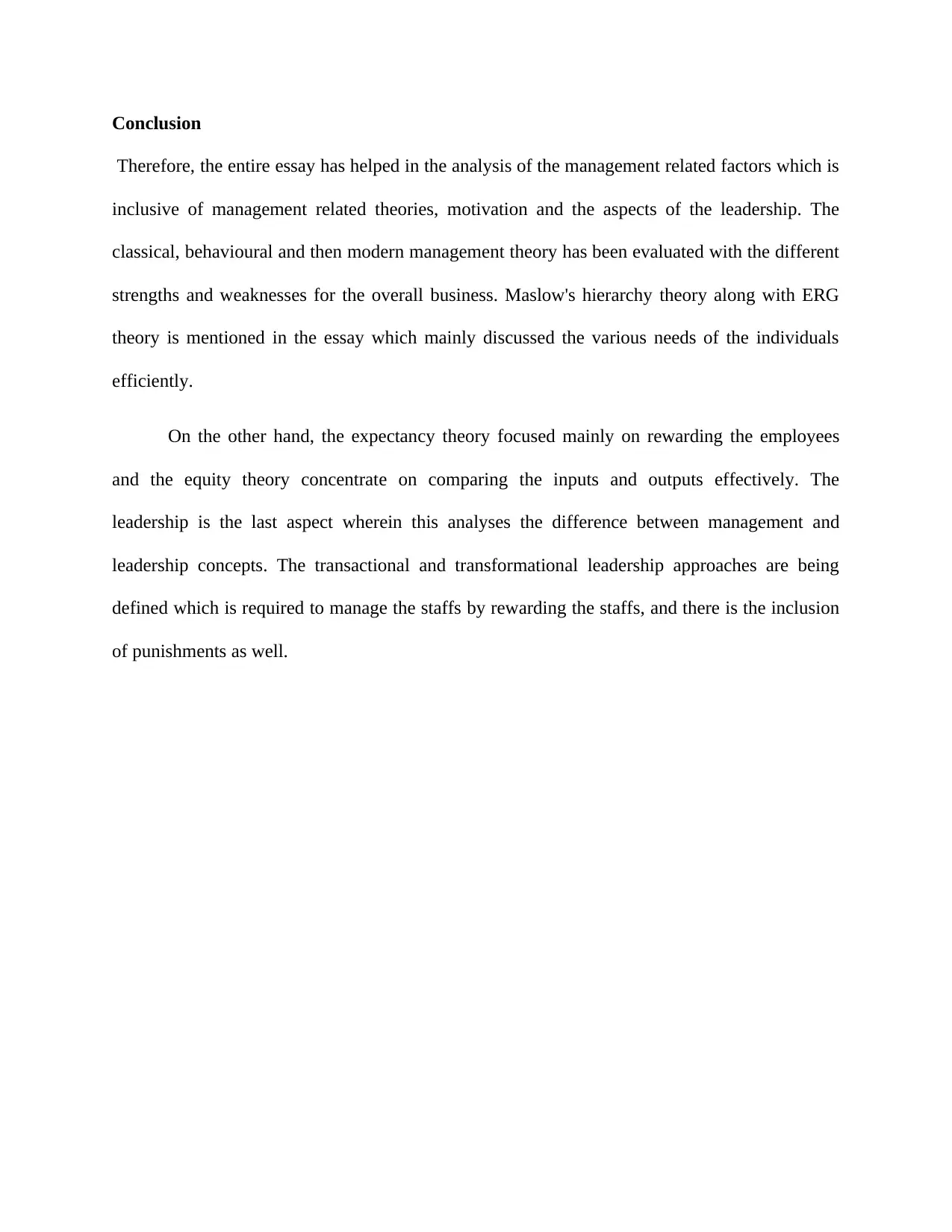
Conclusion
Therefore, the entire essay has helped in the analysis of the management related factors which is
inclusive of management related theories, motivation and the aspects of the leadership. The
classical, behavioural and then modern management theory has been evaluated with the different
strengths and weaknesses for the overall business. Maslow's hierarchy theory along with ERG
theory is mentioned in the essay which mainly discussed the various needs of the individuals
efficiently.
On the other hand, the expectancy theory focused mainly on rewarding the employees
and the equity theory concentrate on comparing the inputs and outputs effectively. The
leadership is the last aspect wherein this analyses the difference between management and
leadership concepts. The transactional and transformational leadership approaches are being
defined which is required to manage the staffs by rewarding the staffs, and there is the inclusion
of punishments as well.
Therefore, the entire essay has helped in the analysis of the management related factors which is
inclusive of management related theories, motivation and the aspects of the leadership. The
classical, behavioural and then modern management theory has been evaluated with the different
strengths and weaknesses for the overall business. Maslow's hierarchy theory along with ERG
theory is mentioned in the essay which mainly discussed the various needs of the individuals
efficiently.
On the other hand, the expectancy theory focused mainly on rewarding the employees
and the equity theory concentrate on comparing the inputs and outputs effectively. The
leadership is the last aspect wherein this analyses the difference between management and
leadership concepts. The transactional and transformational leadership approaches are being
defined which is required to manage the staffs by rewarding the staffs, and there is the inclusion
of punishments as well.

References
Abacus (2018). Management approaches to motivation[PowerPoint presentation]. Retrieved
from CAMS.
Akrani, G. (2011b, 8 6). Criticism of Taylor's Scientific Management - Limitations. Retrieved 11
13, 2018, from Kalyan city life: http://kalyan-city.blogspot.com/2011/06/criticism-of-taylor-
scientific.html
Akrani, G. (2011a, 11 5). Four Principles of Coordination Given By Mary Parker Follett.
Retrieved 11 8, 2018, from Kalyan city life: http://kalyan-city.blogspot.com/2011/05/four-
principles-of-coordination-given.html
Amanchukwu, R. N., Stanley, G. J., & Ololube, N. P. (2015). Leadership styles. A Review of
Leadership Theories, Principles and Styles and Their Relevance to Educational Management ,
10.
Andriotis, N. (2018, 1 8). Want Better Business Results? Involve Your Employees. Retrieved 11
8, 2018, from E front: https://www.efrontlearning.com/blog/2017/12/employee-involvement-
great-business-results.html
Belias, D., & Sklikas, D. (2013). Techniques of job design. Aspects of job design , 86.
Blakely-Gray, R. (2017, 11 27). 5 Advantages and Disadvantages of a Job Rotation Program.
Retrieved 11 14, 2018, from Patriot software:
https://www.patriotsoftware.com/payroll/training/blog/5-advantages-disadvantages-job-rotation-
strategy/
Abacus (2018). Management approaches to motivation[PowerPoint presentation]. Retrieved
from CAMS.
Akrani, G. (2011b, 8 6). Criticism of Taylor's Scientific Management - Limitations. Retrieved 11
13, 2018, from Kalyan city life: http://kalyan-city.blogspot.com/2011/06/criticism-of-taylor-
scientific.html
Akrani, G. (2011a, 11 5). Four Principles of Coordination Given By Mary Parker Follett.
Retrieved 11 8, 2018, from Kalyan city life: http://kalyan-city.blogspot.com/2011/05/four-
principles-of-coordination-given.html
Amanchukwu, R. N., Stanley, G. J., & Ololube, N. P. (2015). Leadership styles. A Review of
Leadership Theories, Principles and Styles and Their Relevance to Educational Management ,
10.
Andriotis, N. (2018, 1 8). Want Better Business Results? Involve Your Employees. Retrieved 11
8, 2018, from E front: https://www.efrontlearning.com/blog/2017/12/employee-involvement-
great-business-results.html
Belias, D., & Sklikas, D. (2013). Techniques of job design. Aspects of job design , 86.
Blakely-Gray, R. (2017, 11 27). 5 Advantages and Disadvantages of a Job Rotation Program.
Retrieved 11 14, 2018, from Patriot software:
https://www.patriotsoftware.com/payroll/training/blog/5-advantages-disadvantages-job-rotation-
strategy/

Blasingame, J. (2015, 8 7). Motivating Employees Is Good Business. Retrieved 11 9, 2018, from
Forbes: https://www.forbes.com/sites/jimblasingame/2015/08/07/motivating-employees-is-good-
business/#12aa0d775ab0
Bossche, P. V., Gijselaers, W. H., Segers, M., & Kirschner, P. A. (2006). Team Learning Beliefs
and Behaviors. Social and Cognitive Factors Driving Teamwork in Collaborative Learning
Environments , 491.
Buvik, A., & John, G. (2000). When Does Vertical Coordination Improve Industrial Purchasing
Relationships? 53.
Caramela, S. (2018, 2 13). Management Theory of Frederick Taylor. Retrieved from Business:
https://www.business.com/articles/management-theory-of-frederick-taylor/
Caramela, S. (2017, 7 4). Techniques and Tools to Help You Make Business Decisions.
Retrieved 11 8, 2018, from Business news daily: https://www.businessnewsdaily.com/6162-
decision-making.html
Caulton, J. R. (2012). The Development and Use of the Theory of ERG: A Literature Review. 2.
Cherry, K. (2017, 5 27). "What Is Transactional Leadership?". Retrieved from Very Well Mind:
https://www.verywellmind.com/what-is-transactional-leadership-2795317
Cherry, K. (2018c, 11 12). "What Is Transformational Leadership?". Retrieved from Very Well
Mind: https://www.verywellmind.com/what-is-transformational-leadership-2795313
Cherry, K. (2018a, 8 29). How to Recognize and Avoid Groupthink. Retrieved from Very Well
Mind: https://www.verywellmind.com/what-is-groupthink-2795213
Forbes: https://www.forbes.com/sites/jimblasingame/2015/08/07/motivating-employees-is-good-
business/#12aa0d775ab0
Bossche, P. V., Gijselaers, W. H., Segers, M., & Kirschner, P. A. (2006). Team Learning Beliefs
and Behaviors. Social and Cognitive Factors Driving Teamwork in Collaborative Learning
Environments , 491.
Buvik, A., & John, G. (2000). When Does Vertical Coordination Improve Industrial Purchasing
Relationships? 53.
Caramela, S. (2018, 2 13). Management Theory of Frederick Taylor. Retrieved from Business:
https://www.business.com/articles/management-theory-of-frederick-taylor/
Caramela, S. (2017, 7 4). Techniques and Tools to Help You Make Business Decisions.
Retrieved 11 8, 2018, from Business news daily: https://www.businessnewsdaily.com/6162-
decision-making.html
Caulton, J. R. (2012). The Development and Use of the Theory of ERG: A Literature Review. 2.
Cherry, K. (2017, 5 27). "What Is Transactional Leadership?". Retrieved from Very Well Mind:
https://www.verywellmind.com/what-is-transactional-leadership-2795317
Cherry, K. (2018c, 11 12). "What Is Transformational Leadership?". Retrieved from Very Well
Mind: https://www.verywellmind.com/what-is-transformational-leadership-2795313
Cherry, K. (2018a, 8 29). How to Recognize and Avoid Groupthink. Retrieved from Very Well
Mind: https://www.verywellmind.com/what-is-groupthink-2795213
Secure Best Marks with AI Grader
Need help grading? Try our AI Grader for instant feedback on your assignments.
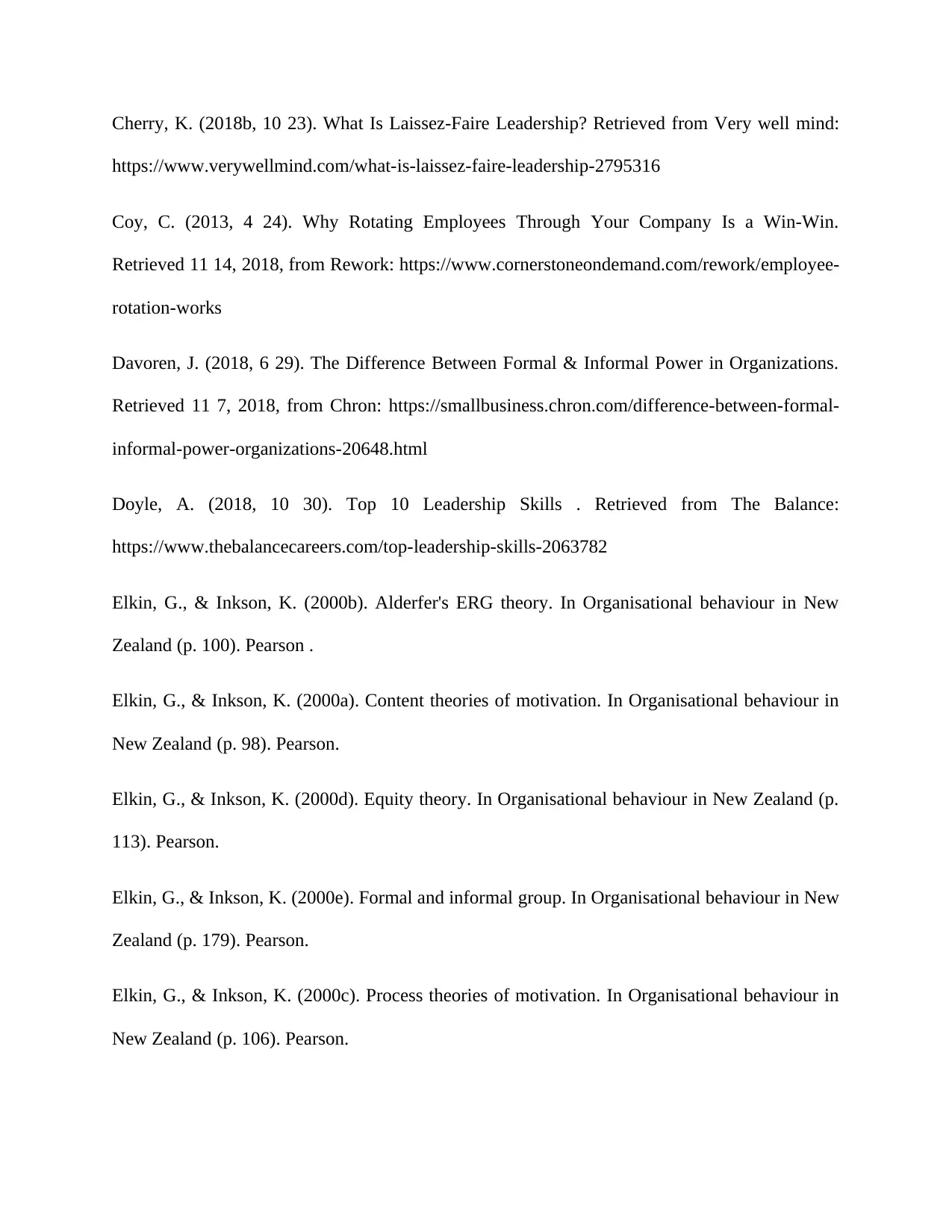
Cherry, K. (2018b, 10 23). What Is Laissez-Faire Leadership? Retrieved from Very well mind:
https://www.verywellmind.com/what-is-laissez-faire-leadership-2795316
Coy, C. (2013, 4 24). Why Rotating Employees Through Your Company Is a Win-Win.
Retrieved 11 14, 2018, from Rework: https://www.cornerstoneondemand.com/rework/employee-
rotation-works
Davoren, J. (2018, 6 29). The Difference Between Formal & Informal Power in Organizations.
Retrieved 11 7, 2018, from Chron: https://smallbusiness.chron.com/difference-between-formal-
informal-power-organizations-20648.html
Doyle, A. (2018, 10 30). Top 10 Leadership Skills . Retrieved from The Balance:
https://www.thebalancecareers.com/top-leadership-skills-2063782
Elkin, G., & Inkson, K. (2000b). Alderfer's ERG theory. In Organisational behaviour in New
Zealand (p. 100). Pearson .
Elkin, G., & Inkson, K. (2000a). Content theories of motivation. In Organisational behaviour in
New Zealand (p. 98). Pearson.
Elkin, G., & Inkson, K. (2000d). Equity theory. In Organisational behaviour in New Zealand (p.
113). Pearson.
Elkin, G., & Inkson, K. (2000e). Formal and informal group. In Organisational behaviour in New
Zealand (p. 179). Pearson.
Elkin, G., & Inkson, K. (2000c). Process theories of motivation. In Organisational behaviour in
New Zealand (p. 106). Pearson.
https://www.verywellmind.com/what-is-laissez-faire-leadership-2795316
Coy, C. (2013, 4 24). Why Rotating Employees Through Your Company Is a Win-Win.
Retrieved 11 14, 2018, from Rework: https://www.cornerstoneondemand.com/rework/employee-
rotation-works
Davoren, J. (2018, 6 29). The Difference Between Formal & Informal Power in Organizations.
Retrieved 11 7, 2018, from Chron: https://smallbusiness.chron.com/difference-between-formal-
informal-power-organizations-20648.html
Doyle, A. (2018, 10 30). Top 10 Leadership Skills . Retrieved from The Balance:
https://www.thebalancecareers.com/top-leadership-skills-2063782
Elkin, G., & Inkson, K. (2000b). Alderfer's ERG theory. In Organisational behaviour in New
Zealand (p. 100). Pearson .
Elkin, G., & Inkson, K. (2000a). Content theories of motivation. In Organisational behaviour in
New Zealand (p. 98). Pearson.
Elkin, G., & Inkson, K. (2000d). Equity theory. In Organisational behaviour in New Zealand (p.
113). Pearson.
Elkin, G., & Inkson, K. (2000e). Formal and informal group. In Organisational behaviour in New
Zealand (p. 179). Pearson.
Elkin, G., & Inkson, K. (2000c). Process theories of motivation. In Organisational behaviour in
New Zealand (p. 106). Pearson.
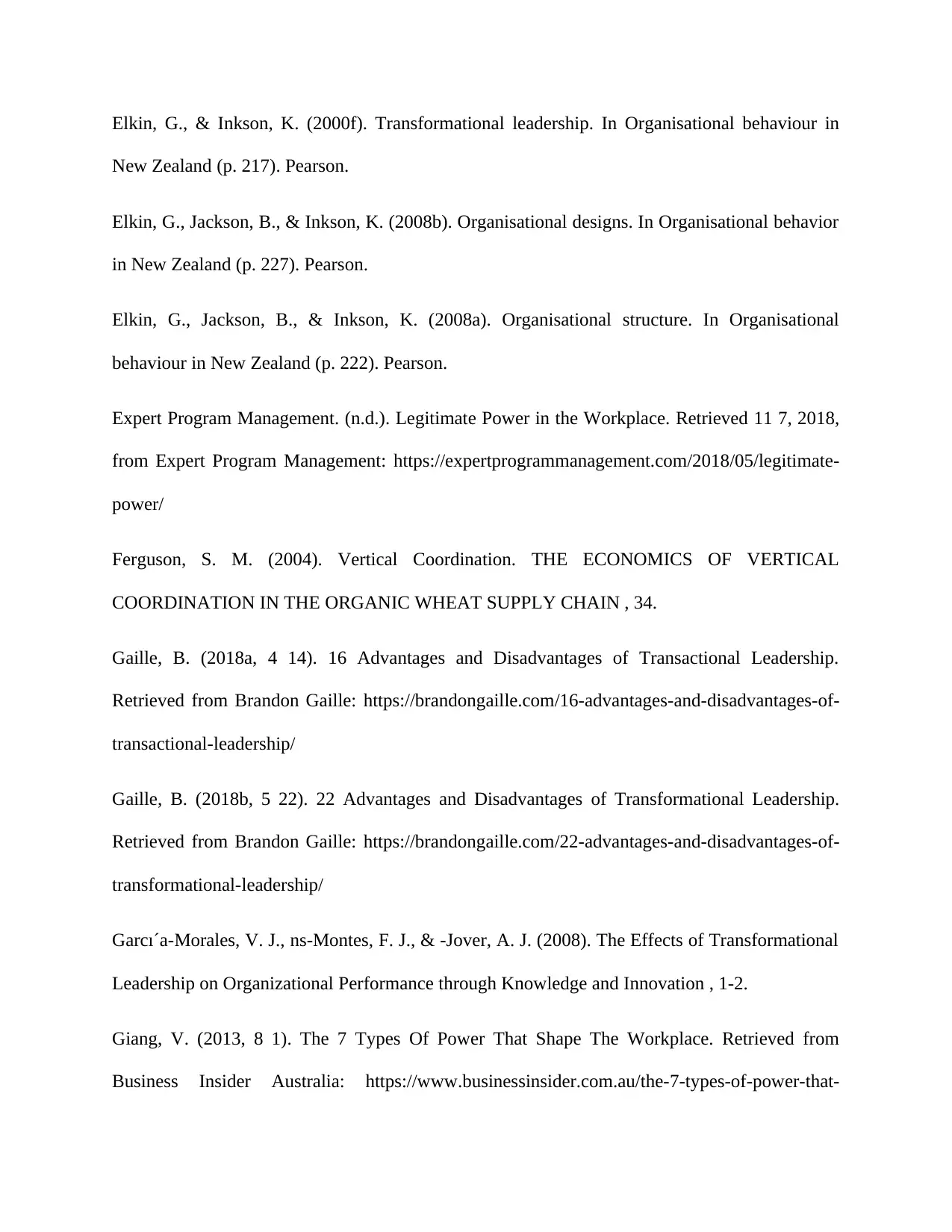
Elkin, G., & Inkson, K. (2000f). Transformational leadership. In Organisational behaviour in
New Zealand (p. 217). Pearson.
Elkin, G., Jackson, B., & Inkson, K. (2008b). Organisational designs. In Organisational behavior
in New Zealand (p. 227). Pearson.
Elkin, G., Jackson, B., & Inkson, K. (2008a). Organisational structure. In Organisational
behaviour in New Zealand (p. 222). Pearson.
Expert Program Management. (n.d.). Legitimate Power in the Workplace. Retrieved 11 7, 2018,
from Expert Program Management: https://expertprogrammanagement.com/2018/05/legitimate-
power/
Ferguson, S. M. (2004). Vertical Coordination. THE ECONOMICS OF VERTICAL
COORDINATION IN THE ORGANIC WHEAT SUPPLY CHAIN , 34.
Gaille, B. (2018a, 4 14). 16 Advantages and Disadvantages of Transactional Leadership.
Retrieved from Brandon Gaille: https://brandongaille.com/16-advantages-and-disadvantages-of-
transactional-leadership/
Gaille, B. (2018b, 5 22). 22 Advantages and Disadvantages of Transformational Leadership.
Retrieved from Brandon Gaille: https://brandongaille.com/22-advantages-and-disadvantages-of-
transformational-leadership/
Garcı´a-Morales, V. J., ns-Montes, F. J., & -Jover, A. J. (2008). The Effects of Transformational
Leadership on Organizational Performance through Knowledge and Innovation , 1-2.
Giang, V. (2013, 8 1). The 7 Types Of Power That Shape The Workplace. Retrieved from
Business Insider Australia: https://www.businessinsider.com.au/the-7-types-of-power-that-
New Zealand (p. 217). Pearson.
Elkin, G., Jackson, B., & Inkson, K. (2008b). Organisational designs. In Organisational behavior
in New Zealand (p. 227). Pearson.
Elkin, G., Jackson, B., & Inkson, K. (2008a). Organisational structure. In Organisational
behaviour in New Zealand (p. 222). Pearson.
Expert Program Management. (n.d.). Legitimate Power in the Workplace. Retrieved 11 7, 2018,
from Expert Program Management: https://expertprogrammanagement.com/2018/05/legitimate-
power/
Ferguson, S. M. (2004). Vertical Coordination. THE ECONOMICS OF VERTICAL
COORDINATION IN THE ORGANIC WHEAT SUPPLY CHAIN , 34.
Gaille, B. (2018a, 4 14). 16 Advantages and Disadvantages of Transactional Leadership.
Retrieved from Brandon Gaille: https://brandongaille.com/16-advantages-and-disadvantages-of-
transactional-leadership/
Gaille, B. (2018b, 5 22). 22 Advantages and Disadvantages of Transformational Leadership.
Retrieved from Brandon Gaille: https://brandongaille.com/22-advantages-and-disadvantages-of-
transformational-leadership/
Garcı´a-Morales, V. J., ns-Montes, F. J., & -Jover, A. J. (2008). The Effects of Transformational
Leadership on Organizational Performance through Knowledge and Innovation , 1-2.
Giang, V. (2013, 8 1). The 7 Types Of Power That Shape The Workplace. Retrieved from
Business Insider Australia: https://www.businessinsider.com.au/the-7-types-of-power-that-
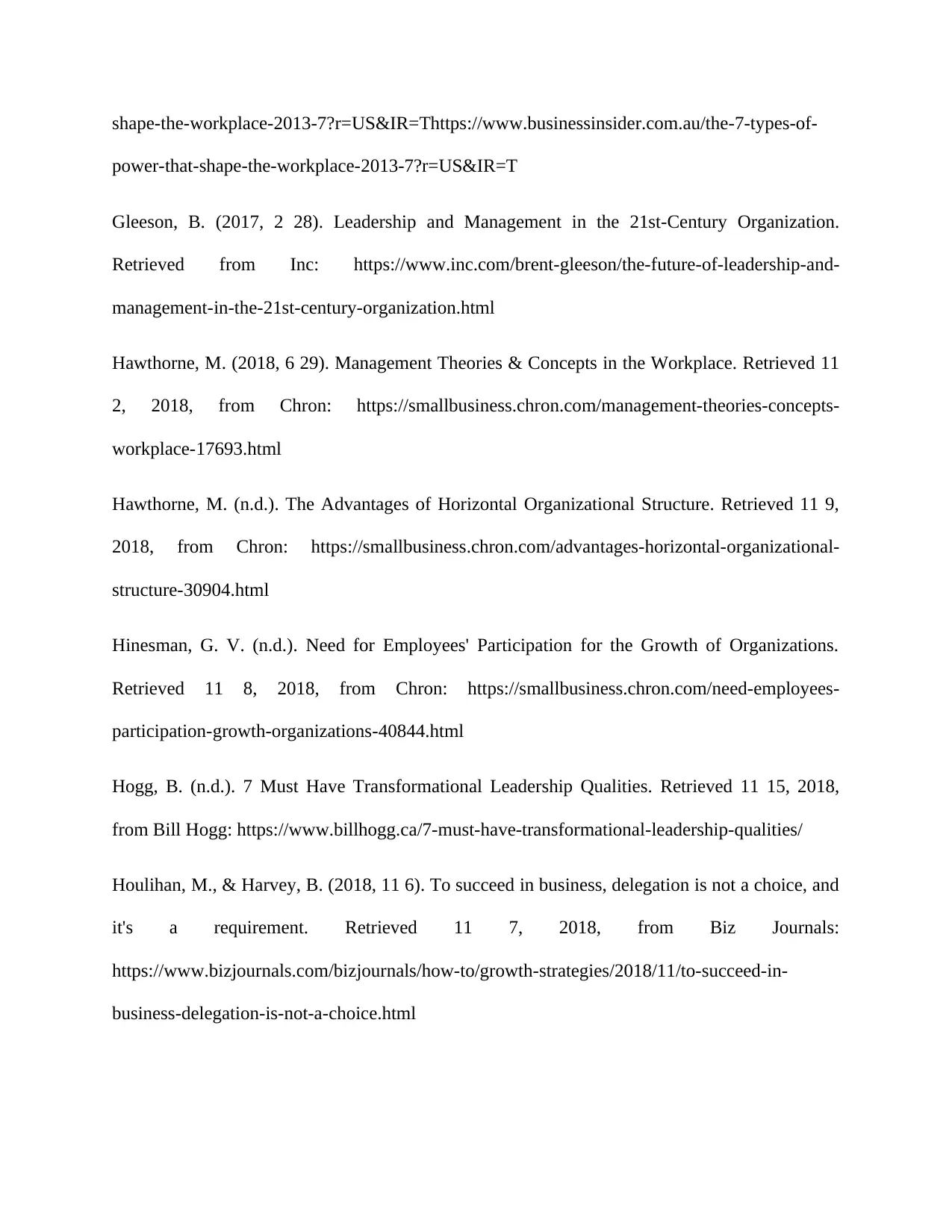
shape-the-workplace-2013-7?r=US&IR=Thttps://www.businessinsider.com.au/the-7-types-of-
power-that-shape-the-workplace-2013-7?r=US&IR=T
Gleeson, B. (2017, 2 28). Leadership and Management in the 21st-Century Organization.
Retrieved from Inc: https://www.inc.com/brent-gleeson/the-future-of-leadership-and-
management-in-the-21st-century-organization.html
Hawthorne, M. (2018, 6 29). Management Theories & Concepts in the Workplace. Retrieved 11
2, 2018, from Chron: https://smallbusiness.chron.com/management-theories-concepts-
workplace-17693.html
Hawthorne, M. (n.d.). The Advantages of Horizontal Organizational Structure. Retrieved 11 9,
2018, from Chron: https://smallbusiness.chron.com/advantages-horizontal-organizational-
structure-30904.html
Hinesman, G. V. (n.d.). Need for Employees' Participation for the Growth of Organizations.
Retrieved 11 8, 2018, from Chron: https://smallbusiness.chron.com/need-employees-
participation-growth-organizations-40844.html
Hogg, B. (n.d.). 7 Must Have Transformational Leadership Qualities. Retrieved 11 15, 2018,
from Bill Hogg: https://www.billhogg.ca/7-must-have-transformational-leadership-qualities/
Houlihan, M., & Harvey, B. (2018, 11 6). To succeed in business, delegation is not a choice, and
it's a requirement. Retrieved 11 7, 2018, from Biz Journals:
https://www.bizjournals.com/bizjournals/how-to/growth-strategies/2018/11/to-succeed-in-
business-delegation-is-not-a-choice.html
power-that-shape-the-workplace-2013-7?r=US&IR=T
Gleeson, B. (2017, 2 28). Leadership and Management in the 21st-Century Organization.
Retrieved from Inc: https://www.inc.com/brent-gleeson/the-future-of-leadership-and-
management-in-the-21st-century-organization.html
Hawthorne, M. (2018, 6 29). Management Theories & Concepts in the Workplace. Retrieved 11
2, 2018, from Chron: https://smallbusiness.chron.com/management-theories-concepts-
workplace-17693.html
Hawthorne, M. (n.d.). The Advantages of Horizontal Organizational Structure. Retrieved 11 9,
2018, from Chron: https://smallbusiness.chron.com/advantages-horizontal-organizational-
structure-30904.html
Hinesman, G. V. (n.d.). Need for Employees' Participation for the Growth of Organizations.
Retrieved 11 8, 2018, from Chron: https://smallbusiness.chron.com/need-employees-
participation-growth-organizations-40844.html
Hogg, B. (n.d.). 7 Must Have Transformational Leadership Qualities. Retrieved 11 15, 2018,
from Bill Hogg: https://www.billhogg.ca/7-must-have-transformational-leadership-qualities/
Houlihan, M., & Harvey, B. (2018, 11 6). To succeed in business, delegation is not a choice, and
it's a requirement. Retrieved 11 7, 2018, from Biz Journals:
https://www.bizjournals.com/bizjournals/how-to/growth-strategies/2018/11/to-succeed-in-
business-delegation-is-not-a-choice.html
Paraphrase This Document
Need a fresh take? Get an instant paraphrase of this document with our AI Paraphraser
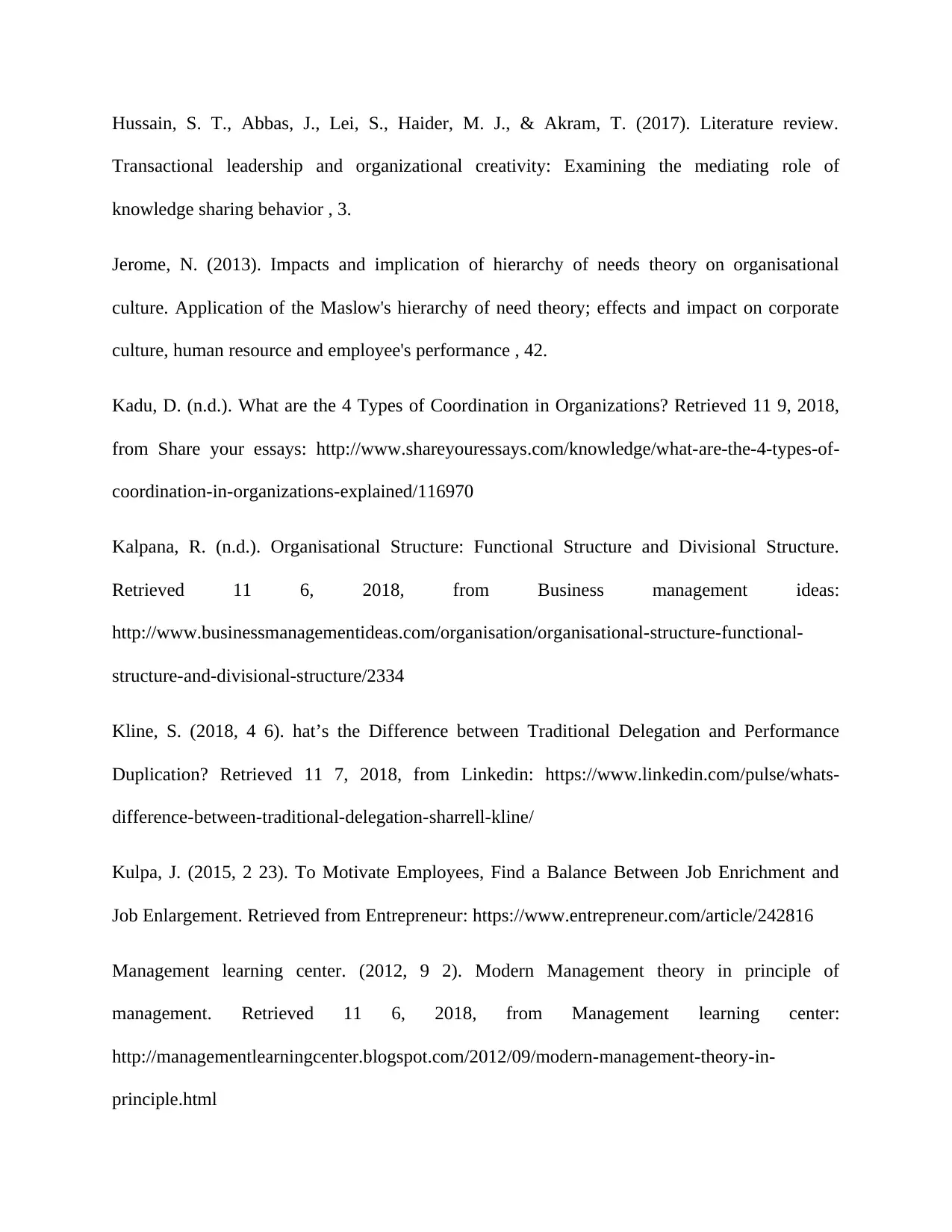
Hussain, S. T., Abbas, J., Lei, S., Haider, M. J., & Akram, T. (2017). Literature review.
Transactional leadership and organizational creativity: Examining the mediating role of
knowledge sharing behavior , 3.
Jerome, N. (2013). Impacts and implication of hierarchy of needs theory on organisational
culture. Application of the Maslow's hierarchy of need theory; effects and impact on corporate
culture, human resource and employee's performance , 42.
Kadu, D. (n.d.). What are the 4 Types of Coordination in Organizations? Retrieved 11 9, 2018,
from Share your essays: http://www.shareyouressays.com/knowledge/what-are-the-4-types-of-
coordination-in-organizations-explained/116970
Kalpana, R. (n.d.). Organisational Structure: Functional Structure and Divisional Structure.
Retrieved 11 6, 2018, from Business management ideas:
http://www.businessmanagementideas.com/organisation/organisational-structure-functional-
structure-and-divisional-structure/2334
Kline, S. (2018, 4 6). hat’s the Difference between Traditional Delegation and Performance
Duplication? Retrieved 11 7, 2018, from Linkedin: https://www.linkedin.com/pulse/whats-
difference-between-traditional-delegation-sharrell-kline/
Kulpa, J. (2015, 2 23). To Motivate Employees, Find a Balance Between Job Enrichment and
Job Enlargement. Retrieved from Entrepreneur: https://www.entrepreneur.com/article/242816
Management learning center. (2012, 9 2). Modern Management theory in principle of
management. Retrieved 11 6, 2018, from Management learning center:
http://managementlearningcenter.blogspot.com/2012/09/modern-management-theory-in-
principle.html
Transactional leadership and organizational creativity: Examining the mediating role of
knowledge sharing behavior , 3.
Jerome, N. (2013). Impacts and implication of hierarchy of needs theory on organisational
culture. Application of the Maslow's hierarchy of need theory; effects and impact on corporate
culture, human resource and employee's performance , 42.
Kadu, D. (n.d.). What are the 4 Types of Coordination in Organizations? Retrieved 11 9, 2018,
from Share your essays: http://www.shareyouressays.com/knowledge/what-are-the-4-types-of-
coordination-in-organizations-explained/116970
Kalpana, R. (n.d.). Organisational Structure: Functional Structure and Divisional Structure.
Retrieved 11 6, 2018, from Business management ideas:
http://www.businessmanagementideas.com/organisation/organisational-structure-functional-
structure-and-divisional-structure/2334
Kline, S. (2018, 4 6). hat’s the Difference between Traditional Delegation and Performance
Duplication? Retrieved 11 7, 2018, from Linkedin: https://www.linkedin.com/pulse/whats-
difference-between-traditional-delegation-sharrell-kline/
Kulpa, J. (2015, 2 23). To Motivate Employees, Find a Balance Between Job Enrichment and
Job Enlargement. Retrieved from Entrepreneur: https://www.entrepreneur.com/article/242816
Management learning center. (2012, 9 2). Modern Management theory in principle of
management. Retrieved 11 6, 2018, from Management learning center:
http://managementlearningcenter.blogspot.com/2012/09/modern-management-theory-in-
principle.html
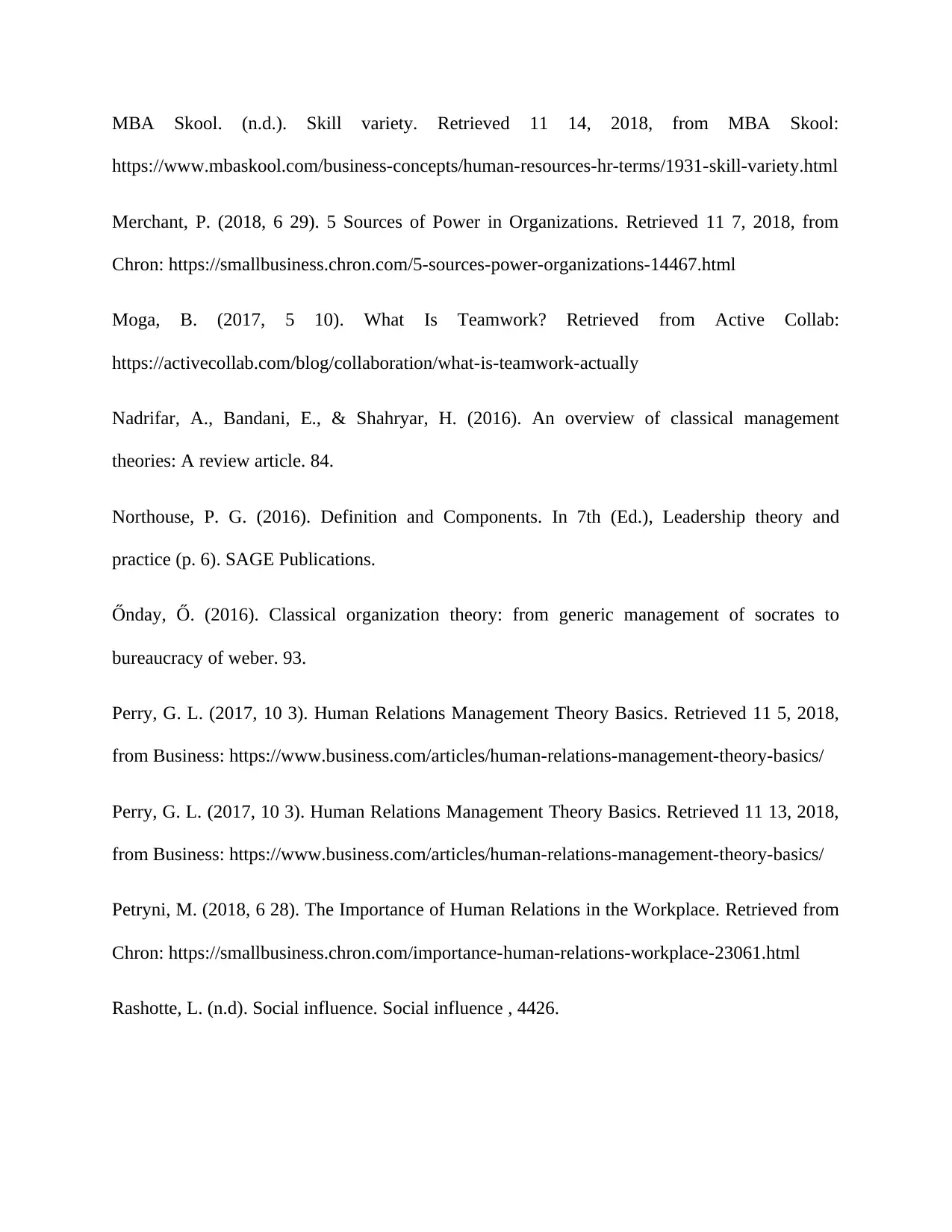
MBA Skool. (n.d.). Skill variety. Retrieved 11 14, 2018, from MBA Skool:
https://www.mbaskool.com/business-concepts/human-resources-hr-terms/1931-skill-variety.html
Merchant, P. (2018, 6 29). 5 Sources of Power in Organizations. Retrieved 11 7, 2018, from
Chron: https://smallbusiness.chron.com/5-sources-power-organizations-14467.html
Moga, B. (2017, 5 10). What Is Teamwork? Retrieved from Active Collab:
https://activecollab.com/blog/collaboration/what-is-teamwork-actually
Nadrifar, A., Bandani, E., & Shahryar, H. (2016). An overview of classical management
theories: A review article. 84.
Northouse, P. G. (2016). Definition and Components. In 7th (Ed.), Leadership theory and
practice (p. 6). SAGE Publications.
Őnday, Ő. (2016). Classical organization theory: from generic management of socrates to
bureaucracy of weber. 93.
Perry, G. L. (2017, 10 3). Human Relations Management Theory Basics. Retrieved 11 5, 2018,
from Business: https://www.business.com/articles/human-relations-management-theory-basics/
Perry, G. L. (2017, 10 3). Human Relations Management Theory Basics. Retrieved 11 13, 2018,
from Business: https://www.business.com/articles/human-relations-management-theory-basics/
Petryni, M. (2018, 6 28). The Importance of Human Relations in the Workplace. Retrieved from
Chron: https://smallbusiness.chron.com/importance-human-relations-workplace-23061.html
Rashotte, L. (n.d). Social influence. Social influence , 4426.
https://www.mbaskool.com/business-concepts/human-resources-hr-terms/1931-skill-variety.html
Merchant, P. (2018, 6 29). 5 Sources of Power in Organizations. Retrieved 11 7, 2018, from
Chron: https://smallbusiness.chron.com/5-sources-power-organizations-14467.html
Moga, B. (2017, 5 10). What Is Teamwork? Retrieved from Active Collab:
https://activecollab.com/blog/collaboration/what-is-teamwork-actually
Nadrifar, A., Bandani, E., & Shahryar, H. (2016). An overview of classical management
theories: A review article. 84.
Northouse, P. G. (2016). Definition and Components. In 7th (Ed.), Leadership theory and
practice (p. 6). SAGE Publications.
Őnday, Ő. (2016). Classical organization theory: from generic management of socrates to
bureaucracy of weber. 93.
Perry, G. L. (2017, 10 3). Human Relations Management Theory Basics. Retrieved 11 5, 2018,
from Business: https://www.business.com/articles/human-relations-management-theory-basics/
Perry, G. L. (2017, 10 3). Human Relations Management Theory Basics. Retrieved 11 13, 2018,
from Business: https://www.business.com/articles/human-relations-management-theory-basics/
Petryni, M. (2018, 6 28). The Importance of Human Relations in the Workplace. Retrieved from
Chron: https://smallbusiness.chron.com/importance-human-relations-workplace-23061.html
Rashotte, L. (n.d). Social influence. Social influence , 4426.

Robert, C. (2017, 9 26). The Importance of Modern Management Theories in Managing People.
Retrieved 11 6, 2018, from Bizfluent: https://bizfluent.com/info-8419159-importance-
management-theories-managing-people.html
Root, G. N. (n.d.). How Managers With Different Leadership Styles Motivate Their Teams.
Retrieved 11 13, 2018, from Chron: https://smallbusiness.chron.com/managers-different-
leadership-styles-motivate-teams-10823.html
Root, G. N. (n.d.). In what four ways do organizations benefit from team decision making?
Retrieved 11 8, 2018, from Chron: https://smallbusiness.chron.com/four-ways-organizations-
benefit-team-decision-making-19001.html
Samiksha. (n.d.). What is the Importance of Leadership in any Organisation? Retrieved 11 17,
2018, from Your article library: http://www.yourarticlelibrary.com/leadership/what-is-the-
importance-of-leadership-in-any-organisation/1014
Shaeffer, L. D. (2014, 11 25). What is Autocratic Leadership? How Procedures Can Improve
Efficiency. Retrieved from St. Thomas University:
https://online.stu.edu/articles/education/autocratic-leadership.aspx
Sharma, P. (n.d.). Elton Mayo’s Human Relations Approach to Management. Retrieved 11 5,
2018, from Your article library: http://www.yourarticlelibrary.com/management/elton-mayos-
human-relations-approach-to-management/70014
Shinde, S. V. (2018). Functions of Management. Laxmi Book .
Retrieved 11 6, 2018, from Bizfluent: https://bizfluent.com/info-8419159-importance-
management-theories-managing-people.html
Root, G. N. (n.d.). How Managers With Different Leadership Styles Motivate Their Teams.
Retrieved 11 13, 2018, from Chron: https://smallbusiness.chron.com/managers-different-
leadership-styles-motivate-teams-10823.html
Root, G. N. (n.d.). In what four ways do organizations benefit from team decision making?
Retrieved 11 8, 2018, from Chron: https://smallbusiness.chron.com/four-ways-organizations-
benefit-team-decision-making-19001.html
Samiksha. (n.d.). What is the Importance of Leadership in any Organisation? Retrieved 11 17,
2018, from Your article library: http://www.yourarticlelibrary.com/leadership/what-is-the-
importance-of-leadership-in-any-organisation/1014
Shaeffer, L. D. (2014, 11 25). What is Autocratic Leadership? How Procedures Can Improve
Efficiency. Retrieved from St. Thomas University:
https://online.stu.edu/articles/education/autocratic-leadership.aspx
Sharma, P. (n.d.). Elton Mayo’s Human Relations Approach to Management. Retrieved 11 5,
2018, from Your article library: http://www.yourarticlelibrary.com/management/elton-mayos-
human-relations-approach-to-management/70014
Shinde, S. V. (2018). Functions of Management. Laxmi Book .
Secure Best Marks with AI Grader
Need help grading? Try our AI Grader for instant feedback on your assignments.
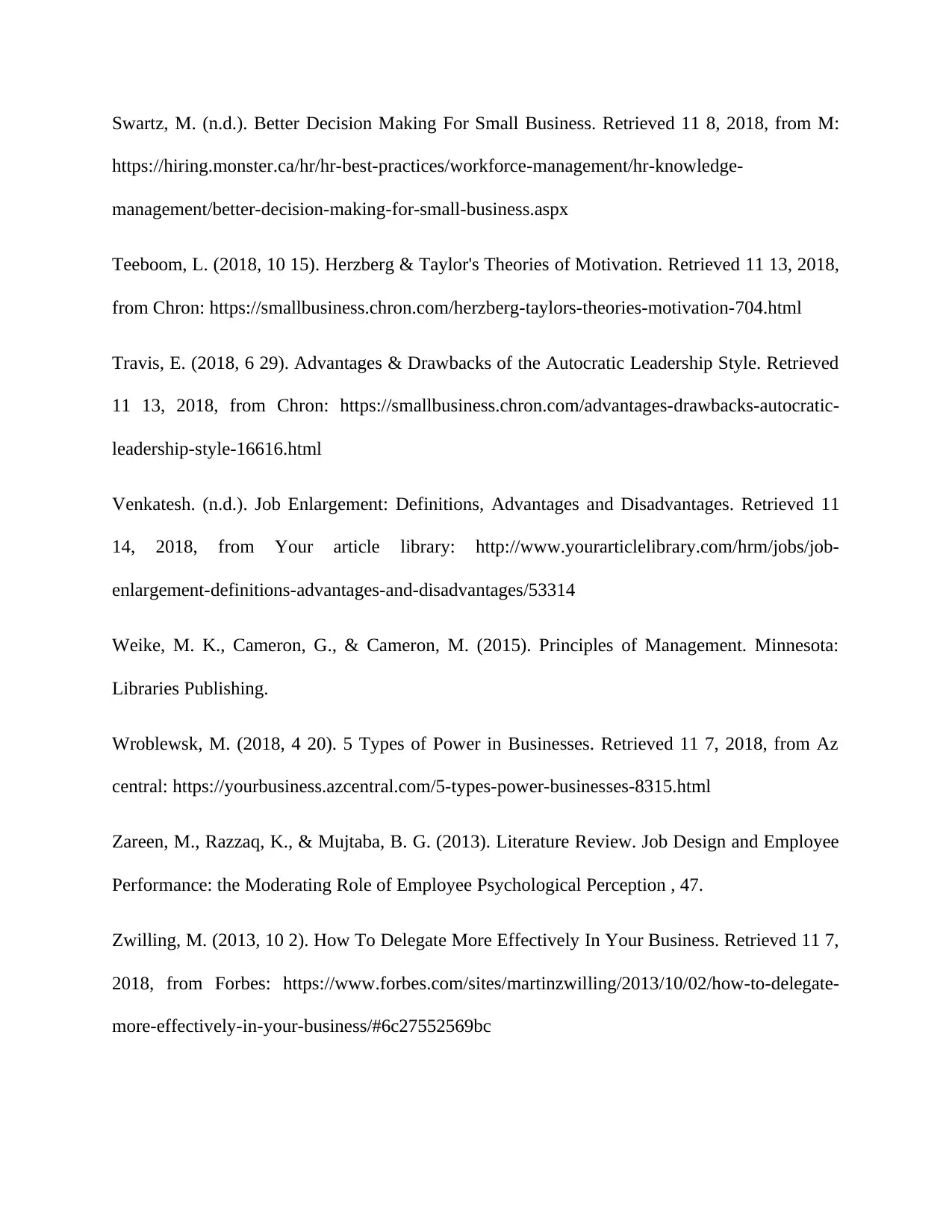
Swartz, M. (n.d.). Better Decision Making For Small Business. Retrieved 11 8, 2018, from M:
https://hiring.monster.ca/hr/hr-best-practices/workforce-management/hr-knowledge-
management/better-decision-making-for-small-business.aspx
Teeboom, L. (2018, 10 15). Herzberg & Taylor's Theories of Motivation. Retrieved 11 13, 2018,
from Chron: https://smallbusiness.chron.com/herzberg-taylors-theories-motivation-704.html
Travis, E. (2018, 6 29). Advantages & Drawbacks of the Autocratic Leadership Style. Retrieved
11 13, 2018, from Chron: https://smallbusiness.chron.com/advantages-drawbacks-autocratic-
leadership-style-16616.html
Venkatesh. (n.d.). Job Enlargement: Definitions, Advantages and Disadvantages. Retrieved 11
14, 2018, from Your article library: http://www.yourarticlelibrary.com/hrm/jobs/job-
enlargement-definitions-advantages-and-disadvantages/53314
Weike, M. K., Cameron, G., & Cameron, M. (2015). Principles of Management. Minnesota:
Libraries Publishing.
Wroblewsk, M. (2018, 4 20). 5 Types of Power in Businesses. Retrieved 11 7, 2018, from Az
central: https://yourbusiness.azcentral.com/5-types-power-businesses-8315.html
Zareen, M., Razzaq, K., & Mujtaba, B. G. (2013). Literature Review. Job Design and Employee
Performance: the Moderating Role of Employee Psychological Perception , 47.
Zwilling, M. (2013, 10 2). How To Delegate More Effectively In Your Business. Retrieved 11 7,
2018, from Forbes: https://www.forbes.com/sites/martinzwilling/2013/10/02/how-to-delegate-
more-effectively-in-your-business/#6c27552569bc
https://hiring.monster.ca/hr/hr-best-practices/workforce-management/hr-knowledge-
management/better-decision-making-for-small-business.aspx
Teeboom, L. (2018, 10 15). Herzberg & Taylor's Theories of Motivation. Retrieved 11 13, 2018,
from Chron: https://smallbusiness.chron.com/herzberg-taylors-theories-motivation-704.html
Travis, E. (2018, 6 29). Advantages & Drawbacks of the Autocratic Leadership Style. Retrieved
11 13, 2018, from Chron: https://smallbusiness.chron.com/advantages-drawbacks-autocratic-
leadership-style-16616.html
Venkatesh. (n.d.). Job Enlargement: Definitions, Advantages and Disadvantages. Retrieved 11
14, 2018, from Your article library: http://www.yourarticlelibrary.com/hrm/jobs/job-
enlargement-definitions-advantages-and-disadvantages/53314
Weike, M. K., Cameron, G., & Cameron, M. (2015). Principles of Management. Minnesota:
Libraries Publishing.
Wroblewsk, M. (2018, 4 20). 5 Types of Power in Businesses. Retrieved 11 7, 2018, from Az
central: https://yourbusiness.azcentral.com/5-types-power-businesses-8315.html
Zareen, M., Razzaq, K., & Mujtaba, B. G. (2013). Literature Review. Job Design and Employee
Performance: the Moderating Role of Employee Psychological Perception , 47.
Zwilling, M. (2013, 10 2). How To Delegate More Effectively In Your Business. Retrieved 11 7,
2018, from Forbes: https://www.forbes.com/sites/martinzwilling/2013/10/02/how-to-delegate-
more-effectively-in-your-business/#6c27552569bc

1 out of 48
Related Documents
Your All-in-One AI-Powered Toolkit for Academic Success.
+13062052269
info@desklib.com
Available 24*7 on WhatsApp / Email
![[object Object]](/_next/static/media/star-bottom.7253800d.svg)
Unlock your academic potential
© 2024 | Zucol Services PVT LTD | All rights reserved.



